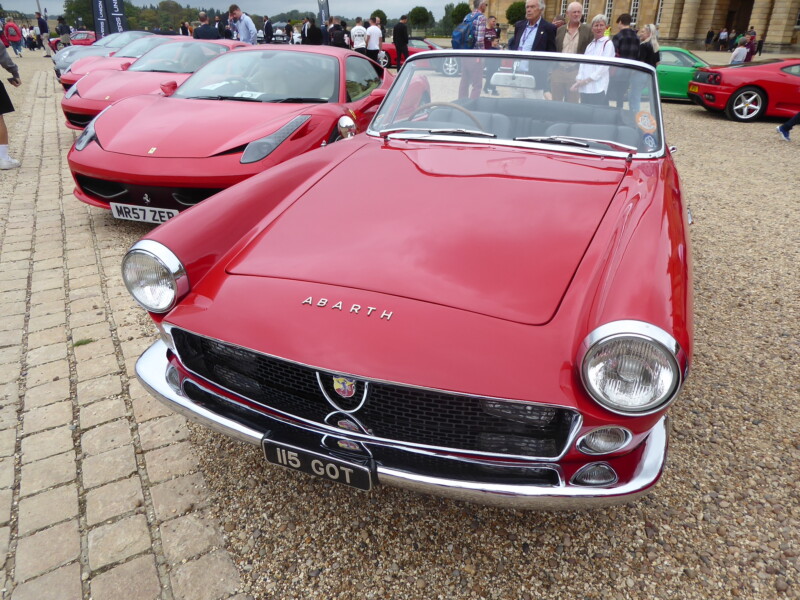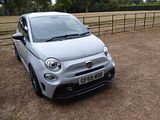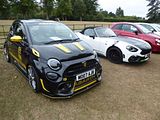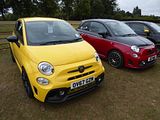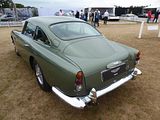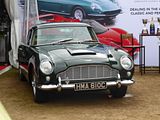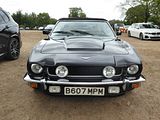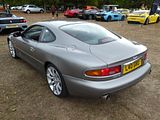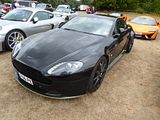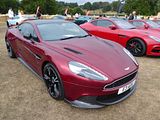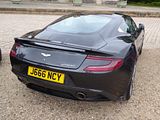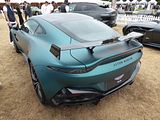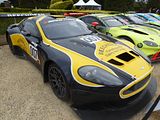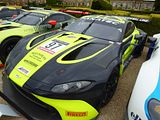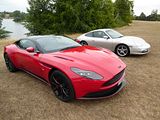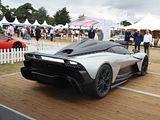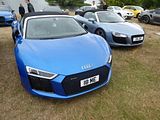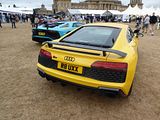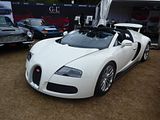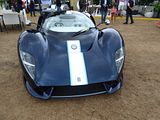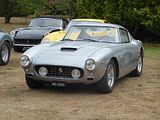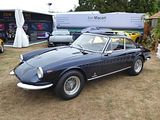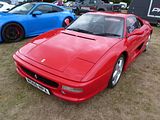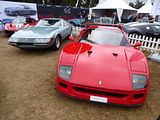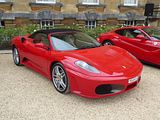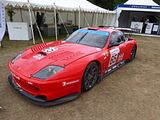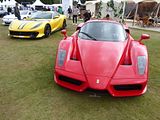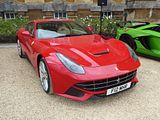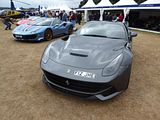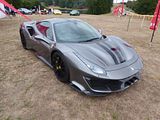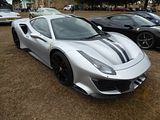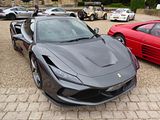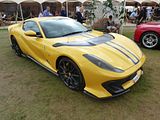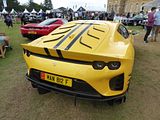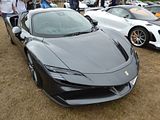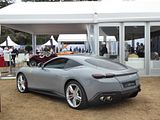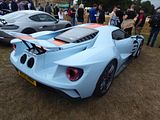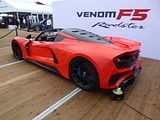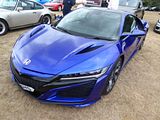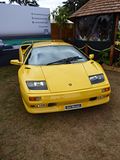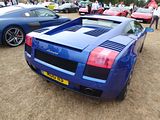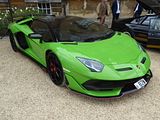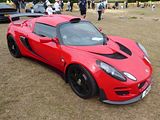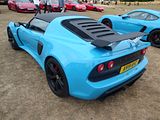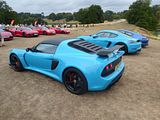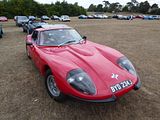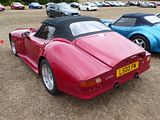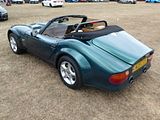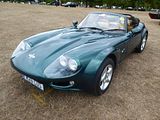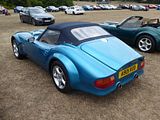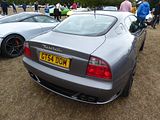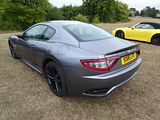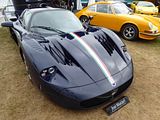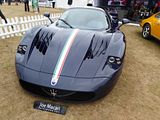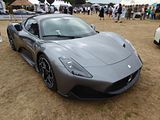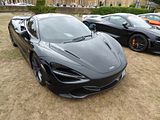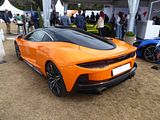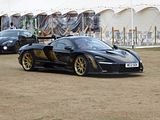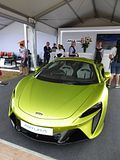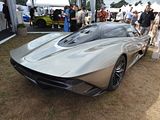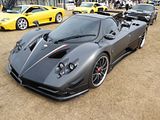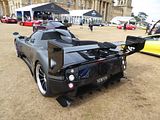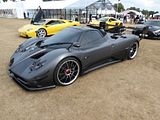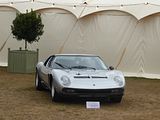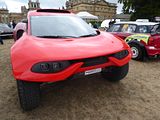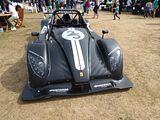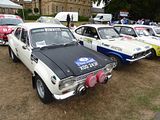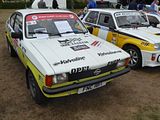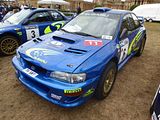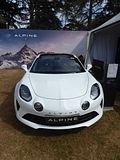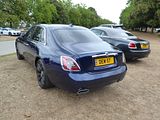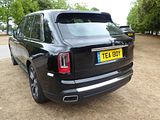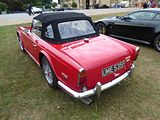First held in 2005, the Salon Privé event was created to provide something different from the run-of-the-mill car show with a mix of owner and club displays as well as dealer and trade stands. The clue is in the second word of the event’s name, “Privé”, which was chosen to suggest that this would deliberately be an exclusive event. Whilst it would not actually be truly “private”, it was certainly intended to be exclusive, something which would not be accessible to huge crowds of people. For the first few years, the event remained relatively unknown, but the inevitable increase in publicity that followed from a number of manufacturers using the event to showcase their latest products and the ensuing reports in the press as a growing number of them seemed to be treated to free access to an event that was never designed for them. The concept was a motor show unlike any other, focusing quite deliberately on showcasing an array of the latest high end luxury and supercars, a number of pre-owned cars offered by some of the best known names in the classic motor trade, trade stands offering other luxury products, all presented in a stylish location combined with a Garden Party. The first Salon Privé events took place at the exclusive Hurlingham Club in London, and then in 2011 it was moved to the lawns of Syon House. For the eagerly awaited 10th edition of the Salon Privé in 2015, the decision was taken to move out of London altogether, with a new venue announced as the South Lawn of Blenheim Palace, seat of the Dukes of Marlborough, and birthplace and ancestral home of Sir Winston Churchill. It proved to be an excellent choice, and so this has been the venue of choice ever since. One benefit of the new location is that there is a lot more space. This encouraged the organisers to think not just about what to display, but also how to grow the event, with more attendees, without losing that feeling of exclusivity and an uncrowded atmosphere. Quite how they do this has varied a bit over the years, more recently with an extra day being added to the event, with a focus on supercars, with a separate display being mounted in the Great Court, with this comprising an event in its own right, accessible with a much cheaper ticket than seeing the cars on the south lawn. That part of the event remained available for those who were prepared to pay the extra cost – with special deals sometimes available by getting access only in the afternoon. Like most events, there was no Salon Privé in 2020 and the 2021 event was a slightly tentative return with a format similar to that of 2021. For 2022, with everything back to full strength, the organisers made a big play of the fourth day. I decided to attend and this is what I saw.
There were effectively three parts to this event: a supercar car display for special vars that was held in the Great Court, as before: the area surrounding this which was allocated to invited Car Clubs, with a heavy bias towards supercars, and the area on the south lawn which is where the event had been held for the preceding three days. Your entry ticket gave access to all three, and I have grouped them all together for the purposes of this report.
ABARTH
Given the nature of the event, it never occurred to me to ask for a club display space here, but clearly something about the Abarth has captured the hearts of the organisers as early in 2022 I received an unsolicited email inviting me to assemble a group of Abarths for a display stand. Needless to say, I accepted the invitation, hoping that I could get fellow owners to respond equally positively, but knowing that the combination of the price of the ticket (even at the club price) and other events in the diary would mean that this was unlikely to be a huge Abarth gathering. And so it proved.
The vast majority of cars here were the 500-based models which have been on sale now since the end of 2008, following a launch at the Paris Show that year. Since that time there have been a number of detailed changes to the standard cars and a lot of limited editions. Those who really know the marque can spot most of them, but some are so subtle that unless there is a badge you can see, you will not be quite sure which version you are looking at. It used to be relatively easy, when the model was first launched, as there was only one version as shipped ex works called the 500. It had a 135 bhp 1.4 litre turbo-charged engine coupled to a five speed manual gearbox, with 16″ alloys as standard, and the option of 17″ wheels, and a colour palette comprising of two whites (BossaNova White, the standard colour, or the pearlescent Funk White), Red (Pasadoble), Pale Grey (Campovolo) or Black. If you wanted more power – 160 bhp – then you could order an Esseesse kit, which came in a large wooden crate, containing new wheels, springs, an ECU upgrade, the Monza exhaust system and badging. It was dealer fitted and could be applied at any time within the first 12 months or 10,000 miles from registration. Needless to say, it proved popular. As were many of the optional extras, with stickers for the sides, a large scorpion for the bonnet and even a chequered pattern for the roof among the personalisation options offered.
Whilst a sliding glass sunroof (Skydome in Fiat/Abarth parlance) was an option from inception, fans of open air motoring had to wait until Geneva 2010 for the launch of the 500C models, with a roll-back roof which provided the best of open-topped motoring and yet still with the rigidity of the regular body style. For the first few months these cars only came with the robotised manual gearbox, which limited the appeal in the eyes of some, but they also introduced us to the “bi-colore”, a series of two tone cars, with upper and lower halves of the body painted in different colours. It took us a while to get used to this, as no other production road cars had been painted like this for some time, but now this is seen as yet another of those marque defining attributes, and (perhaps with the exception of the rarely seen Rally Beige and Officina Red combination that would come for 2014, an example of which was here) in the eyes of many this distinctive look enhances the appeal of the cars still further.
Rumours started to circulate towards the end of 2014 that Abarth were going to upgrade the Competizione model, so as better to bridge the gap between the Turismo and the 190 bhp 695 Biposto that had been added to the range earlier in the year. It was Geneva 2015 when the result was finally shown to an expectant fan base. Most exciting news was that thanks to a bigger Garrett Turbo, the engine had been tweaked to 180 bhp, and with reduced CO2 emissions. A standard spec that included Koni Dampers, Brembo brakes, Xenon lights, Sabelt seats, Climate Control, parking sensors as well as other refinements that had been added like the TFT instrument display all proved very compelling, so not long after the first cars reached the UK in June of 2015, I found temptation too hard to resist, and as is well documented here, swapped my 2010 car for one of these. At the time I ordered it, Cordolo Red, a tri-coat pearlescent paint which shimmers in bright sunlight looked set to become one of the most popular colours of the lot, even though it is a cost option. Indeed, the Launch Edition models were all offered either in this colour or Scorpion Black, with black wheels. Surprisingly, the colour was not carried over to the Series 4 cars.
What is known as the Series 4 version of the familiar 595 reached the markets in the middle of 2016. After rumours had circulated all winter following the launch of the facelifted Fiat 500 last year, Abarth finally unveiled the Series 4 at the end of May 2016. Initially, we were told that the cars would not be available in the UK until September, but that came forward somewhat, with dealers all receiving demo cars in June, and the first customers taking delivery in July. Three regular production versions of both the closed car and the open-topped C were initially available, all badged 595, and called Custom, Turismo and Competizione, as before, though numerous limited edition models have since appeared and in most case disappeared. The most significant changes with the Series 4 are visual, with a couple of new colours, including the much asked for Modena Yellow and a different red, called Abarth Red, which replaces both the non-metallic Officina and – slightly surprisingly – the tri-coat pearlescent Cordolo Red. as well as styling changes front and rear. The jury is still out on these, with many, me included, remaining to be convinced. At the front, the new air intake does apparently allow around 15 – 20 % more air in and out, which will be welcome, as these cars do generate quite a lot of heat under the bonnet. Competizione models for the UK retain the old style headlights, as they have Xenon lights as standard, whereas the Custom and Turismo cars have reshaped units. At the back, there are new light clusters and a new rear bumper and diffuser. Inside, the most notable change is the replacement of the Blue & Me system with a more modern uConnect Audio set up, which brings a new colour screen to the dash. Mechanically, there is an additional 5 bhp on the Custom (now 145) and Turismo (now 165 bhp) and the option of a Limited Slip Diff for the Competizione, which is likely to prove a popular option. Details of the interior trim have changed, with a filled-in glovebox like the US market cars have always had, and electric windows switches that are like the US ones, as well as a part Alcantara trim to the steering wheel in Competizione cars. These cars have now been on offer for five years and with Abarth sales on the rise, it was no surprise that they were particularly well represented here.
The Abarth Grande Punto debuted at the 2007 Frankfurt IAA Show, going on sale in the UK in late summer of 2008. Offering 155 bhp from its 1.4 litre T-Jet engine, coupled to a six speed gearbox, and riding on 45 profile 17″ alloys, the standard car got rave reviews from the journalists when they first tried it, and they were even more impressed by the changes wrought by the optional Esseesse kit. This increased power to 177 bhp, brought 18″ OZ lower profile wheels, whilst new springs lowered the ride height by 15-20mm, and high-performance front brake pads and cross-drilled front disc brakes helped the car to stop more quickly. The most distinctive feature of the car were the white alloy wheels, though, as owners found, keeping these clean is not a job for the uncommitted, and many have a second set of wheels that they use fro grubbier conditions. Despite the positive press at launch, the car entered a very competitive sector of the market, and the combination of being relatively unknown, a limited number of dealers and the existence of established rivals from Renault and others meant that this always remained a left-field choice. The owners loved them, though, and they still do.
The Punto Evo was launched at the 2010 Geneva Show, with the cars reaching UK buyers in the summer of that year, and it incorporated many of the changes which had been seen a few months earlier on the associated Fiat models, the visual alterations being the most obvious, with the car taking on the nose of the associated Fiat, but adapted to make it distinctively Abarth, new rear lights and new badging. There was more to it than this, though, as under the bonnet, the T-Jet unit was swapped for the 1.4 litre Multi-Air, coupled to a 6 speed gearbox, which meant that the car now had 165 bhp at its disposal. Eventually, Abarth offered an Esseesse kit for these cars, though these are exceedingly rare. For those in the know – which never seemed to be that many people – this was a really capable and desirable car, and the owners love them, lamenting the fact that the model had quite a short production life and has not been replaced.
Eagerly awaited, the 124 Spider went on sale in September 2016. A quick reminder as to what this car is: The Abarth 124 Spider was developed in parallel with the Fiat model. It does cost a lot more, and there are those who think you don’t get enough extra for your money, but those who have driven it will tell you otherwise. You certainly get more power. The 1.4 MultiAir turbo unit jumps up from 138bhp to 168bhp, while torque also increases by a modest 10Nm to 250Nm, which gives it a 0-62mph time of 6.8 seconds, which is half a second quicker than the 2.0-litre Mazda MX-5. The top speed is 143mph. It weighs just 1060kg meaning a power-to-weight ratio of 158bhp-per-tonne, and with the new Record Monza exhaust system it sounds great even at idle. The Abarth version gets a stiffer suspension setup than the regular Fiat 124 Spider, with Bilstein dampers and beefed-up anti-roll bars. Bigger Brembo brakes also feature, with aluminium calipers. It can be had with a six-speed manual or six-speed automatic transmission with paddles, and the latter gets a Sport mode for quicker shifts. Many of the UK cars sport the ‘Heritage Look’ pack, which is a no-cost option. It brings a matt black bonnet and bootlid, plus red exterior trim detailing and has proved popular. The £29,565 starting price gets you standard equipment such as cruise control, climate control, Bluetooth, a DAB radio and satnav, plus Alcantara black and red (or pure black) seat trim. The automatic gearbox is a £2,035 extra, while an optional visibility pack brings LED DRLs, auto lights and wipers and rear parking sensors.
Rather more a grand tourer than a racer was this 2200 Allemano. This was based on the Fiat 2100, but with more power from a slightly larger engine, producing 135 bhp from its 2,162 cc inline six-cylinder engine with three Weber 38DCOE carburettors. It had a four-speed manual transmission, front transverse leaf-spring suspension, rear coil springs, and four-wheel hydraulic disc brakes. Perhaps unsurprisingly, Carlo turned to Turin-based Carrozzeria Allemano for the bodywork. Allemano was established in 1928 and worked with the likes of Ferrari, Alfa Romeo, Lancia, and Cisitalia. The car was fearsomely expensive, costing more than an Aston Martin and more than double the price of an E Type Jaguar. It is thought that just 28 examples of the Abarth 2200 were produced, with a small number also bodied by Carrozzeria Ellena. There were coupe and convertible models. The car evolved into the 2400.
AC
There was an ME3000 here. First seen at the 1973 London Motor Show, it took until late 1979 before the car was available to customers. Prior to its launch, AC had been producing the large and costly 428 Coupe and Convertible, and the Managing Director, W Derek Hurlock, decided that a new and smaller car was needed. Mid-engined designs were in fashion at the time and in 1972 the prototype Diabolo was built with an Austin Maxi engine and transaxle. However, following considerable investment in development using the BLMC power unit and transmission, the engine manufacturers decided that they needed all the E series engines they could make to power their own Maxi and Allegro models, so the Diabolo project appeared likely to collapse for lack of an engine. In much the same way as they had taken up the Tojeiro prototype and turned it into the Ace, AC acquired the rights and at the 1973 London Motor Show showed their own version, the mid-engined ME3000 with the 3.0-litre Ford Essex V6 engine installed transversely over a custom AC-designed gearbox. The car featured a steel chassis making extensive use of square-section steel tube, with a strong monocoque for the central portion of the body. This framework supported a glass fibre body. Press releases of the time indicated that the company hoped to be able to build and sell the car at the rate of 10 – 20 cars per week, although it was at this stage apparent that the model was in many ways not yet ready for serial production. Development was complete in 1976 when new Type Approval regulations were introduced. A prototype failed the 30 mph crash test, and the chassis had to be redesigned. On the second attempt, the car passed. The design changes meant the AC 3000 ME was out of date by the time it reached production. The first cars (now renamed 3000ME) were delivered in 1979, by which time they were in direct competition with the Lotus Esprit. The goal of 250 cars per year did not seem possible. After 71 cars were sold, Hurlock called a halt to production in 1984.
ALFA ROMEO
By 1963, Alfa were ready to add a Coupe version to their new 105 Series Giulia range. It evolved over a 14 year production life, with plenty of different models, though the basic design changed little. The first car was called the Alfa Romeo Giulia Sprint GT, and was revealed at a press event held at the then newly opened Arese plant on 9 September 1963, and displayed later the same month at the Frankfurt Motor Show. In its original form the Bertone body is known as scalino (step) or “step front”, because of the leading edge of the engine compartment lid which sat 1/4 an inch above the nose of the car. The Giulia Sprint GT can be distinguished from the later models by a number of features including: Exterior badging: Alfa Romeo logo on the front grille, a chrome script reading “Giulia Sprint GT” on the boot lid, and rectangular “Disegno di Bertone” badges aft of the front wheel arches; flat, chrome grille in plain, wide rectangular mesh without additional chrome bars; single-piece chrome bumpers; no overriders. Inside the cabin the padded vinyl dashboard was characterised by a concave horizontal fascia, finished in grey anti-glare crackle-effect paint. Four round instruments were inset in the fascia in front of the driver. The steering wheel was non-dished, with three aluminium spokes, a thin bakelite rim and a centre horn button. Vinyl-covered seats with cloth centres and a fully carpeted floor were standard, while leather upholstery was an extra-cost option. After initially marketing it as a four-seater, Alfa Romeo soon changed its definition of the car to a more realistic 2+2. The Giulia Sprint GT was fitted with the 1,570 cc version of Alfa Romeo’s all-aluminium twin cam inline four (78 mm bore × 82 mm stroke), which had first debuted on the 1962 Giulia Berlina. Breathing through two twin-choke Weber 40 DCOE 4 carburettors, on the Sprint GT this engine produced 105 hp at 6,000 rpm. Like all subsequent models, the Sprint GT was equipped with an all-synchromesh 5-speed manual transmission. The braking system comprised four Dunlop disc brakes and a vacuum servo. The rear brakes featured an unusual arrangement with the slave cylinders mounted on the axle tubes, operating the calipers by a system of levers and cranks. According to Alfa Romeo the car could reach a top speed of “over 180 km/h (112 mph)”. In total 21,902 Giulia Sprint GT were produced from 1963 to 1965, when the model was superseded by the Giulia Sprint GT Veloce. Of these 2,274 were right hand drive: 1,354 cars fully finished in Arese, and 920 shipped in complete knock-down kit form for foreign assembly. For 1966, the Giulia Sprint GT was replaced by the Alfa Romeo Giulia Sprint GT Veloce, which was very similar but featuring a number of improvements: a revised engine—slightly more powerful and with more torque—better interior fittings and changes to the exterior trim. Alongside the brand new 1750 Spider Veloce which shared its updated engine the Sprint GT Veloce was introduced at the 36th Geneva Motor Show in March 1966, and then tested by the international specialist press in Gardone on the Garda Lake. Production had began in 1965 and ended in 1968. The Giulia Sprint GT Veloce can be most easily distinguished from other models by the following features: badging as per Giulia Sprint GT, with the addition of round enamel badges on the C-pillar—a green Quadrifoglio (four-leaf clover) on an ivory background—and a chrome “Veloce” script on the tail panel; black mesh grille with three horizontal chrome bars; the grille heart has 7 bars instead of 6; stainless steel bumpers, as opposed to the chromed mild steel bumpers on the Giulia Sprint GT. The bumpers are the same shape, but are made in two pieces (front) and three pieces (rear) with small covers hiding the joining rivets. Inside the main changes from the Giulia Sprint GT were imitation wood dashboard fascia instead of the previous anti-glare grey finish, front seats revised to a mild “bucket” design, and a dished three aluminium spoke steering wheel, with a black rim and horn buttons through the spokes. The Veloce’s type 00536 engine, identical to the Spider 1600 Duetto’s, featured modifications compared to the Giulia Sprint GT’s type 00502—such as larger diameter exhaust valves. As a result it produced 108 hp at 6,000 rpm, an increase of 3 hp over the previous model, and significantly more torque. The top speed now exceeded 185 km/h (115 mph). Early Giulia Sprint GT Veloces featured the same Dunlop disc brake system as the Giulia Sprint GT, while later cars substituted ATE disc brakes as pioneered on the GT 1300 Junior in 1966. The ATE brakes featured an handbrake system entirely separate from the pedal brakes, using drum brakes incorporated in the rear disc castings. Though the Sprint GT Veloce’s replacement—the 1750 GT Veloce—was introduced in 1967, production continued throughout the year and thirty final cars were completed in 1968. By then total Giulia Sprint GT Veloce production amounted to 14,240 examples. 1,407 of these were right hand drive cars, and 332 right hand drive complete knock-down kits. The Alfa Romeo 1750 GT Veloce (also known as 1750 GTV) appeared in 1967 along with the 1750 Berlina sedan and 1750 Spider. The same type of engine was used to power all three versions; this rationalisation was a first for Alfa Romeo. The 1750 GTV replaced the Giulia Sprint GT Veloce and introduced many updates and modifications. Most significantly, the engine capacity was increased to 1779 cc displacement. Peak power from the engine was increased to 120 hp at 5500 rpm. The stroke was lengthened from 82 to 88.5 mm over the 1600 engine, and a reduced rev limit from 7000 rpm to 6000 rpm. Maximum torque was increased to 186 N·m (137 lb·ft) at 3000 rpm. A higher ratio final drive was fitted (10/41 instead of 9/41) but the same gearbox ratios were retained. The result was that, on paper, the car had only slightly improved performance compared to the Giulia Sprint GT Veloce, but on the road it was much more flexible to drive and it was easier to maintain higher average speeds for fast touring. For the United States market, the 1779 cc engine was fitted with a fuel injection system made by Alfa Romeo subsidiary SPICA, to meet emission control laws that were coming into effect at the time. Fuel injection was also featured on Canadian market cars after 1971. Carburettors were retained for other markets. The chassis was also significantly modified. Tyre size went to 165/14 from 155/15 and wheel size to 5 1/2J x 14 instead of 5J x 15, giving a wider section and slightly smaller rolling diameter. The suspension geometry was also revised, and an anti-roll bar was fitted to the rear suspension. ATE disc brakes were fitted from the outset, but with bigger front discs and calipers than the ones fitted to GT 1300 Juniors and late Giulia Sprint GT Veloces. The changes resulted in significant improvements to the handling and braking, which once again made it easier for the driver to maintain high average speeds for fast touring. The 1750 GTV also departed significantly from the earlier cars externally. New nose styling eliminated the “stepped” bonnet of the Giulia Sprint GT, GTC, GTA and early GT 1300 Juniors and incorporated four headlamps. For the 1971 model year, United States market 1750 GTV’s also featured larger rear light clusters (there were no 1970 model year Alfas on the US market). Besides the chrome “1750” badge on the bootlid, there was also a round Alfa Romeo badge. Similar Quadrofoglio badges to those on the Giulia Sprint GT Veloce were fitted on C pillars, but the Quadrofoglio was coloured gold instead of green. The car also adopted the higher rear wheelarches first seen on the GT 1300 Junior. The interior was also much modified over that of earlier cars. There was a new dashboard with large speedometer and tachometer instruments in twin binnacles closer to the driver’s line of sight. The instruments were mounted at a more conventional angle, avoiding the reflections caused by the upward angled flat dash of earlier cars. Conversely, auxiliary instruments were moved to angled bezels in the centre console, further from the driver’s line of sight than before. The new seats introduced adjustable headrests which merged with the top of the seat when fully down. The window winder levers, the door release levers and the quarterlight vent knobs were also restyled. The remote release for the boot lid, located on the inside of the door opening on the B-post just under the door lock striker, was moved from the right hand side of the car to the left hand side. The location of this item was always independent of whether the car was left hand drive or right hand drive. Early (Series 1) 1750 GTV’s featured the same bumpers as the Giulia Sprint GT Veloce, with the front bumper modified to mount the indicator / sidelight units on the top of its corners, or under the bumper on US market cars. The Series 2 1750 GTV of 1970 introduced other mechanical changes, including a dual circuit braking system (split front and rear, with separate servos). The brake and clutch pedals on left hand drive cars were also of an improved pendant design, instead of the earlier floor-hinged type. On right hand drive cars the floor-hinged pedals were retained, as there was no space for the pedal box behind the carburettors. Externally, the series 2 1750 GTV is identified by new, slimmer bumpers with front and rear overriders. The combined front indicator and sidelight units were now mounted to the front panel instead of the front bumper, except again on the 1971-72 US/Canadian market cars. The interior was slightly modified, with the seats retaining the same basic outline but following a simpler design. 44,269 1750 GTVs were made before their replacement came along. That car was the 2000GTV. Introduced in 1971, together with the 2000 Berlina sedan and 2000 Spider, the 2 litre cars were replacements for the 1750 range. The engine displacement was increased to 1962 cc. Oil and radiator capacities remained unchanged. The North American market cars had fuel injection, but everyone else retained carburettors. Officially, both versions generated the same power, 130 hp at 5500 rpm. The interior trim was changed, with the most notable differences being the introduction of a separate instrument cluster, instead of the gauges installed in the dash panel in earlier cars. Externally the 2000 GTV is most easily distinguished by its grille with horizontal chrome bars, featuring protruding blocks forming the familiar Alfa heart in outline, smaller hubcaps with exposed wheel nuts, optional aluminium alloy wheels of the same size as the standard 5. 1/2J × 14 steel items, styled to the “turbina” design first seen on the alloy wheels of the Alfa Romeo Montreal, and the larger rear light clusters first fitted to United States market 1750 GTV’s were standard for all markets. From 1974 on, the 105 Series coupé models were rationalised and these external features became common to post-1974 GT 1300 Junior and GT 1600 Junior models, with only few distinguishing features marking the difference between models. 37,459 2000 GTVs were made before production ended and these days they are very sought after with prices having sky-rocketed in recent years.
The Alfa Romeo 4C is a two-seater, rear-wheel drive coupé with technology and materials derived from the Alfa Romeo 8C Competizione, with a 1750 cc turbo petrol engine with direct injection, the “Alfa TCT” twin dry clutch transmission, and the Alfa DNA dynamic control selector. The 4C concept version was unveiled in the 81st Geneva Motor Show in March 2011, followed by the Mille Miglia 2011 parade, Goodwood Festival of Speed 2011,2011 Frankfurt Motor Show. It was displayed for the first time outside in Concorso d’Eleganza Villa d’Este in 2012. Compared to the production version, it is very similar, with the biggest differences being front lights, side vents and mirrors. The Alfa Romeo 4C Concept was voted the ‘Most Beautiful Concept Car of the Year’ award by the readers of German magazine Auto Bild, and won the Auto Bild Design Award 2011. It was awarded the “Design Award for Concept Cars & Prototypes” by referendum of the public in Villa d’Este. The production car was unveiled at the 2013 Geneva Motor Show, followed by 2013 Essen ‘Techno Classica’, Goodwood Festival of Speed 2013, Moscow Raceway, 2013 Frankfurt Motor Show. The bare ‘4C000’ chassis was also shown at the 2013 Geneva Motor Show. Ordering of European models began in October 2013 at Alfa Romeo dealerships in Europe. As part of the Alfa Romeo 4C launch, Alfa Romeo Style Centre and Compagnia Ducale designed a 4C IFD (Innovative Frame Design) Bicycle, inspired by the Alfa Romeo 4C coupé. The vehicle went on sale in December 2013 and marketed in Europe, Asia and America. Production of the 4C began May 2013 at Maserati’s plant in Modena, with an expected production of up to 2500 units per year. It was the first mass-produced Alfa Romeo model to be sold in the US market since 1995 when the 164 sedan stopped being sold in the US. Production of the Alfa Romeo 4C was originally estimated to be over 1000 units per year, with an upper limit of 3500 units per year, depending on the quantity of carbon fibre chassis that can be built by the supplier Adler Plastic.Within the 3,500-unit quota, 1,000 units are earmarked for Europe. Delivery of the European Alfa Romeo 4C Launch Edition took place at Balocco (Vercelli, Italy) Test Centre. In 2018, the 4C coupe was discontinued for the North American market. The 4C Spider, however continued to be sold there for model year 2019 and model year 2020. In other markets, such as Australia and Japan, both the coupe and Spider continued. In late 2020, a new tribute-edition named the 4C Spider 33 Stradale Tributo was announced. The car was designed by Centro Stile Alfa Romeo (Style Centre) and developed by Alfa Romeo. The chassis is composed of a central carbon fibre tub, with aluminium subframes front and rear. The carbon fibre tub is produced by TTA (Tecno Tessile Adler) in Airola, as a joint venture between Adler Plastic and Lavorazione Materiali Compositi. The carbon fibre components that make up the chassis are cut using CNC technology. The entire carbon-fiber monocoque chassis (“tub”) of the car weighs 143 pounds (65 kg). Front and rear aluminium subframes combine with the tub, roof reinforcements and engine mounting to comprise the 4C chassis giving the vehicle a total chassis weight of 236 lb (107 kg) and a total vehicle curb weight of just 2,465 lb (1,118 kg). The 4C has a single carbon fibre body, similar to the body of many supercars. The outer body is made of a composite material (SMC for Sheet Moulding Compound) which is 20% lighter than steel. The stability is comparable to steel and better than aluminium. The 4C employs double wishbone suspensions at the front and MacPherson struts at the rear. The resultant weight distribution is 38% on the front and 62% on the rear axle. Wheels and tyres have different diameters and widths front and rear: 205/45 R17 front and 235/40 R18 back as standard, with optional 205/40 R18 and 235/35 R19. Both wheel options come equipped with Pirelli P Zero tyres. The 4C uses vented disc brakes on all wheels; Brembo 305 millimetres (12.0 in) on the front and 292 millimetres (11.5 in) on the rear. The car can stop from 100 km/h (62 mph) in 36 metres. To save weight and increase steering feel, the 4C has no power steering. Its center of gravity height, at 40 centimetres (16 in) off the ground, is 7 centimetres (2.8 in) lower than that of the Lotus Elise. The 4C uses a new all-aluminium 1,742 cc inline 4 cylinder turbocharged engine producing 240 PS at 6000 rpm. The engine has been designed for minimum weight. The engine’s combined fuel consumption 6.8 l/100 km (42 mpg‑imp; 35 mpg‑US).[4] 0–62 mph (0–100 km/h) acceleration is achieved in 4.5 seconds and the top speed is 258 km/h (160 mph), the power-to-weight-ratio being just 0.267 hp/kg (8.22 lb/hp) A journalist from Quattroruote car magazine demonstrated how the 4C accelerates from 0–100 km/h (0–62 mph) faster than 4.5 seconds. In race mode, with left foot on the brake pedal, if you pull the right shift paddle the engine will rev to 3500 rpm, but if you also pull the left paddle the engine will rev to 6000 rpm and 0–100 km/h (0–62 mph) time will go down to 4.2 seconds. Italian car magazine Quattroruote published the lap time of 4C around Nürburgring. It lapped the ring in 8:04. The 4C is equipped with a six speed Alfa TCT Dual Dry Clutch Transmission, and can be operated via gearshift paddles on the steering wheel. It also has an Alfa ‘DNA’ dynamic control selector which controls the behavior of engine, brakes, throttle response, suspension and gearbox. In addition to the modes already seen in Giulietta, the 4C has a new “Race” mode. The U.S. version of the 4C was introduced in the 2014 New York International Auto Show with the first 100 4C’s being shipped to the U.S. early July, with a total of 850 being shipped by the end of 2014. The U.S. model includes extra bracing and strengthening required to meet U.S. crash regulations (including aluminium inserts in the carbon fiber chassis), resulting in 100 kg (220 lb) of weight increase. This version also has new headlamps similar to those seen before in the 4C Spider version. In 2018, the 4C coupe was discontinued for the North American market due to US DOT NHTSA FMVSS 226 Ejection Mitigation. The regulation called for a progressive compliance date based on volume and, due to low volume, the 4C was allowed to continue until the last compliance date of 9/1/2017, thus all 2018 4C coupes in North America have build dates of 8/2017 or earlier. The 4C Spider, however continued to be sold in North America for model year 2019 and model year 2020. The Spider version of the 4C was previewed showing a pre-production prototype at the 2014 Geneva Motor Show. Sharing its engine with the Coupé version, the 4C Spider has different external parts such as the headlights, exhaust and engine hood, as well as a different roof section that features a removable roof panel. The North American spec 4C reflects a weight difference of only 22 lb (10 kg) (2,465 lbs vs. 2,487 lbs) for the Spider variant. Top speed is quoted at 257 km/h (160 mph) and acceleration from 0 to 100 km/h (62 mph) at 4.5 seconds. The 4C Launch Edition was a limited and numbered edition, unveiled at the vehicle’s launch at the 2013 Geneva Motor Show. The vehicle came in a choice of four paint colours (Rosso Alfa, Rosso Competizione tri-coat, Madreperla White tri-coat or Carrara White matte). 500 examples were reserved for Europe/ROW, 500 for North America, 88 for Australia (Rosso Alfa and Madreperla White only), 200 to Japan and 100 for the Middle East. Note that the original press release cited 500 for North America, 400 Europe, and 100 ROW; however, the plaques on actual cars suggest that more were built and are the numbers referenced above. Distinguishing features of the Launch Edition were carbon fiber trim (including headlight housings, spoiler and door mirror caps), rear aluminium extractor with dark finishing, Bi-LED headlights, dark painted 18-inch front and 19-inch rear alloy wheels, additional air intakes on the front fascia, red brake calipers, racing exhaust system, BMC air cleaner, specific calibration for shock absorbers and rear anti-roll bar, leather/fabric sports seats with parts in Alcantara and a numbered plaque. Alfa Red coloured cars got matching red stitching on the steering wheel, handbrake, mats, handles and sports seats. In Europe the vehicle went on sale for 60,000 euros including VAT. The 4C Competizione is a limited edition version of the 4C introduced in the 2018 Geneva Motor Show, finished in matte Vesuvio Grey, with carbon details on the roof, rear spoiler, mirror caps, side air vents and headlight moulding. The run reportedly consisted of 108 units. The Japanese market received 25 units, and 10 units were assigned to Australia. The US-market received no Competizione editions. The car had a very mixed reaction. The UK press hated it at launch, but owners generally disagreed and loved it. A total of 9117 were built before production ceased in 2020.
Also here was the highly rated Giulia Quadrifoglio
ASTON MARTIN
Follow on model to the DB2 was the DB4. Technically it was a development of the DB Mark III it replaced but with a completely new body. The DB4’s design formed the basis for later Aston Martin classics, such as the DB4 GT Zagato, the Lagonda Rapide 4-door saloon. It was eventually replaced by the Aston Martin DB5. The lightweight superleggera (tube-frame) body was designed by Carrozzeria Touring in Milan, and its Continental looks caused a sensation on its unveiling at the 1958 London Motor Show. Although the design and construction techniques were Italian, the DB4 was the first Aston to be built at the company’s Newport Pagnell works. The 3670 cc engine, designed by Tadek Marek, was a double overhead cam straight-6, with cylinder head and block of cast R.R.50 aluminium alloy, a further development of the earlier engine. The engine was prone to overheating initially, but the 240 hp produced by the twin-SU carburettor version made buyers forgive this unfortunate trait. Servo-assisted disc brakes were fitted all round: early 11.5 in Dunlops were replaced by Girlings. The independent front suspension used ball-jointed wishbones, coil springs and rack-and-pinion steering. The live rear axle also used coil springs and was located by a Watt’s linkage. The normal final-drive ratio for British and European use was 3.54:1: in the United States the ratio was usually 3.77. Customers wanting a car with an especially high top speed could choose a 3.31:1 ratio. A car with the British standard 3.54 final drive ratio tested by The Motor magazine in 1960 had a top speed of 139.3 mph and could accelerate from 0-60 mph in 9.3 seconds. A fuel consumption of 17.7 mpg. The test car cost £3967 including taxes. There were five “series” of DB4. The most visible changes were the addition of window frames in Series II and the adoption of a barred (rather than eggcrate) grille in Series IV. The Series III cars differed from the earlier ones in having taillights consisting of three small lamps mounted on a chrome backing plate. Earlier cars have single-piece units and the last Series V cars of September 1962 have similar taillights but recessed. The Series V also has a taller and longer body to provide more interior space, though the diameter of the wheels was reduced to keep the overall height the same. The front of the Series V usually was of the more aerodynamic style as already used on the Vantage and GT models, a style that was later carried over to the DB5 cars. A convertible was introduced in October 1961. It featured in-house styling similar to the Touring saloon, and an extremely rare factory hardtop was also available. In total, 70 DB4 convertibles were made from a total DB4 production run of 1,110 cars. 30 of these were Series IV, with the remaining 40 belonging to the Series V. 32 of the total convertibles built (11 and 21 of the different series respectively) were equipped with the more powerful Vantage engine. Top speed for the regular version is about 136 mph
Needing little in the way of introduction, as thanks to its starring role with James Bond, this has to be one of the world’s most recognised cars, is the DB5, a couple of examples of which were on show. The DB5 was designed by the Italian coachbuilder Carrozzeria Touring Superleggera. Released in 1963, it was an evolution of the final series of DB4. The principal differences between the DB4 Series V and the DB5 are the all-aluminium engine, enlarged from 3.7 litre to 4.0litre; a new robust ZF five-speed transmission (except for some of the very first DB5s);and three SU carburettors. This engine, producing 282 bhp, which propelled the car to 145 mph, available on the Vantage version of the DB4 since March 1962, became the standard Aston Martin power unit with the launch in September 1963 of the DB5. Standard equipment on the DB5 included reclining seats, wool pile carpets, electric windows, twin fuel tanks, chrome wire wheels, oil cooler, magnesium-alloy body built to superleggera patent technique, full leather trim in the cabin and even a fire extinguisher. All models have two doors and are of a 2+2 configuration. Like the DB4, the DB5 used a live rear axle. At the beginning, the original four-speed manual (with optional overdrive) was standard fitment, but it was soon dropped in favour of the ZF five-speed. A three-speed Borg-Warner DG automatic transmission was available as well. The automatic option was then changed to the Borg-Warner Model 8 shortly before the DB6 replaced the DB5. The high-performance DB5 Vantage was introduced in 1964 featuring three Weber twin-choke 45DCOE side-draft carburettors and revised camshaft profiles, delivering greater top-end performance at the expense of overall flexibility, especially as legendary Webers are renowned as ‘full-throttle’ devices. This engine produced 315 hp. Only 65 DB5 Vantage coupés were built. Just 123 convertible DB5s were produced (also with bodies by Touring), though they did not use the typical “Volante” name until 1965. The convertible model was offered from 1963 through to 1965. Originally only 19 of the 123 DB5 Convertibles made were left-hand drive. 12 cars were originally fitted with a factory Vantage engine, and at least one further convertible was subsequently factory fitted with a DB6 specification Vantage engine. A rare factory option (actually fitted by Works Service prior to customer delivery) was a steel removable hard top. From October 1965 to October 1966, Aston Martin used the last 37 of the Aston Martin DB5 chassis’ to make another convertible model. These 37 cars were known as “Short Chassis” Volantes and were the first Aston Martins to hold the “Volante” name. Although calling it a “Short Chassis” is a bit of a misnomer as the “short” comes from comparing it to the subsequent DB6, which has a longer chassis. When compared to the DB5, it is not “short” but rather the same size, however these cars differ to the DB5 convertible models as they feature DB6 split front and rear bumpers and rear TR4 lights, as also used on the DB6. These days the DB5 is the most valuable of all the DB models from the 1960s, with many of them heading towards the £1 million pound mark.
The DB6 was launched in 1965 as a replacement for the DB5 which had run since 1963. The wheelbase was now 4″ longer than before, resulting in an extensive restyle with a more raked windscreen, raised roofline and reshaped rear quarter windows. Opening front quarter lights made a reappearance, but the major change was at the rear where a Kamm tail with spoiler improved the aerodynamics, greatly enhancing stability at high speeds. “The tail lip halves the aerodynamic lift around maximum speed and brings in its train greater headroom and more luggage space”, declared Motor magazine, concluding that the DB6 was one of the finest sports cars it had tested. Famed employee, Tadek Marek, designed the six cylinder engine, which had been enlarged to 3,995cc for the preceding DB5 and remained unchanged. Power output on triple SU carburettors was 282bhp, rising to 325bhp in Vantage specification. Premiered at the 1965 London Motor Show, the DB6 Volante marked the first occasion the evocative ‘Volante’ name had been applied to a soft-top Aston Martin. After 37 Volante convertibles had been completed on the DB5 short wheelbase chassis, the model adopted the longer DB6 chassis in October 1966. A mere 140 DB6 based Volantes were manufactured, and of these only 29 were specified with the more powerful Vantage engine.

By the mid 1960s, Aston Martin’s customers had been clamouring for an eight-cylinder car, so Aston Martin designed a larger car. The engine was not ready, however, so in 1967 the company released the DBS with the straight-six Vantage engine from the DB6. Two years later, Tadek Marek’s V8 was ready, and Aston released the DBS V8. Though the body and name was shared with the six-cylinder DBS, the V8 sold for much more. The body was a modern reinterpretation of the traditional Aston Martin look, with a squared-off grille and four headlights (though some consider the styling derivative of the early Ford Mustang). Distinguishing features of the V8 model are the larger front air dam and lack of wire wheels, though some six-cylinder DBS cars also used the V8’s alloy wheels. The tail lights were taken from the Hillman Hunter. A road test report of the time noted that the car had gained 250 lb in weight with the fitting of the V8 in place of the previously used six-cylinder unit, despite the manufacturer’s assurance that the engine weighed only 30 lb more than the older straight-six. Other contributions to the weight gain included heavier ventilated brake discs, air conditioning, fatter tyres, a new and stronger ZF gearbox as well as some extra bodywork beneath the front bumper. Marek’s V8 engine displaced 5,340 cc and used Bosch fuel injection. Output was not officially released, but estimates centre around 315 hp. The DBS V8 could hit 60 mph in 5.9 seconds and had a top speed of nearly 160 mph. 402 DBS V8s were built. In April 1972, the DBS V8 became just the Aston Martin V8 as the six-cylinder DBS was dropped, leaving just this car and the six-cylinder Vantage in production. The V8 became known as the AM V8, a model retroactively referred to as the Series 2 V8 to separate it from later models. Visual differences included twin quartz headlights and a mesh grille, a front design which was to last until the end of production in 1989. AM V8 cars, produced from May 1972 through July 1973, used a similar engine to the DBS V8, albeit with Bosch fuel injection rather than the earlier carburettors. Just 288 Series 2 cars were built. Although David Brown had left the company, he had overseen development of this model. The first 34 cars still carried leftover “DBS V8” badging. The car switched back to Weber carburettors for the Series 3 in 1973, ostensibly to help the car pass new stricter emissions standards in California but most likely because Aston Martin was unable to make the Bosch fuel injection system work correctly. These cars are distinguished by a taller bonnet scoop to accommodate four twin-choke (two-barrel) Weber carbs. The car produced 310 hp and could reach 60 mph in 6.1 seconds with an automatic transmission or 5.7 with a manual. Performance suffered with emissions regulations, falling to 288 hp in 1976. The next year, a more powerful “Stage 1” engine with new camshafts and exhaust brought it up to 305 hp. Production of Series 3 cars lasted from 1973 through October 1978, but was halted for all of 1975. 967 examples were produced in this time. While earlier V8 cars have louvers cut into the little panel mounted beneath the rear windshield, the Series 3 and later cars instead have a small lip at the bottom of this panel, just ahead of the leading edge of the bootlid. The “Oscar India” specification was introduced in October 1978 at the Birmingham International Motor Show. Visually, the former scoop on the bonnet gave way to a closed “power bulge”, while a spoiler was integrated into the tail. Most Oscar India cars were equipped with a Chrysler “Torqueflite” three-speed automatic transmission, with wood trim fitted for the first time since the DB2/4 of the 1950s. Just 352 Oscar India models were built from 1978 through 1985. The power of the now de-smogged engines kept dropping on American market cars, down to a low of 245 hp in the early eighties. The convertible “Volante” was introduced in June 1978, but featured the Series 4 bonnet a few months before the coupé received the Oscar India update. The Volante Series 1 weighs 70 kg (155 lb) more than the coupé, due to the necessity of reinforcing the frame. US market cars received much larger bumpers beginning with the 1980 model year, adding weight and somewhat marring the car’s lines. Owners of US-specified cars often modify them to have the slimmer European bumpers. By 1981, the success of the Volante meant that the coupé model was only built on individual demand. The fuel-injected Series 5 cars were introduced in January 1986 at the New York International Auto Show. The compact Weber/Marelli system no longer needed the space of the previous carburettors, so the bonnet bulge was virtually eliminated. 405 Series 5 cars were built before production ceased in 1989. The Volante Series 2 received the same changes; 216 were built.
With the DB7, produced from September 1994 to December 2004, Aston Martin made more cars from a single model than all Astons previously made, with over 7000 built. Known internally as the NPX project, the DB7 was made mostly with resources from Jaguar and had the financial backing of the Ford Motor Company, owner of Aston Martin from 1988 to 2007. The DB7’s platform was an evolution of the Jaguar XJS’s, though with many changes. The styling started life as the still-born Jaguar F type (XJ41 – coupe / XJ42 – convertible) designed by Keith Helfet. Ford cancelled this car and the general design was grafted onto an XJS platform. The styling received modest changes by Ian Callum so that it looked like an Aston Martin. The first generation Jaguar XK-8 also uses an evolution of the XJ-S/DB7 platform and the cars share a family resemblance, though the Aston Martin was significantly more expensive and rare. The prototype was complete by November 1992, and debuted at the Geneva Motor Show in March, 1993, with the car positioned as an “entry-level” model below the hand-built V8 Virage introduced a few years earlier. With production of the Virage (soon rechristened “V8” following Vantage styling revisions) continuing at Newport Pagnell, a new factory was acquired at Bloxham, Oxfordshire that had previously been used to produce the Jaguar XJ220, where every DB7 would be built throughout its production run. The DB7 and its relatives were the only Aston Martins produced in Bloxham and the only ones with a steel unit construction inherited from Jaguar . Aston Martin had traditionally used aluminium for the bodies of their cars, and models introduced after the DB7 use aluminium for the chassis as well as for many major body parts. The convertible Volante version was unveiled at the North American International Auto Show in Detroit in 1996. Both versions have a supercharged straight-six engine that produced 335 bhp and 361 lb·ft of torque. The Works Service provided a special Driving Dynamics package, which greatly enhanced performance and handling for drivers who wanted more than what the standard configuration offered. In 1999, the more powerful DB7 V12 Vantage was introduced at the Geneva Motor Show. Its 5.9 litre, 48-valve, V12 engine produced 420 bhp and 400 lb·ft of torque. It has a compression ratio of 10.3:1. Transmissions were available with either a TREMEC T-56 six speed manual or a ZF 5HP30 five speed automatic gearbox. Aston Martin claimed it had a top speed of either 186 mph with the manual gearbox or 165 mph with the automatic gearbox, and would accelerate from 0–60 mph in 4.9 seconds. It is 4,692 mm long, 1,830 mm (72.0 in) wide, 1,243 mm (48.9 in) high, with a weight of 1,800 kg (3,968.3 lb). After the launch of the Vantage, sales of the supercharged straight-6 engine DB7 had reduced considerably and so production was ended by mid-1999. In 2002, a new variant was launched, named V12 GT or V12 GTA when equipped with an automatic transmission. It was essentially an improved version of the Vantage, its V12 engine producing 435 bhp and 410 lb·ft of torque for the manual GT, although the automatic GTA retained the 420 bhp and 400 lb·ft of torque of the standard DB7 Vantage. Additionally, the GT and GTA chassis had substantially updated suspension from the DB7 Vantage models. Aesthetically, compared to the Vantage it has a mesh front grille, vents in the bonnet, a boot spoiler, an aluminium gear lever, optional carbon fibre trim and new wheels. It also has 14.0 in front and 13.0 in rear vented disc brakes made by Brembo. When being tested by Jeremy Clarkson on Top Gear in 2003, he demonstrated the car’s ability to pull away in fourth gear and continue until it hit the rev limiter: the speedometer indicated 135 mph. Production of the GT and GTA was extremely limited, as only 190 GT’s and 112 GTA’s were produced worldwide with 17 of them shipped to the US market, for a total of 302 cars
The Aston Martin V12 Vanquish was designed by Ian Callum and bore a large resemblance to the production DB7 Vantage. However, the car had a strong influence from the Project Vantage Concept prototype which debuted with a V12 engine at the North American International Auto Show in January 1998. As underneath the car featured a strong aluminium/carbon composite construction, bonded chassis with a 5,935 cc V12 engine. It was available in 2+0 and 2+2 seating configurations. The 48-valve 60° engine produces 460 bhp and 400 lb⋅ft of torque. It is controlled by a drive-by-wire throttle and a six-speed Electrohydraulic manual transmission. The standard Vanquish model had 14.0 inch drilled and ventilated disc brakes with four-pot calipers, ABS, with electronic brake distribution. Its appearance in the 2002 James Bond film Die Another Day earned the V12 Vanquish the number three spot on the list of Best Film Cars Ever, behind the Minis from The Italian Job, and DB5 from Goldfinger & Thunderball. The car also appears in the video games Need For Speed: Hot Pursuit 2, James Bond 007: Nightfire, and James Bond 007: Everything or Nothing. The Vanquish S debuted at the 2004 Paris Auto Show, with increased horsepower and performance and slight styling revisions. The engine displacement remained at 5,935 cc with power increased from 460 to 520 bhp. Visual changes included new wheels, a slightly different nose shape, a new raised bootlid with a larger integrated spoiler incorporating the third high level brake light (in the rear window on the original Vanquish), a Vanquish S badge on the bootlid (the original Vanquish had no rear model designation) and the addition of a small front splitter (although this was mainly done for aerodynamic reasons). As part of its improvements, the Vanquish S featured a slightly improved coefficient of drag of 0.32 (from 0.33), with help from a redesigned splitter and boot lid. Its front and rear track were 1,524 mm (60.0 inches) and 1,529 mm (60.2 inches), respectively. It also incorporated the features of a 2004 option package, the Sports Dynamic Pack, which incorporated sportier suspension, steering, and brake features. This model was sold for the 2005 (alongside the base Vanquish) and 2006 (as a stand-alone) model years in the United States with only minor running changes; it was not sold in the United States for 2007. The Vanquish S featured larger brakes than the V12 Vanquish; 14.9 in front discs with six-pot calipers and 13.0 inches rear discs. The end of the Vanquish’s production run was celebrated with the Vanquish S Ultimate Edition. Aston Martin announced that the last 50 cars built would have a new ‘Ultimate Black’ exterior colour, upgraded interior, and personalised sill plaques. 1086 Vanquish S were built. With a 200+ MPH top speed, the Vanquish S was (as measured by top speed capability) the fastest Aston Martin ever until the Vantage V12 S was introduced in May 2013. Vanquish production ended on 19 July 2007, coinciding with the closing of the company’s Newport Pagnell factory after 49 years of operation.
Following the unveiling of the AMV8 Vantage concept car in 2003 at the North American International Auto Show designed by Henrik Fisker, the production version, known as the V8 Vantage was introduced at the Geneva Motor Show in 2005. The two seat, two-door coupé had a bonded aluminium structure for strength and lightness. The 172.5 inch (4.38 m) long car featured a hatchback-style tailgate for practicality, with a large luggage shelf behind the seats. In addition to the coupé, a convertible, known as the V8 Vantage Roadster, was introduced later in that year. The V8 Vantage was initially powered by a 4.3 litre quad-cam 32-valve V8 which produced 380 bhp at 7,300 rpm and 409 Nm (302 lb/ft) at 5,000 rpm. However, models produced after 2008 had a 4.7-litre V8 with 420 bhp and 470 Nm (347 lbft) of torque. Though based loosely on Jaguar’s AJ-V8 engine architecture, this engine was unique to Aston Martin and featured race-style dry-sump lubrication, which enabled it to be mounted low in the chassis for an improved centre of gravity. The cylinder block and heads, crankshaft, connecting rods, pistons, camshafts, inlet and exhaust manifolds, lubrication system and engine management were all designed in house by Aston Martin and the engine was assembled by hand at the AM facility in Cologne, Germany, which also built the V12 engine for the DB9 and Vanquish. The engine was front mid-mounted with a rear-mounted transaxle, giving a 49/51 front/rear weight distribution. Slotted Brembo brakes were also standard. The original V8 Vantage could accelerate from 0 to 60 mph in 4.8 seconds before topping out at 175 mph. In 2008, Aston Martin introduced an aftermarket dealer approved upgrade package for power and handling of the 4.3-litre variants that maintained the warranty with the company. The power upgrade was called the V8 Vantage Power Upgrade, creating a more potent version of the Aston Martin 4.3-litre V8 engine with an increase in peak power of 20 bhp to 400 bhp while peak torque increased by 10 Nm to 420 Nm (310 lb/ft). This consists of the fitting of the following revised components; manifold assembly (painted Crackle Black), valved air box, right and left hand side vacuum hose assemblies, engine bay fuse box link lead (ECU to fuse box), throttle body to manifold gasket, intake manifold gasket, fuel injector to manifold seal and a manifold badge. The V8 Vantage had a retail price of GB£79,000, US$110,000, or €104,000 in 2006, Aston Martin planned to build up to 3,000 per year. Included was a 6-speed manual transmission and leather-upholstery for the seats, dash board, steering-wheel, and shift-knob. A new 6-speed sequential manual transmission, similar to those produced by Ferrari and Lamborghini, called Sportshift was introduced later as an option. An open-topped model was added to the range in 2006 and then in the quest for more power a V12 Vantage joined the range not long after.
During 2016, a handful of lucky customers were able to take delivery of one (or both) of a couple of very special versions of the Vantage offered, the GT8 and GT12, and an example of the latter was here. First of them was the Vantage GT12. This started out as the Aston Martin Vantage GT3 special edition when it was unveiled at the Geneva Motor Show 2015. The company said that they would only manufacture 100 cars. After a complaint from Porsche over the use of the “GT3” moniker, the car was renamed the Vantage GT12. It features a new iteration of the 6.0-litre V12 that produces 592 bhp and 461 lb/ft of torque. It has a kerb weight of 1,535 kg (3,384 lb), and can accelerate from 0 to 60 mph in 3.5 seconds. There were sufficient external alterations that you would know that you were looking at something very special. For the Vantage GT8, which was launched a year later, Aston decided to make more cars – 150 of them, which was 50 more than the GT12. The GT8 features the same 4.7-litre V8 as found in the base Vantage but with power now increased to 440 bhp, and has a top speed of 190 mph (310 km/h). The GT8 is available with either a 6-speed manual or a 7-speed Sportshift II automated manual transmission, and has a kerb weight of 1,510 kg (3,329 lb), a 100 kg (220 lb) reduction over the V8 Vantage S.
This version of the Vanquish started life as the Project AM310 Concept that was unveiled at the 2012 Concorso D’Eleganza at Villa D’Este on the shores of Lake Como, Italy. The concept car was based on the fourth generation VH platform. It included a tweaked version of Aston Martin’s familiar grille and headlight design and a more pronounced bulge in the bonnet – with the real One-77-inspired flourishes saved for the sides and the rear, the side vents run almost to the door handles (from One-77), new rear light design from One-77, and a 5.9-litre V12 engine that produced 550 PS. Aston Martin later announced that the concept would be put into production as the all new Aston Martin Vanquish. The exterior styling of the Vanquish is an evolution of the DBS with many styling cues such as the elongated side strakes being inspired by the Aston Martin One-77. The boot lid included an integrated rear spoiler designed to look as if it is impossible to make; this was done on the orders of Aston Martin Chief Executive, Dr. Ulrich Bez. The car has an exposed carbon fibre side skirt showing its all carbon fibre body. The Vanquish uses the new VH Generation IV platform which is lighter and uses more carbon fibre components than the VH Generation II platform used in the DBS. The car featured an all new interior based on the one found in the exclusive One-77. The standard interior was trimmed in hand stitched leather and alcantara and was available in a range of colours. The centre console features an revised infotainment system over the one found in the DBS. The car was available as either a 2-seater or 2+2. The Vanquish used an upgraded version of Aston Martin’s flagship 5.9-litre AM11 V12 engine called the AM28 with a power output of 565 bhp at 6,750 rpm and torque of 457 lb/ft at 5,500 rpm. The Vanquish can accelerate from 0 to 100 km/h (62 mph) in 4.1 seconds, and has a top speed of 295 km/h (183 mph). Like most Aston Martins, the engine is front mid-mounted for better weight distribution, with the power going to the rear wheels. The Vanquish has 51/49 front/rear weight distribution, and a kerb weight of 1,739 kg (3,834 lb). It uses a fully catalysed stainless steel exhaust system with active bypass valves. The Vanquish uses an updated Touchtronic II six-speed automatic gearbox. It was the first Aston Martin model to be available with launch control. The combined space of cabin and a boot that, at 368 litres, is more than 60% larger than that of the DBS. The brakes are ventilated carbon ceramic discs, 398 mm (15.7 in) six-piston callipers in the front and 360 mm (14.2 in) four-piston callipers in the rear. The suspension is a lightweight aluminium front subframe with hollow castings with independent double wishbones incorporating anti-dive geometry, coil springs, anti-roll bar, and monotube adaptive dampers in the front and independent double wishbones with anti-squat and anti-lift geometry, coil springs, anti-roll bar, and monotube adaptive dampers in the rear. It has a three-stage adjustable adaptive damping system including normal, sport and track modes. The tyres are Pirelli P Zeros, 255/ZR20 in the front and 305/30 ZR20 in the rear. The vehicle was unveiled in the London Film Museum, Covent Garden, followed by 2012 Monterey Car Week. Deliveries to UK and Continental Europe began in late 2012. In August 2014, Aston Martin revealed technical modifications to the Vanquish. The changes include a new eight-speed Touchtronic III gearbox and upgraded AM29 V12 engine that produces 568 bhp and torque of 465 lb/ft. The changes greatly enhanced performance, with an acceleration of 0 to 100 km/h (62 mph) in 3.6 seconds, and a top speed of 324 km/h (201 mph). In 2013, Aston Martin unveiled a convertible version of the Vanquish, called Volante. The Volante includes a full carbon fibre body, triple-skin lightweight fabric roof, 50% larger boot than its predecessor and the third generation Brembo 398 mm × 36 mm front and 360 mm × 32 mm CCM rear Carbon Ceramic Matrix (CCM) brake discs with six-piston front and four-piston rear brake callipers (from the One-77). The Vanquish Volante is 13% torsionally stiffer than the outgoing DBS Volante. The carbon fibre-skin of the Vanquish Volante was created by the engineering team at Aston Martin. The vehicle was unveiled at the 2013 Pebble Beach Concours d’Elegance. Deliveries to Europe began in late 2013. On 16 November 2016, Aston Martin announced the new Vanquish S model. The Vanquish S features the same AM29 V12 engine, with power now increased to 595 bhp, and a new aerodynamic package. The Vanquish S can accelerate from 0 to 100 km/h (62 mph) in 3.5 seconds, and the top speed remains unchanged at 201 mph (324 km/h). The starting price at launch was £199,950 and deliveries started in December 2016. Aston Martin also unveiled a convertible version of the Vanquish S called the Vanquish S Volante in 2017.
Aston Martin announced a limited series production of the Aston Martin Vanquish Zagato; the latest creation from its long-standing partnership with the prestigious Italian design-house Zagato. The Vanquish Zagato Concept was unveiled to great acclaim at the prestigious Concorso d’Eleganza Villa d’Este at Lake Como, Italy in May 2016. The Vanquish Zagato is available in 4 body styles – coupé, convertible, speedster, or shooting brake. 99 each were built of the coupé, convertible, and shooting brake, while a mere 28 speedsters were made, for a total of 325 cars. The Vanquish Zagato features the same AM29 V12 from the Vanquish S, which has a power output of 603 PS (595 bhp) and 630 Nm (465 lb/ft) of torque, allowing the Vanquish Zagato to accelerate from 0 to 100 km/h (62 mph) in 3.5 seconds before reaching a top speed of 324 km/h (201 mph)
The latest and still current Aston Martin Vantage was unveiled on 21 November 2017 with production starting in June 2018, replacing the previous model which had been in production for 12 years. It introduced a new styling direction but this was not universally well received and the car had a hefty price increase over its predecessor. Muted press enthusiasm did not help and sales have been disappointing. Aston Martin have continued to develop the model with a number of new versions introduced, to try to improve demand. The Vantage AMR is a track-focused variant of the Vantage. The main highlight of the model is the replacement of the ZF 8-speed automatic transmission with a dog-leg Graziano Trasmissioni 7-speed manual transmission previously used on the V12 Vantage S. The AMR also comes with a driver-selectable AMSHIFT system which controls the throttle during gear shifting. A new limited-slip differential ensures linear delivery of power. The power-band of the engine is wider and the unit is designed to deliver 625 N⋅m (461 lb⋅ft) of torque from 2,000 rpm to 5,000 rpm. The use of a manual transmission and carbon-ceramic brakes reduce the weight by 95 kg (209 lb). New adaptive dampers with the section of Sport, Sport + and Track modes improve handling. Performance figures include a 0–97 km/h (60 mph) acceleration time of 3.9 seconds, half a second more than the standard Vantage while the top speed remains the same as the standard model. Visual changes include 20-inch forged wheels as available on the Rapide AMR, new carbon fibre side vents and cooling vents present on the hood a sports exhaust system with quad tailpipes and racing bucket seats. Production of the AMR will be limited to 200 units worldwide. Available exterior colours for the AMR include Sabiro Blue, Pnyx Black, China Grey and White Stone. The final 59 cars will be finished in a Sterling Green exterior colour with Lime accents and will pay homage to the 1959 24 Hours of LeMans victory of Aston Martin. Once the production of the AMR ceases, the 7-speed manual transmission will become available on the standard Vantage. The vehicle went on sale in May 2019, with delivery set to begin in Q4 2019. Revealed in February 2020, the Vantage Roadster is a convertible version of the V8 Coupe with a fabric roof. The roof claimed to be the fastest of any automotive automatic convertible system, takes 6.7 seconds to lower and 6.8 seconds to raise and can be operated at speeds of up to 50 km/h (31 mph). The Vantage Roadster has a dry weight of 1,628 kg (3,589 lb). The F1 Edition is a version of the V8 Coupe and V8 Roadster commemorating Aston Martin’s return to Formula One after 61 years. The car features a fixed rear wing at the back, increased engine power to 535 PS (528 bhp), a top speed of 314 km/h (195 mph), new 21-inch wheel rims, and a 0–100 km/h (0–62 mph) acceleration time of 3.5 seconds. The car is available in three colours: Aston Martin Racing Green, Jet Black, and Lunar White. A convertible version called the Roadster is also available. Delivery began in May 2021.
This was an impressive line of race-spec GT3 versions of the current and previous Vantage model.
There were plenty of examples of the rest of the current range here, too, including the DB11 and the DBX in standard and 707 versions.
Final Aston here was the dramatic Valkyrie, (also known by its code-names as AM-RB 001 and Nebula) is a limited production hybrid sports car collaboratively built by British automobile manufacturers Aston Martin, Red Bull Racing Advanced Technologies and several others. The sports car is a product of collaboration between Aston Martin and Red Bull Racing to develop a track-oriented car entirely usable and enjoyable as a road car, conceived by Adrian Newey, Dr Andy Palmer, Christian Horner and Simon Spoule. The car’s makers claim the title of fastest street-legal car in the world for it. Adrian Newey, Red Bull Racing’s Chief Technical Officer and the world’s most successful F1 designer aided in the design of the car. Its main competitors are the Mercedes-AMG ONE and the Gordon Murray Automotive T.50. The start of the 2019 Formula One British Grand Prix, the car made a lap of the Silverstone circuit for the first time. Aston Martin also announced a Spider variant; only 85 will be produced. Production is expected to begin in 2023 for the Spider variant. The original codename was Nebula, an acronym for Newey, Red Bull and Aston Martin. The name AM-RB 001 was chosen as the final codename, and was decided since Aston Martin and Red Bull Racing had collaborated all throughout the project. AM stands for Aston Martin, and RB stands for Red Bull. 001 may be a possible reference to it being the first production car the two have collaborated on. In March 2017, Aston Martin revealed that the car would be named Valkyrie, after the Norse mythological figures who guide the souls of Nordic soldiers fallen on the battlefield, leading them in one of two paths, choosing one half going to Odin’s Valhalla, and one half going to Goddess Freyja’s afterlife Fólkvangr. According to Red Bull, the name was chosen to continue the tradition of “V” nomenclature of Aston Martin’s automobiles and to distinguish the vehicle as a high-performance car (the “V” was used as the distinguishing factor). The Aston Martin Valhalla, which is known as “Son of Valkyrie”, likewise has its origin in Norse Mythology, with the Gods Hall (home to King of the Gods and Supreme God Odin Allfather) bearing the name Valhalla. The road car’s production will be limited to 150 units at a unit price of US$3.5 million. The AMR Pro production will be limited to 25 units at a unit price of US$4 million. Both versions have sold out. In an Autocar interview (22 May 2021), Aston Martin’s CEO indicated that a convertible version could also be launched in 2022. This is likely to be reserved for buyers of the Coupé version. Ten cars, fewer than planned, were delivered in the last quarter of 2021, causing the company to miss its profit target. The company said that this only affected timing, all production had been sold but not yet delivered.] The Aston Martin Valkyrie Spider was two times oversubscribed.
AUDI
Designed, developed and built by Quattro GmbH, Audi’s high performance private subsidiary, the Audi R8 is often heralded as the world’s best everyday supercar. Built on an aluminium monocoque chassis, the R8 has been described by 6-time le Mans winner Jacky Ickx as the “best handling road car today”, high praise indeed, and he is far from the only person to be impressed. Even the UK motoring journalists, not renowned for the positive words that they pen on Audis (in complete contrast to their German peers) almost ran out of superlatives for this car. This is one of the V8 models, dating from 2009, which means that it has 430 bhp, a 0-60 time of 4.0 seconds and a top speed of 168 mph
The second generation of the R8 (model code: Type 4S) was unveiled at the 2015 Geneva Motor Show and is based on the Modular Sports System platform shared with the Lamborghini Huracan. The development of the Type 4S commenced in late 2013 and was completed in late 2014. Initial models included the all-electric e-Tron and the V10 5.2 FSI along with the V10 plus. Unlike its predecessor, there was no manual transmission available and the entry-level V8 trim was also dropped. In 2016, the convertible (Spyder) variant was added to the line up which was initially available in the base V10 trim. In mid-2017, the high performance V10 plus Spyder was added to the range. A rear-wheel-drive model called the R8 RWS was introduced. In 2018, the R8 received a mid-cycle refresh with mechanical and exterior changes. The newer and more aggressive design language carried over from famous Audi models of the past and it’s appearance is slightly more angular up front. Some of the aerodynamic features such as the front aeroblades are shared with the Lamborghini Huracàn. The refreshed model had substantial performance improvements over its predecessor. The base R8 gets a power boost from 532 hp to 562 hp, while the V10 Plus was renamed V10 Performance Quattro and the engine saw a power increase by 10 bhp, now up to 612 bhp. The Audi R8 e-tron (2015) was an all-electric version of the second-generation R8. Unlike the earlier 2010 prototype based on the first-generation R8, it actually entered production, but only on a small scale, with less than 100 units sold. It featured a 92-kWh battery.
AUSTIN
This is a Ten, a model which Austin had launched in 1932, to plug the gap between the diminutive Seven and the larger Twelve models in their range which had been updated in early 1931. The Ten became the marque’s best seller and was produced, in a number of different versions through to 1947. A number of improvements were made to the car in the months following launch, but it was for 1937 when the first really big change came about with the launch of the almost streamlined Cambridge saloon and Conway cabriolet. Compared with the preceding cars, the passengers and engine were positioned much further forward, the back seat now being rather forward of the back axle. There were six side windows like the Sherborne and the quarter lights were fixed. Again like the Sherborne the forward doors opened rearwards. At the back there was now a compartment large enough to take a trunk as well as more luggage on the open compartment door when it was let down. A new smoother single plate spring-drive clutch was now fitted, the two friction rings carried by the centre plate were held apart by leaf springs. Other changes included Girling brakes with wedge and roller shoe expansion and balance lever compensation using operating rods in tension with automatic compensation between front and rear brakes all four of which might be applied by hand or foot. Drums were now 9 inches diameter. 16-inch steel disc wheels replaced the 18-inch wires. Top speed from the 1141cc engine rose to 60 mph.
BENTLEY
A close relative of the Rolls Royce Silver Cloud, the S Type was first revealed in April 1955. It represented a complete redesign of the standard production car, the R Type. It was a more generously sized five- or six-seater saloon with the body manufactured in pressed steel with stressed skin construction, with the doors, bonnet and boot lid made of aluminium. The external appearance was very different, although the car still had the traditional radiator grille. Compared to the outgoing R Type, the new model had a three inch longer wheelbase, was lower of build without reducing headroom and with an enlarged luggage boot, softer suspension with electrically operated control of rear dampers, lighter steering and improved braking. The engine, still a clear descendants of the one originally used in the Rolls-Royce Twenty from 1922 to 1929, had its capacity increased to 4887cc, and a four-speed automatic gearbox was standard, with the ability to select individual ratios if desired, which was enough to give the Bentley a top speed of just over 100 mph and 0 – 60 acceleration times of around 13 seconds. Standard and from 1957, long wheelbase saloons were offered and some were sent to the coachbuilders for alternative bodies to be fitted. An upgrade in 1959, creating the S2, saw the installation of a new V8 engine, and in 1962, the S3 cars gained four round headlights. 3072 S Types were made, 145 of them with coachbuilt bodies as well as 35 of the long wheelbase cars, before the model was replaced by the new T Type in 1965.
Representing the modern Bentley were a number of exanples of the rContinental GT in both Coupe and Cabriolet forms.
BMW
The BMW E23 is the first generation of the BMW 7 Series luxury cars and was produced from 1977 until 1986. It was built in a 4-door sedan body style with 6-cylinder engines, to replace the BMW ‘New Six’ (E3) sedans. From 1983 until 1986, a turbocharged 6-cylinder engine was available. The E23 introduced many electronic features for the first time in a BMW, including an on-board computer, service interval indicator, a “check control panel” (warning lights to indicate system faults to the driver), a dictaphone and complex climate control systems. It was also the first BMW to offer an anti-lock braking system (ABS), a driver’s airbag (optional, starting in April 1985 and a new design of front suspension. The initial styling concepts were developed under BMW Design Director Paul Bracq, with Manfred Rennen contributing with the exterior styling. All models were powered by a straight-six petrol engine, with the majority of cars using the BMW M30 engine. Most engines were fuel-injected, however the 728 and 730 models of 1978–1979 used a Solex four-barrel carburettor. The fuel-injected models initially used the Bosch L-Jectronic system, until the 1979 732i, which was the first BMW to use the Bosch Motronic fuel-injection system. Production occurred from 1977 until 1986, during which time 285,029 cars were built.
Oldest of the legendary M3 cars was this fabulous E30 M3. Produced initially purely as a homologation special, the car achieved far greater levels of interest than ever imagined, and the rest, as they say, is history. Based on the 1986 model year E30 3 Series, the car was initially available with the 2 door body and was later offered as a convertible bodies. The E30 M3 used the BMW S14 engine. The first iteration of the road car engine produced 195 PS with a catalytic converter and 200 PS without a catalytic converter in September 1989 power was increased to 215 PS with a catalytic converter. The “Evolution” model (also called “EVO2”) produced 220 PS. Other Evolution model changes included larger wheels (16 X 7.5 inches), thinner rear and side window glass, a lighter bootlid, a deeper front splitter and additional rear spoiler. Later the “Sport Evolution” model production run of 600 (sometimes referred as “EVO3”) increased engine displacement to 2.5 litres and produced 238 PS. Sport Evolution models have enlarged front bumper openings and an adjustable multi-position front splitter and rear wing. Brake cooling ducts were installed in place of front foglights. An additional 786 convertibles were also produced. The E30 M3 differed from the rest of the E30 line-up in many other ways. Although using the same basic unit-body shell as the standard E30, the M3 was equipped with 12 different and unique body panels for the purposes of improving aerodynamics, as well as “box flared” wheel-arches in the front and rear to accommodate a wider track with wider and taller wheels and tyres. The only exterior body panels the standard model 3 Series and the M3 shared were the bonnet, roof panel, sunroof, and door panels. The E30 M3 differed from the standard E30 by having a 5×120 wheel bolt pattern. The E30 M3 had increased caster angle through major front suspension changes. The M3 had specific solid rubber offset control arm bushings. It used aluminium control arms and the front strut tubes were changed to a design similar (bolt on kingpins and swaybar mounted to strut tube) to the E28 5 Series. This included carrying over the 5 series front wheel bearings and brake caliper bolt spacing. The rear suspension was a carry over from the E30. The E30 M3 had special front and rear brake calipers and rotors. It also has a special brake master cylinder. The E30 M3 had one of two Getrag 265 5-speed gearboxes. US models received an overdrive transmission while European models were outfitted with a dogleg version, with first gear being down and to the left, and fifth gear being a direct 1:1 ratio. Rear differentials installed included a 4.10:1 final-drive ratio for US models. European versions were equipped with a 3.15:1 final drive ratio. All versions were clutch-type limited-slip differentials with 25% lockup. To keep the car competitive in racing following year-to-year homologation rules changes, homologation specials were produced. These include the Evo 1, Evo 2, and Sport Evolution, some of which featured less weight, improved aerodynamics, taller front wheel arches (Sport Evolution; to further facilitate 18-inch wheels in DTM), brake ducting, and more power. Other limited-production models (based on evolution models but featuring special paintwork and/or unique interior schemes commemorating championship wins) include the Europa, Ravaglia, Cecotto, and Europameister. Production of the original E30 M3 ended in early 1992.
BRISTOL
This is a 406, the last Bristol to use the BMW-derived pushrod straight six engine that had powered all cars built by the company up to that point. In a stopgap measure for the 406 its torque was improved by a 245 cc increase in capacity because it was clearly unable to give a performance comparable to that of newer engines emerging at the time. A prototype with a body by Carrosserie Beutler AG of Thun in Switzerland was exhibited in 1957 in both Paris and London Motor Shows. The start of production at Filton was announced in late August 1958. Compared to the 405, the 406 saw several significant changes. The most important was that the six-cylinder engine itself was enlarged slightly in both bore and stroke to dimensions of 69 mm by 100 mm This gave an engine displacement of 2,216 cc but the actual power of the engine was no greater than that of the 405. However, the torque was higher than for the smaller engine, especially at low engine speeds. Manufacture of the 2-litre version continued for supply to AC Cars for their AC Ace and Aceca. The 406 also featured Dunlop-built disc brakes on all four wheels (making it one of the first cars with four-wheel disc brakes) and a two-door saloon body Bristol were to stick with for a long period after adopting Chrysler V8 engines with the 407. The styling made the 406 more of a luxury car than a true sports saloon. The rear suspension of the 406 also did away with the outdated A-bracket of all previous Bristols for a more modern Watt’s linkage. The 406 was the world’s first production car to be thus equipped. However, the outdated front suspension of previous Bristols was retained and not updated until the following model with its more powerful drivetrain. It was replaced by the similar looking 407 in 1961.
BUGATTI
There were two examples of the Veyron here.
Also here were three examples of the Chiron. Taking its name from the 1920s and 1930s Grand Prix racer Louis Chiron, whose notable results included victory in the 1931 French Grand Prix at the wheel of a Bugatti Type 51, this amazing machine, first seen in production guise at the Geneva Show in 2016 had been previewed by the Vision Gran Turismo concept car at the 2015 Frankfurt Show, and a few times after that, such as at the 2016 Retromobile. The immensely powerful Chiron was conceived to occupy the position its highly celebrated predecessor held at the very top of the supercar ladder, one rung above the McLaren P1, Ferrari LaFerrari and Porsche 918 Spyder – all of which had ceased production by the time of the Chrion’s launch. Bugatti describes the second of its modern day models as the most powerful road car to ever reach series production, and it does indeed produce a colossal 1479bhp which means it can reach 62mph in less than 2.5sec – despite weighing 1995kg – and has a maximum top speed of 261mph.. The phrase “series production” is all relative, though, with volumes set to be limited to 500 and a price to match its extreme performance at an eye watering €2.4 million (about £1.9 million) it will remain out of reach for all but the seriously rich. Bugatti boss Wolfgang Dürheimer portrays the quad-turbocharged 8.0-litre W16 powered Chiron as an all-new car that uses little from the Veyron. But while the new Bugatti has been comprehensively re-engineered and now features a full carbonfibre construction, it adopts a similar mechanical package to its record-breaking predecessor. At its heart is a heavily revised version of the quad-turbocharged 8.0-litre W16 configured petrol engine used by the Veyron. With a faintly absurd 1479bhp developed at 6750rpm, the mid-mounted unit delivers 492bhp more than the engine used by the Veyron – in the process providing the Chiron with a power-to-weight ratio of 741bhp per tonne. Torque has also risen by a substantial 257lb ft, peaking at 1179lb ft on a band of revs between 2000 and 6000rpm. Among the more significant developments brought to the Bugatti powerplant is a redesigned carbonfibre inlet manifold, heavily reworked injection system featuring 32 individua l injectors, larger and more powerful turbochargers, a revised intercooler system and new titanium exhaust system with a total of six catalysers that is claimed to provide a substantial reduction in back pressure over the old system. In a bid to provide the new Chiron with what Bugatti describes as a more linear delivery of power than the Veyron, the new turbochargers are operated in a two-stage process; during step off just two turbochargers function initially, with the remaining two joining in to boost performance when the engine speed rises above 3800rpm. The colossal reserves are channelled through a reworked version of the Veyron’s seven-speed dual clutch gearbox and multi-plate clutch four-wheel-drive system; the latter has an electronically controlled differential that provides a torque-vectoring function to vary the amount of drive apportioned to each of the rear wheels and the basis for what Bugatti dubs an “easy to drift” function. While it is yet to undergo final certification testing, Bugatti has released preliminary performance figures suggesting it has achieved its stated aim of making the Chiron faster than the Veyron with claims of 0-to-62mph in under 2.5sec, 0 to 124mph in less than 6.5sec and 0 to 186mph below 13.6sec. By comparison, the Veyron posted official times of 2.5sec, 7.3sec and 16.7sec respectively. As before, top speed is limited in two stages; the so-called handling mode allows 236mph before the electrics step in, and the top-speed mode provides a maximum of 261mph, eclipsing the Veyron by 7mph. The chassis of the Chiron is a clear development of the Veyron’s. In a bid to improve ride quality without compromising body control, it adopts an adaptive suspension system, providing variable ride height and damping control. In combination with variable characteristics for a new electro-mechanical steering system and the four-wheel-drive system, the driver can choose between five driving modes: Lift, Auto, Autobahn, Handling and Top Speed. The Lift mode increases the ride height for speed bumps, while in Auto, Autobahn and Handling modes the top speed is limited to 236mph. To engage Top Speed mode, the Chiron requires a ‘Speed Key’, which alters the engine management system to provide the claimed 261mph maximum. Reining in the vast performance are 420mm front and 400mm rear carbon-ceramic discs grabbed by eight-pot and six-pot calipers respectively. They provide the Chiron with a claimed 62 to 0 mph in 31.3m, 124 to 0 mph in 125m and 186 to 0 mph in 275m – in each case eclipsing the various claimed braking distances of its predecessor. Borrowing strong visual cues from the earlier Veyron, the new Chiron features an even more dramatic design with tauter surfacing, bolder details and added aerodynamic efficiency than that of the car it replaces. The man credited with the new appearance, Bugatti design boss Achim Anscheidt, says it was developed in close collaboration with Bugatti’s engineering team to ensure greater functionality without any loss in overall impact. Key design elements include a race-grade front splitter, large horizontal air ducts, a traditional horseshoe-shaped grille sporting a Bugatti badge fashioned from silver and enamel, distinctive LED headlamps – each with four individual lenses and integrated air ducts that feed cooling air to the front brakes, shapely front wings and a flamboyant semicircular sweep of bodywork extending from the trailing edge of its front wheelarches back towards the rear and into the A-pillars – the latter flourish clearly inspired by the look originally established by Jean Bugatti on the iconic Type 57. As on the Type 57, there is also a prominent centre fin running from the top of the grille across the bonnet and into the heavily rounded roof, providing an important contribution to the Chiron’s longitudinal stability, according to Bugatti. A NACA duct formed by shapely rear pillars replaces the individual air scoops used by the Veyron, channelling air into the engine bay more efficiently and with less turbulence than on its predecessor. It is at the rear where the more significant differences in appearance between the Veyron and Chiron are apparent, with a strong trailing edge, fully integrated rear spoiler, full width LED light band housing the tail lamps, indicators and reserving lamp, sizeable air ducts, large central mounted exhaust and race grade diffuser providing the new Bugatti with a particularly purposeful appearance from behind. Dimensionally, the Chiron remains close to its predecessor. At 4544mm long, 2038mm wide and 1212mm tall, it is 82mm longer, 40mm wider and 53mm higher than the Veyron. The similarities also extend to the wheelbase, which is just 1mm longer, at 2711mm. The Chiron sits on 285/30 R20 ZR tyres at the front, with 355/25 R21 ZR rubber at the rear. The basis for the new Bugatti is provided by a newly developed carbonfibre monocoque structure of the same standard as that used in Audi and Porsche’s LMP1 cars. In a departure from that used by the Veyron, it adopts a sandwich construction for the floor and a carbonfibre-reinforced plastic engine cradle at the rear for added stiffness and lower structure weight. Yet achieving the sort of stiffness achieved by the latest LMP1 race cars, the Chiron is155kg heavier than its predecessor at 1995kg. The increase in width has brought greater space to the two-seat interior and in particular the front wheel wells of the Chiron, according to Bugatti. Greater height has also liberated 12mm extra headroom compared with the Veyron. The cabin is trimmed in a combination of leather, carbonfibre and brushed aluminium. Among the new developments is a passenger airbag that deploys through carbonfibre – a first for a production vehicle. The Chiron is assembled at Bugatti’s headquarters in Mosheim, France. So far, Bugatti has received more than 150 orders for the new car, and deliveries will begin in October, with existing Veyron owners being given priority in the queue. Further variants of the Chiron are planned to be launched, including successor models to the Veyron Grand Sport, Veyron SuperSport and Veyron Grand Vitesse. It is likely that the car will be in “production” until about 2024.
CHEVROLET
The Camaro was GM’s very definite response to the huge success of Ford’s Mustang, which had been codenamed Panther. Although there had been rumours that GM was doing something, this was an era when even the journalists were surprised. and on June 21, 1966, around 200 automotive journalists of them were when they received a telegram from General Motors stating, “…please save noon of June 28 for important SEPAW meeting. Hope you can be on hand to help scratch a cat. Details will follow…(signed) John L. Cutter – Chevrolet public relations – SEPAW secretary.” The following day, the same journalists received another General Motors telegram stating, “Society for the Eradication of Panthers from the Automotive World will hold first and last meeting on June 28…(signed) John L. Cutter – Chevrolet public relations SEPAW secretary.” These telegrams were something of a puzzle at the time. On June 28, 1966, General Motors held a live press conference in Detroit’s Statler-Hilton Hotel. It was to be the first time in history that 14 cities were connected in real time for a press conference via telephone lines. Chevrolet general manager Pete Estes started the news conference stating that all attendees of the conference were charter members of the Society for the Elimination of Panthers from the Automotive World and that this would be the first and last meeting of SEPAW. Estes then announced a new car line, project designation XP-836, with a name that Chevrolet chose in keeping with other car names beginning with the letter C such as the Corvair, Chevelle, Chevy II, and Corvette. He claimed the name, suggests the comradeship of good friends as a personal car should be to its owner and that to us, the name means just what we think the car will do… go. The Camaro name was then unveiled. Automotive press asked Chevrolet product managers, what is a Camaro? and were told it was a small, vicious animal that eats Mustangs. According to the book “The Complete Book of Camaro: Every Model Since 1967”, the name Camaro was conceived by Chevrolet merchandising manager Bob Lund and General Motors vice president Ed Rollett, while they were reading the book Heath’s French and English Dictionary by James Boïelle and by de V. Payen-Payne printed in 1936. Lund and Rollett found the word “camaro” in the French-English dictionary to mean friend, pal, or comrade. The article further repeated Estes’s statement of what the word camaro was meant to imply, that the car’s name “suggests the comradeship of good friends, as a personal car should be to its owner”. In fact, the actual French word that has that meaning is “camarade”, from which the English word “comrade” is derived, and not “camaro”. “Camaro” is not a recognised word in the French language. Be that as it may, the Camaro was first shown at a press preview in Detroit, Michigan, on September 12, 1966, and then later in Los Angeles, California, on September 19, 1966. Public introduction of the new model was on September 26, 1966. The Camaro officially went on sale in dealerships on September 29, 1966, for the 1967 model year It was an instant success. The first generation model ran for three years before an all new second generation car premiered (late) for the 1970 model year. The car seen here is a 1969 COPO model, and is particularly rare. This has the high performance L-72 425 bhp V8 engine, backed up by a Munico four speed close ration transmission and 140 mph speedo.
DALLARA
The Dallara Stradale was first revealed in 2017. Company founder Gian Paolo Dallara had the desire to create a car bearing his own name after having worked with various manufacturers and over seeing their projects ranging from the development of Formula 1 and Formula 3 cars as well as Indycars and even designing the chassis of sports cars for other manufacturers, notable manufacturers include Ferrari, Lamborghini, McLaren and Alfa Romeo. The development of such a car was halted six times as the funds received from the completion of projects of other companies were invested in development of other projects but finally after accumulating enough funds for the development of a road car, the CEO of the company, Andrea Pontremoli was tasked with the development work. Development began in 2015 with design work contracted to Granstudio, a small Italian design consultancy firm located in Turin. Hours of wind tunnel testing was performed on the final mockups in order to ensure that the car was aerodynamically refined. Chassis work was undertaken by former race car driver Loris Bicocchi. Dallara had been inspired by Colin Chapman’s philosophy of lightweight minimalist sports cars and the final product, the Stradale embodied those principals. With a dry weight of 855 kg (1,885 lb), the Stradale has performance comparable to high performance sports cars while being driver-focused. The first car was delivered to Dallara himself, on the occasion of his 81st birthday, at the company’s headquarters in Varano de’ Melegari, Italy, in 2017. The Stradale is powered by a 2.3-litre turbocharged Ford EcoBoost Inline-four engine also used in the Ford Focus RS. The engine is reworked by Bosch in order to generate a maximum power output of 400 PS (395 bhp) at 6,200 rpm and a peak torque of 500 N⋅m (369 lb⋅ft) at 3,000–5,000 rpm. Bosch also worked on the car’s aerodynamics and as a result, the car in the berlinetta body style is able to generate 820 kg (1,808 lb) of downforce with its optional rear wing. The conversion to different body styles was made possible by a removable windscreen made from motosport grade polycarbonate glass and a carbon fibre frame. The windscreen has a shape and a central windscreen wiper reminiscent of the Group C race cars of the 1990s. A T-shape removable frame combined with detachable gull-wing doors makes the conversion to a targa top and berlinetta bodyshell possible, but the driver enters the car in the same way, regardless of body structure (i.e by climbing over the side). The base of the chassis is a hollow carbon-fibre tub with solid carbon fibre side structure in order to channel air to the rear of the car. The air from one side goes to the engine while the air from the other side goes to the air-to-air intercooler. The carbon tub is joined by aluminium sub-structures front and aft. Two control arms are present at each corner, with the front arms directly mounted on the tub. The floor of the chassis is flat with a front splitter mounted at the front and a rear diffuser mounted at the rear. These elements combined without the optional rear wing create so much downforce that the format of the car requires to be fitted with reverse Gurney flaps that help maintain appropriate aerodynamic balance. The engine is transversely mounted and is combined with a 6-speed manual transmission (also from the Focus RS) or an optional 6-speed sequential manual transmission with paddle shifters mounted on the steering column transferring the power of the engine to the rear wheels. Both of the transmissions come with a limited slip differential. The Stradale comes with electronic stability control as standard that can be turned off and set to intervene as minimum as possible. The braking system utilises steel brake discs as the engineers working on the car believed that steel brake discs worked just as good without the added complexity and cost of a carbon-ceramic brake disc. The brake calipers are supplied by Brembo. The interior of the car has carbon fibre as its main element and has all of the main controls of the car integrated into the steering wheel. Vital information of the car such as speed and rpm are displayed on a motorsports-style display screen on the steering column. The seats are carbon-fibre shells fixed to the chassis and have foam padding applied on them. The steering column and paddles are adjustable in order to alter the driving position. Minimal luggage can be stowed in two compartments located behind the engine and two additional compartments in the seats are designed to store two race helmets. The total space of these compartments is four cubic-feet. Other features of the car include Pirelli Trofeo R tyres, active racing suspension system by Tractive suspension which drops the car’s ride height by 0.8-inches in track mode and an oil pressure accumulator enabling the fuel pump to withstand the 2.0 g of lateral acceleration the chassis is capable of generating. The Stradale can generate a downforce of 400 kp (881 lbf) at 241 km/h (150 mph) in its basic form and 853 kp (1,880 lbf) with its optional rear wing. The car accelerates from 0–60 mph in 3.2 seconds, 0–100 mph in 8.1 seconds, can complete a quarter-mile in 11.4 seconds and can attain a top speed of 280 km/h (174 mph). The company plans to produce no more than 600 units of the Stradale in five years offering a limited number of units for sale every year. Each car has a cost of €191,000 before taxes.
DE TOMASO
The De Tomaso P72 is an upcoming sports car manufactured by Italian automobile manufacturer De Tomaso. Based on the underpinnings of the Apollo Intensa Emozione, the car is meant to be a homage to the De Tomaso P70 prototype racing car. De Tomaso has said that the car should be available by the end of 2022. The De Tomaso brand was acquired by Hong Kong–based IdealVentures in 2014, the same company who had acquired German automobile manufacturer Gumpert. Under the new management, work was started to revive the brand after a failed attempt in 2009. After an advertising campaign based on the company’s history and some teaser videos of the new car in development under the code name “Project P”, the company introduced the new sports car at the 2019 Goodwood Festival of Speed. The new car, called the P72 uses a carbon fibre monocoque chassis constructed to LMP1 standards and is based on the Apollo Intensa Emozione. Unlike the Intensa Emozione, the car is meant to be a grand tourer. Designed by Jowyn Wong of Wyn Design, the exterior design is based on the P70 racing car and the LeMans race cars of the 1970s and combines modern elements with the classic shape. The exterior also features a top mounted exhaust system. The interior is upholstered in diamond stitched leather, and has opulent instrumentation featuring polished copper elements, along with an open linkage gearshift lever finished in copper of the manual transmission installed in the car. The interior also has circular analogue and digital instrumentation design to recall the car interiors of the 1960s and 1970s. In October 2019, De Tomaso revealed that the P72 will be powered by a 5.0 litre supercharged Ford Coyote V8 engine featuring a Roots-type supercharger manufactured by American tuning company Roush Performance. The engine is a result of a technical collaboration between both companies. The engine is mated to a 6-speed manual transmission. Power output figures were not disclosed as the engine is still in development stage. 72 units of the P72 are planned to be produced. This move was made to ensure the exclusivity of the car. The car will go under homologation but De Tomaso have assured that the car will remain the same as the pre-production model.
DEUS AUTOMOBILES
The Deus Vayanne is an electric hyper/sports car produced by the Austrian car manufacturer DEUS Automobiles, the production will be limited to 99 units and will go into production in 2025. The Vayanne was presented at the New York International Auto Show in April 2022. It was developed in collaboration with Italdesign and Advanced Engineering, a subsidiary of Williams Grand Prix Engineering and produced in Turin, Italy, at the premises of Italdesign. The Austria-based company, together with its technical partners Italdesign Giugiaro and Williams Advanced Engineering, claims the Vayanne will be able to hit 100 kmh (62 mph) in under 1.99 seconds and will achieve a top speed of over 400 kmh (248 mph).
ENGLER
Certainly one of the more bizarre things on display here was this, the Engler Desat. This, thing for lack of a better word is the marriage between a superbike and an Audi R8 V10. Just let that sink in; a motorbike combined with a V10. Wild, right? Normally a quad bike has a short wheelbase, substantial ride height and wheels on all corners. Steering is done with a set of handlebars, just like on a motorbike and they can be used both on and off-road. To turn this into a super-quad needs some imagination for sure, and also a good dose of insanity. But you’d be surprised to learn the basic idea of a super-quad isn’t entirely new, as there have been a few vehicles along similar lines before it. However, building it like this, where you take an existing chassis and drivetrain and basically convert it to a four-wheeled bike (or quad, obviously) is very uncommon. And it’s not just a creation cobbled together in someone’s shed either, there’s a proper bit of mad-scientist engineering behind it. Engler F.F. Automotive, as the company is officially called, is founded by Victor Engler. Victor’s concept of the Desat, dubbed a Super-Quad by Engler, started with a dream of building a vehicle of his own as far back as the age of ten. The result of his vision is the Desat you see here today, a rather unique-looking vehicle to say the least. On the surface, it looks like a chopped-up road car, and you’d be mostly right but there’s a bit more to it than that. The Desat starts life as an Audi R8 V10, possible the roofless convertible R8 but there’s no mention of that actually. It’s then stripped down to a bare chassis and drivetrain, before being built back up with a unique carbon fibre body and a seating arrangement like on a superbike. You sit on top of it rather than in it and lean forward to grab the handlebars. Steering is done like on a quad bike, by turning the handlebars left and right. All the work is done in-house, including the entire steering system. So far, so good you’d think but the real craziness starts when you fire up the V10 engine. The Audi R8 V10 is already a very fast car, as the current generation has 562bhp from a 5.2-litre V10 (also found in the Lamborghini Huracan). The base Engler Desat is listed at 620bhp which is already more than plenty I imagine. But if you want, Engler ups that to a monstrous 1,100 horsepower, just an insane amount of power in any vehicle! Especially a quad bike! Remember, you’re out in the open, with no seatbelt and no mandatory helmet to wear (depending on where you live) as this is technically registered as a car. It’s somewhat reassuring to know that Engler has collaborated with helmet manufacturer Ruroc for a special series of helmets to go along with your Desat. All this power is said to launch you and an optional passenger to 100kph in around 2.5 seconds, and soldier on to a top speed of 350kph. If you’re brave enough that is and can resist the screams coming from the (un)lucky devil that sits behind you. Luckily, there’s a backrest to lean into when you’re rocketing the Desat towards the horizon. This is perhaps the ultimate money-no-object and I’ve-seen-it-all-done-it-all toy for the super-rich.
FERRARI
One of the special displays at the Salon Prove event had been a celebration of 75 years of Ferrari. Some of the cars that had been part of that were still here, so there was still lots to see for the lovers of this revered marque.
This is the 125S, the very first model to bear the Ferrari badging. Although preceded by Enzo Ferrari’s Auto Avio Costruzioni 815 of 1940, the 125 S was the first vehicle to bear the Ferrari name when it debuted on May 11, 1947 at the Piacenza racing circuit. Like the 815, it was a racing sports car, but unlike its Fiat-powered 8-cylinder predecessor, the 125 S featured a V12 engine (the “125”), a trait it shared with most Ferrari cars of the following decades. Only 2 were built before the 125 S would be replaced by the 159 S later in the year. The 125 S used a steel tube-frame chassis and had a double wishbone suspension with transverse leaf springs in front with a live axle in the rear. Hydraulic power drum brakes were specified front and rear. It was powered by Gioacchino Colombo’s 1497 cc 60° V12, which produced 118 bhp at 6,800 rpm . This was a single overhead camshaft design with 2 valves per cylinder and three double-choke Weber 30DCF carburettors. Enzo Ferrari wanted the 125 S to use a five-speed gearbox as it matched the high revving V12 better than that of a traditional four-speed gearbox. The 125 S debuted at the Circuito di Piacenza, driven by Franco Cortese, but was unable to finish the race, despite a favourable showing against the strong Maserati 6CS 1500s. Two weeks later, the 125 S claimed Ferrari’s first victory at the Grand Prix of Rome on the Terme di Caracalla Circuit, where it was also driven by Cortese. The car had spun a bearing in practice, and was repaired in the workshop of Tino Martinoli, who later came to America with the Ferrari Indy car team. The 125 S won six of its fourteen races in 1947, though drivers Clemente Biondetti and Giuseppe Navone were unable to win the 1947 Mille Miglia in it. Both of the two 125 S cars built in 1947 were dismantled, and their parts are thought to have been re-used in production of the 159 or 166 models. Recently, the chassis with serial number 010I was used in the restoration of a 125 S. It is rumoured that 010I is actually s/n 01C. The story goes that 01C was re-stamped as 010I, and sold to a customer as a new car. Upon taking receipt of the car, the new owner immediately exclaimed, muletto!, which means “Test mule” in Italian, as he could clearly see that his supposedly new car was in fact a used, well-raced car. Ferrari made a new invoice for the car, including a considerable rebate given the car’s second-hand nature. Still in 166 Spyder Corsa configuration, the car was sold to Symbolic Motors. Close inspection of the chassis and its serial number led to the discovery of an old stamping that could possibly read 01C. It had been covered by an aluminium plate which bore the serial number 010I. Subsequently, the car was sold to its current owner, who refitted the chassis with a body similar to the factory’s 125 S replica, which was built by Michelotto in 1987. The alleged 01C made its public debut at the Pebble Beach Concours d’Elegance, and was entered as a “Ferrari 125 S”. The car continues to be the subject of much debate among Ferrari historians and enthusiasts; recent developments indicate that the restamped serial number was in fact a correction and not an alteration.
In early 1957, Jacques Swaters’ Ecurie Garage Francorchamps in Brussels, Belgium placed an order for a Ferrari 250 GT Cabriolet that was to look quite like no other. Painted in Rosso Corsa, Salon Privé’s 250 Spider was only the second model produced out of a run of 40 cars, but it was the only one that left Pinin Farina’s Turin works in ‘café racer’ specification. Originally given the serial number 0663 GT, the car was fitted with covered headlights, quarter-bumpers, a competition windscreen, passenger seat tonneau and exterior fuel-filler. Two years later, the 250 returned to Ecurie Garage Francorchamps, where it gained a more traditional full windscreen and convertible roof. Around this time, the chassis number was changed to 0999 GT, presumably reflecting the changes to its aesthetic. The car remained in Europe and the UK for the next 20 years before leaving for the US, where it was restored in the mid-1990s by Motion Products in Wisconsin. Since then, the car has appeared twice at the Pebble Beach Concours d’Elégance and has been part of an important race car collection in the US.
In 1959 Ferrari gave the 250 GT Berlinetta sharper handling, reducing its wheelbase from 2,600 mm to 2,400 mm. In 1960, Scaglietti revealed the 250 GT California Spyder SWB at the Geneva Motor Show, its body pulled more tautly over this updated chassis. Like the 250 GT Berlinetta SWB on which it was based, the revised Spyder also received disc brakes and a 280 PS version of the three-litre V12. It was fitted with 185VR15 Pirelli Cinturato tyres (CA67). About 55 were built. A custom-built fibreglass-bodied replica of a 1961–1963 250 GT California Spyder, was featured in the film Ferris Bueller’s Day Off. Three 1985 Modena Spyders (two running and one shell for destruction) were built for the film by Modena Design & Development on custom frames. One of the running models was sold back to Modena for restoration and in April 2018 became the 22nd vehicle added to the National Historic Vehicle Register. A 1961 SWB example that had been owned by James Coburn was sold for £5.5 million to radio DJ, Chris Evans, though it has subsequently been up for sale again.
This is a 1962 250 GT SWB (Passo Corto). One of the better known early Ferraris, examples of this model are to be seen at historic motor racing events as well as concours events. First seen in 1959, the 250 GT Berlinetta SWB used a short 2,400 mm (94.5 in) wheelbase for better handling. Of the 176 examples built, both steel and aluminium bodies were used in various road (“lusso”) and racing trims. Engine output ranged from 237 bhp to 276 bhp. Development of the 250 GT SWB Berlinetta was handled by Giotto Bizzarrini, Carlo Chiti, and young Mauro Forghieri, the same team that later produced the 250 GTO. Disc brakes were a first in a Ferrari GT, and the combination of low weight, high power, and well-sorted suspension made it a competitive offering. It was unveiled at the Paris Motor Show in October and quickly began selling and racing. The SWB Berlinetta claimed GT class of the Constructor’s Championship for Ferrari in 1961. These cars are highly prized nowadays and for good reason.
Most valuable car on show, for sure was this 1962 250 GTO, a GT car produced by Ferrari from 1962 to 1964 for homologation into the FIA’s Group 3 Grand Touring Car category. It was powered by Ferrari’s Tipo 168/62 Colombo V12 engine. The “250” in its name denotes the displacement in cubic centimeters of each of its cylinders; “GTO” stands for Gran Turismo Omologato, Italian for “Grand Touring Homologated.” Just 36 of the 250 GTOs were manufactured between 1962 and 1964. This includes 33 cars with 1962-63 bodywork (Series I) and three with 1964 (Series II) bodywork similar to the Ferrari 250 LM. Four of the older 1962-1963 (Series I) cars were updated in 1964 with Series II bodies. When new, the 250 GTO cost $18,000 in the United States, with buyers personally approved by Enzo Ferrari and his dealer for North America, Luigi Chinetti. This model has since become highly desired by automobile collectors and sales have repeatedly set price records.The current record for world’s most expensive car was set in June 2018 when a 1963 250 GTO (chassis 4153GT) was sold in a private sale for $70 million. The 250 GTO was designed to compete in Group 3 GT racing, where its rivals would include the Shelby Cobra, Jaguar E-Type and Aston Martin DP214. The development of the 250 GTO was headed by chief engineer Giotto Bizzarrini. Although Bizzarrini is usually credited as the designer of the 250 GTO, he and most other Ferrari engineers were fired in 1962 due to a dispute with Enzo Ferrari. Further development of the 250 GTO was overseen by new engineer Mauro Forghieri, who worked with Scaglietti to continue development of the body. The design of the car was a collaborative effort and cannot be ascribed to a single person. The mechanical aspects of 250 GTO were relatively conservative at the time of its introduction, using engine and chassis components that were proven in earlier competition cars. The chassis of the car was based on that of the 250 GT SWB, with minor differences in frame structure and geometry to reduce weight, stiffen and lower the chassis. The car was built around a hand-welded oval tube frame, incorporating A-arm front suspension, rear live-axle with Watt’s linkage, disc brakes, and Borrani wire wheels. The engine was the race-proven Tipo 168/62 Comp. 2,953 cc V12 as used in the 250 Testa Rossa Le Mans winner. An all-alloy design utilizing a dry sump and six 38DCN Weber carburettors, it produced approximately 300 PS at 7500 rpm and 294 N⋅m; 217 lbf⋅ft at 5500 rpm of torque. The gearbox was a new 5-speed unit with Porsche-type synchromesh. Bizzarrini focused his design effort on the car’s aerodynamics in an attempt to improve top speed and stability. The body design was informed by wind tunnel testing at Pisa University as well as road and track testing with several prototypes. The resulting all-aluminium bodywork had a long, low nose, small radiator inlet, and distinctive air intakes on the nose with removable covers. Early testing resulted in the addition of a rear spoiler. The underside of the car was covered by a belly pan and had an additional spoiler underneath formed by the fuel tank cover. The aerodynamic design of the 250 GTO was a major technical innovation compared to previous Ferrari GT cars, and in line with contemporary developments by manufacturers such as Lotus. The bodies were constructed by Scaglietti, with the exception of early prototypes with bodies constructed in-house by Ferrari or by Pininfarina (in the case of s/n 2643 GT). Cars were produced in many colours, with the most famous being the bright red “Rosso Cina”.The minimalist interior of a 250 GTO reflects the car’s racing intentions. There is no speedometer, seats are cloth-upholstered, and neither carpeting nor a headliner was installed. Cockpit ventilation is via exterior air inlets. The exposed metal gate defining the shift pattern became a Ferrari tradition maintained in production models until replaced by steering column-mounted paddle shifters in the 2000s. As the 250 GTO was heavily derived from the earlier 250 GT Berlinetta SWB, Ferrari engineers constructed two 250 GTO prototypes in 1961 by converting existing chassis of this type. The first prototype, designated in official photos as the 1961 Ferrari 250 GT Le Mans Berlinetta Sperimentale, was constructed from chassis 2643GT, originally a 1961 250 GT SWB. It was built to competition specification, which included a reinforced chassis, a competition gearbox and a Tipo 168/61 3.0 L engine tuned to 300 bhp, equipped with dry sump lubrication and six Weber 38 DCN carburetors. Pininfarina constructed a new lightweight aluminium alloy body for this prototype, which resembled that of the 400 Super America coupe. 2643GT was entered by Scuderia Ferrari in the 1961 24 hours of Le Mans, driven by Fernand Tavano and Giancarlo Baghetti. Although they were running as high as 8th overall, they were forced to retire at 4:45 am on Sunday morning due to engine failure. During the course of the race, Ferrari engineers gathered information about the performance of the car which was used to modify and improve it, including the addition of a rear spoiler. During the Le Mans race, 2643 GT suffered from high-speed instability, possibly due to the front end design. Following Le Mans, 2643 GT returned to the factory, where it was used for more testing. The prototype raced again at the 1962 Daytona Continental 3 hours, where it placed 4th overall and 1st in the GT class driven by Stirling Moss.Subsequently, it was sold to N.A.R.T. and a succession of private owners. The second prototype was also constructed from a donor car, although sources disagree on the chassis number and type. Several older sources mention the donor as a 1960 250 GT SWB, chassis 2053 GT. Alternatively, other sources have claimed that a 250 GT Boano (0523GT) or a 1959 250 GT SWB (1791GT) was used as the donor car. This prototype was created entirely by the Ferrari factory’s racing department under the oversight of Giotto Bizzarrini, including the bodywork. The original chassis was extensively modified, including relocation of the engine mounts lower and further back in the frame. A competition-specification engine was fitted, including six Weber 38 DCN carburettors. The bodywork seen on the second prototype in period photos was rough, unfinished aluminium. The body’s ungainly appearance lead the Ferrari team to nickname it “Il Mostro” (the Monster) and the press to call it “The Anteater.” Hammer marks, weld beads and bolted or riveted panels could be seen throughout, evidence of the continual modifications performed during factory testing in 1961. Although the body was crudely formed, it displayed features that would be seen in the production 250 GTO, including the overall profile of a low hood and high rear, triple front air intakes, engine bay cooling slots in the front fenders and plexiglass-covered headlights. The interior was hastily constructed and even more minimal than in the production 250 GTO, with scattered instrumentation and a bare aluminium dashboard. The second prototype was tested at Monza in September 1961 by Stirling Moss. Results were promising, as the prototype was able to lap the circuit faster than a 250 GT SWB. However, the high speed stability issues seen during testing of the first prototype remained. Shortly after this test, construction of the first production 250 GTOs began in late 1961 with chassis 3223 GT and 3387 GT. As the prototype was no longer needed for testing, the experimental body was scrapped. Regardless of the identity of the chassis, sources are in agreement that the second GTO prototype was either partially or entirely scrapped and is no longer extant in its 1961 form. If 2053 GT was indeed the chassis, it was then given a 250 GT SWB style body and sold to Jacques Swaters. 2053 GT crashed during the 1962 Nürburgring 1000 km and was then rebodied by Carrozzeria Sports Cars. Subsequently, 2053 GT was totally destroyed in an accident at the 1964 Spa 500km. Handbuild production, updates, and repairs throughout each car’s competition history result in differences both visible and invisible between individual 250 GTOs. Variance in air intake/vent configuration is common among cars. Modifications to the original bodywork were performed by the factory, Scaglietti, or other body shops, usually after crashes or according to a racing team’s wishes. In 1964, Ferrari tasked Mauro Forghieri and Mike Parkes with redesigning the 250 GTO’s bodywork, resulting in what became known as the GTO ’64 (or Series II). Three new cars were produced to the 1964 specification, and four earlier 250 GTOs were retrofitted to it by the factory. This redesign was intended to maintain the GTO’s competitiveness for one more year, as the FIA decided to not approve the 250 LM for GT-class racing during the 1964 season. The Ferrari engineers incorporated many of the 250LM’s aerodynamic features into the 1964 GTO. This resulted in a visual similarity between the two models, even though the GTO does not share the 250LM’s mid engine rear wheel drive layout. The factory also made minor modifications to the engine, gearbox, chassis, suspension and interior. Despite these changes, the overall performance improvement was slight. The GTO ’64 still saw some racing success with factory and privateer teams, including an overall win at Daytona in 1964 by Phil Hill and Pedro Rodriguez driving for NART. Three 330 GTO specials were made using the 250 GTO chassis and body fitted with 400 Superamerica 4.0L motors. Distinguished by a larger bonnet bulge, these cars were used briefly for racing and testing by Scuderia Ferrari before being sold to private customers. The 330 LMB is sometimes considered a GTO variant. These cars used a 4.0L 330 motor and a modified 250 GT Lusso chassis/body. Four were produced in 1963. Three 275 GTB/C Speciales were built in 1964/65. Despite their origins as competition versions of the 275 GTB, they are sometimes considered developments of the 250 GTO due to similarity of configuration and bodywork. The Ferrari 250 GT SWB Breadvan was a one-off racing car designed for Scuderia Serenissima by Bizzarrini after his departure from Ferrari. It was developed specifically to compete against the then-new 250 GTO. Although based on the earlier 250 GT SWB, the Breadvan provided an opportunity for Bizzarrini to develop the ideas he had first explored with the GTO, such as lower and more aerodynamic bodywork, incorporation of a dry sump, and radical lightening of the entire car. The 250 GTO’s racing debut was at the 1962 12 Hours of Sebring, driven by American Phil Hill (the Formula One World Driving Champion at the time) and Belgian Olivier Gendebien. Although originally annoyed that they were driving a GT-class car instead of one of the full-race 250 Testa Rossas competing in the prototype class, the experienced pair impressed themselves (and everyone else) by finishing second overall behind the Testa Rossa of Bonnier and Scarfiotti. Ferrari would go on to win the over 2000cc class of the FIA’s International Championship for GT Manufacturers in 1962, 1963, and 1964, the 250 GTO being raced in each of those years. 250 GTOs also won the 1963 and 1964 Tour de France Automobile, marking Ferrari’s nine year dominance of that race. During the 1962-1964 racing seasons, only a few other GT-class models were consistently competitive with the 250 GTO. These were the Jaguar E-type, Aston Martin DB4 GT Zagato, DP212, DP214, and DP215, and the AC Cobras. In addition to official Scuderia Ferrari entries, many 250 GTOs were also raced by independent racing teams and private drivers. During this time it was therefore common for 250 GTO drivers to compete against other 250 GTOs. The 250 GTO was one of the last front-engined cars to remain competitive at the top level of sports car racing. The 250 GTO gradually passed into obsolescence following the 1964 season. Scuderia Ferrari withdrew the 250 GTO from its racing activity by 1965, leaving only a few independent teams and private owners to campaign it in endurance races, rallies and hillclimbs. By 1967, the 250 GTO was almost entirely absent from international racing, with only a few rally and hillclimb results during that year. Prior to the development of the 250 GTO collector market and associated vintage racing and show events, some of the surviving 250 GTOs were used in regional races, while others were used as road cars. FIA regulations in 1962 required at least one hundred examples of a car to be built in order for it to be homologated for Group 3 Grand Touring Car racing. Ferrari built only 39 250 GTOs (33 of the “normal” cars, three with the four-litre 330 engine sometimes called the “330 GTO”—recognizable by the large hump on the bonnet—and three “Type 64” cars, with revised bodywork). It became a popular myth that when FIA inspectors showed up to confirm that 100 examples had been built, Enzo Ferrari shuffled the same cars between different locations, thus giving the impression that the full complement of 100 cars was present. In reality, no deception was required, as the production of the 250 GTO was covered by the homologation of the earlier 250 GT Berlinetta SWB model. These homologation papers were issued in 1960, but extensions were applied for and accepted multiple times between 1961 to 1964, allowing Ferrari to add modifications not covered under the original specification, including changes to the engine, transmission, and suspension. Additionally, since more than 100 bodies had been built according to the earlier 250 GT SWB specification, FIA regulations allowed a new body to be designed, leading to the development of the new 250 GTO body style. This method of homologation was not unique to Ferrari, as similar methods were used to homologate the Aston Martin DB4 GT Zagato and the Jaguar E-Type Lightweight. While the GTO is now arguably the most valuable collector car in the world, it was merely a no-frills used race car in the late 1960s and very early 1970s. Many of the vehicles were offered at or acquired for four-figure sums. In contrast, restored Duesenberg Model J’s often traded in the vicinity of $50,000 around 1970. From the late 1970s to the late 1980s, classic car values rose rapidly and the 250 GTO became the most valuable Ferrari model, touted as the Ferrari that most completely embodies the characteristics of the manufacturer. Prices fell substantially during the car market crash of the early 90s, resulting in lows of $2,700,000 in September 1994 and $2,500,000 in May 1996. Prices began to climb again in the late 90s and have continued to rise through the present day. 250 GTOs have repeatedly broken records for most expensive car ever sold at auction or private sale. The current record for world’s most expensive car was set in June 2018 when a 1963 250 GTO (chassis 4153GT) was sold to David MacNeil in a private sale for $70 million. On August 25, 2018, RM Sotheby’s sold Greg Whitten’s 250 GTO 3413GT at their Monterey auction. The final price inclusive of buyer’s fee was $48,405,000, representing a new record for most expensive car ever sold at auction. The previous record was also held by a 250 GTO, 3851GT, which was sold at the Bonhams Quail Lodge auction in 2014. Scarcity and high prices led to the creation of several replica 250 GTOs on more common Ferrari chassis. Misrepresentations of the original cars, offered for sale at full market value, have been reported.
Last of the 250 series cars was the 250 GT/L Lusso and the 1963 car seen here has quite a history, having originally belonged to Steve McQueen. He owned it for several years after which it went into long term storage in California . It came to the UK 10 years ago, by which time the car had been fully restored and had won a Best in Class at the Amelia Concours. It has won a number of awards in the UK since then, The Lusso, as it tends to be called, was only made in 1963 and 1964 having first been seen as a prototype at the 1962 Paris Motor Show. The production version, which was released a few months later differed only in minor detail. The new model was a way for Ferrari to fill a void left between the sporty 250 GT SWB and the luxurious 250 GTE 2+2. It met the demands of the 1960s as indeed, fans of sporting driving of the time became as fond of civilised designs, that is, comfortable and spacious, as they were of radical sports cars. Ferrari did not skimp on details in the Lusso, which shows on the scales; weight ranged from 1,020 to 1,310 kg (2,250 to 2,890 lb). The 250 GT Lusso, which was not intended to compete in sports car racing, though it did appear in a few events such as the Targa Florio and Tour de France in 1964 and 65. Keeping in line with the Ferrari “tradition” of that time, the 250 GT Lusso was designed by the Turinese coachbuilder Pininfarina, and bodied by Carrozzeria Scaglietti. Although the interior was more spacious than that of the 250 GT, the 250 GT Lusso remained a two-seat GT coupe, unlike the 250 GTE. 351 examples were made before being replaced by the Ferrari 275 GTB. Values in recent years have rocketed and nice examples of these are now going for over a million pounds
The 275 was a series of two-seat front-engined V12-powered models produced in GT, roadster, and spyder form by Ferrari between 1964 and 1968. The first Ferrari to be equipped with a transaxle, the 275 was powered by a 3286 cc Colombo 60° V12 engine that produced 280-300 hp. Pininfarina designed the GT and roadster bodies, Scaglietti the rare NART Spyder, among the most valuable of all Ferraris made. The standard 275 GTB coupe came first. It was produced by Scaglietti and was available with 3 or 6 Weber twin-choke carburettors. It was more of a pure sports car than the GT name suggested. Some cars were built with an aluminium body instead of the standard steel body. A Series Two version with a longer nose appeared in 1965. The 275 GTB/4 debuted in 1966. A much updated 275 GTB, it generated 300 bhp from a substantially reworked 3286 cc Colombo V12 engine, still with two valves per cylinder but now with a four-cam engine and six carburettors as standard. In a departure from previous Ferrari designs, the valve angle was reduced three degrees to 54° for a more-compact head. The dual camshafts also allowed the valves to be aligned perpendicular to the camshaft instead of offset as in SOHC engines. It was a dry-sump design with a huge 17 qt (16 litre) capacity. The transaxle was also redesigned. A torque tube connected the engine and transmission, rather than allowing them to float free on the body as before. This improved handling, noise, and vibration. Porsche synchronizers were also fitted for improved shifting and reliability. The 275 GTB/4 could hit 268 km/h (166.5 mph). With new bodywork, it was the first Ferrari to not be offered with wire wheels. A total of 280 were produced through to 1968 when it was replaced by the 365 GTB/4 Daytona
The provisional 330 America was replaced in January 1964 by the new 330 GT 2+2. It was first shown at the Brussels Show, early that year. It was much more than a re-engined 250, however, with a sharper nose and tail, quad headlights, and a wide grille. The wheelbase was 50 mm (2.0 in) longer, but Koni adjustable shock absorbers improved handling. A dual-circuit Dunlop braking system was used with discs all around, though it separated brakes front to back rather than diagonally as on modern systems. When leaving the factory the 330 GT originally fitted Pirelli Cinturato 205VR15 tyres (CN72). The 1965 Series II version featured a five-speed gearbox instead of the overdrive four-speed of the prior year. Other changes included the switch back to a dual-light instead of quad-light front, alloy wheels, and the addition of optional air conditioning and power steering. Prior to the introduction of the ‘Series II’ 330 GTs, a series of 125 ‘interim’ cars were produced, with the quad-headlight external configuration of the Series I cars, but with the five-speed transmission and ‘suspended’ foot pedals of the ‘Series II’ cars. 625 Series I (including 125 ‘interim’ cars) and 455 Series II 330 GT 2+2 cars had been built when the car was replaced.
The 330 GTC and 330 GTS were more like their 275 counterparts than the 330 GT 2+2. They shared the short wheelbase of the 275 as well as its independent rear suspension & the same tyres 205VR14 Michelin XWX. These models were more refined than earlier Ferraris, quieter and easier to drive. It has been stated that this “was probably the first Ferrari in which you could actually enjoy a radio”. The GTC berlinetta was introduced at the Geneva Motor Show in March, 1966. It was a two-seater coupé with a Pininfarina-designed body. A 1967 GTC was given one-off bodywork by Zagato at the behest of American importer Luigi Chinetti in 1974. This car was called the “Zagato Convertibile”, since it was of a targa-style. The GTS spider followed at the Paris Motor Show. About 600 coupés and 100 spiders were produced before the 1968 introduction of the 365 GTC and GTS. Both models’ four litre engines produced 300 PS 598 examples of the GTC were produced and 100 of the GTS.
The 365 California replaced the 500 Superfast for 1966, presenting the car at the 1966 Geneva Salon. It was the first 365 model, with its 4.4 litre V12 based on the 330’s 4.0 litre Colombo unit but with an 81 mm bore. The 365 California used the same chassis as the 500 Superfast but with an evolutionary cabriolet body by Pininfarina. Debuting at the Geneva Motor Show in 1966, just 14 examples were produced (including 2 in right hand drive) before production ended in 1967. Whilst the prototype was built on a 330 GT 2+2 type 571 chassis, production cars featured type 598 chassis. Chassis’ were sent to Pininfarina’s Grugliasco plant to be bodied and trimmed which were later returned to Ferrari for fitment of the mechanical components. Finished now in the same Blue Sera colour over a beige Conolly leather interior it would have sported when new, chassis 09985 was purchased by a Far East collector after passing through three UK owners. The car was then displayed in California’s Blackhawk Museum for over 10 years before being purchased by specialist Tom Hartley Jnr. The car was then sold to its current owner, who commissioned a full restoration at Bob Houghton, after which it was awarded Ferrari ‘Red Book’ Classiche certification.
This is the Daytona, officially known as the 365 GTB/4. First seen at the 1968 Paris Motor Show, the 365 GTB/4 was the last of the classic front engined V12 Ferrari models. Almost immediately the 365 GTB/4 gained its ‘Daytona’ moniker from Ferrari’s 1-2-3 result in the 1967 24-hour race of the same name. The Daytona’s engine and handling certainly didn’t undermine its racing nomenclature. The 4.4-litre, 4-cam V12 produced an astonishing 352bhp and, despite its 1,633kg bulk, the Daytona was billed as the fastest road car in the world. Not only was 174mph more than brisk, but crucially, it was faster than the Miura. The 5-speed gearbox was mounted at the rear for a more optimal weight distribution, and helped give the Daytona its predictable handling and solid road-holding. Like so many Ferraris of the period, the Daytona’s beautiful bodywork was designed by Pininfarina with the car built by Scaglietti. The delicate front was cleanly cut with both pop-up and Plexiglas headlight varieties. The rear slope was suggestively rakish and a Kamm tail provided further clues as to the performance of the car. The wheel arch flares, although elegant in proportion, are the only real overt notion that this car has significant pace, until you drive one! A number of them had their roof removed in the 1980s when people wanted the far rarer GTS Spider version, but values of the cars are such now that I would hope no-one would even contemplate such an act of sacrilege again! Along with 123 “official” open-topped GTS cars, 1284 Daytona models were produced.
Still seen by many as the most beautiful Ferrari ever built was the 246 GT Dino and there were some lovely examples here. The Ferrari Dino was created to honour Alfredo ‘Dino’ Ferrari, Enzo Ferrari’s only legitimate son, who sadly died of muscular dystrophy in 1956. Unlike any previous road-going Ferrari, the Dino utilised a V6 engine, the Tipo 156, which Alfredo himself had helped develop and strongly advocated during his working life. Following continued motor racing success and in order to homologate Ferrari’s 1966 Formula Two campaign, a new line of mid-engined production V6 coupés with Fiat running gear went on sale in 1967 in two litre 206 GT form. However, in 1969 a larger 2.4 litre Dino was introduced, named the 246 GT or GTS in the case of the Spider. Only 3,913 definitive Dinos were built before the introduction of the completely restyled V8 engined 308 in 1973. The voluptuous bodywork of the 246, which many regard as the prettiest ever to grace a road-going Ferrari, was designed by Pininfarina and built by Scaglietti. It clothed a tubular chassis which carried wishbone independent suspension at each corner. The compact four-cam, 190bhp. engine was mounted transversely above the five-speed gearbox and just ahead of the rear axle, allowing for both a comfortable cockpit and some usable boot space.
Top of the Ferrari range from launch, for 10 years, was the Berlinetta Boxer, object of many a small child’s intense desire, as I can attest from my own childhood! Production of the Berlinetta Boxer was a major step for Enzo Ferrari. He felt that a mid-engined road car would be too difficult for his buyers to handle, and it took many years for his engineers to convince him to adopt the layout. This attitude began to change as the marque lost its racing dominance in the late 1950s to mid-engined competitors. The mid-engined 6- and 8-cylinder Dino racing cars were the result, and Ferrari later allowed for the production Dino road cars to use the layout as well. The company also moved its V12 engines to the rear with its P and LM racing cars, but the Daytona was launched with its engine in front. It was not until 1970 that a mid-engined 12-cylinder road car would appear. The first “Boxer” was the 365 GT4 BB shown at the 1971 Turin Motor Show. Designed to rival the Lamborghini Miura and the newly developed Lamborghini Countach, it was finally released for sale in 1973 at the Paris Motor Show. 387 were built, of which 88 were right-hand drive (of which 58 were for the UK market), making it the rarest of all Berlinetta Boxers. The Pininfarina-designed body followed the P6 show car with popup headlights. Though it shared its numerical designation with the Daytona, the Boxer was radically different. It was a mid-engined car like the Dino, and the now flat-12 engine was mounted longitudinally rather than transversely. Although referred to as a Boxer, the 180° V12 was not a true boxer engine, but rather a flat engine. It had 380 hp, slightly more than the Daytona. The 365 GT4 BB was updated as the BB 512 in 1976, resurrecting the name of the earlier Ferrari 512 racer. The name 512 referred to the car’s 5 litre, 12 cylinder engine; a deviation from Ferrari’s established practice of naming 12-cylinder road cars (as the 365 BB) after their cylinder displacement. The engine was enlarged to 4943.04 cc, with an increased compression ratio of 9.2:1. Power was slightly down to 360 hp, while a dual plate clutch handled the added torque and eased the pedal effort. Dry sump lubrication prevented oil starvation in hard cornering. The chassis remained unaltered, but wider rear tyres (in place of the 365’s equally sized on all four corners) meant the rear track grew 63 mm. External differentiators included a new chin spoiler upfront, incorporated in the bumper. A NACA duct on the side provided cooling for the exhaust system. At the rear there were now twin tail lights and exhaust pipes each side, instead of triple units as on the 365 GT4 BB. 929 BB 512 models were produced. The Bosch K-Jetronic CIS fuel injected BB 512i introduced in 1981 was the last of the series. The fuel injected motor produced cleaner emissions and offered a better balance of performance and daily-driver temperament. External differentiators from the BB 512 besides badging include a change to metric sized wheels and the Michelin TRX metric tyre system, small white running lights in the nose, and red rear fog lamps outboard of the exhaust pipes in the rear valance. 1,007 BB 512i models were produced.
The 308 GTB was launched at the Paris Motor Show in 1975 as a direct replacement for the Dino 246. Designed by Pininfarina with sweeping curves and aggressive lines, the 308 has gone on to become one of the most recognised Ferraris of all time. Fitted with a 2.9 litre DOHC V8 engine fed by four Webber 40DCNF Carburettors, the power output of 255bhp was sufficient to propel the 308 from 0 to 60mph in 6.5 seconds and on to a top speed of 159 mph. Tougher emissions standards in the 1980s challenged Ferrari more than many other marques. In 1980, fuel injection was adopted for the first time on the 308 GTB and GTS models, and power dropped quite noticeably from 240 bhp to 214bhp. Two years later, at the 1982 Paris Motor Show, Ferrari launched the 308 quattrovalvole, in GTB and GTS form. The main change from the 308 GTBi/GTSi it succeeded were the 4-valves per cylinder—hence its name, which pushed output back up to 240 hp restoring some of the performance lost to the emission control equipment. The new model could be recognised by the addition of a slim louvred panel in the front lid to aid radiator exhaust air exit, power operated mirrors carrying a small enamel Ferrari badge, a redesigned radiator grille with rectangular driving lights on each side, and rectangular (in place of round) side repeaters. The interior also received some minor updates, such as a satin black three spoke steering wheel with triangular centre; cloth seat centres became available as an option to the standard full leather. Available included metallic paint, a deep front spoiler, air conditioning, wider wheels, 16-inch Speedline wheels with Pirelli P7 tyres, and a satin black roof aerofoil (standard on Japanese market models). Apart from the 32-valve cylinder heads, the V8 engine was essentially of the same design as that used in the 308 GTSi model. The gear and final drive ratios were altered to suit the revised characteristics of the four valves per cylinder engine. One other significant benefit of the QV four valve heads was the replacement of the non-QV models sodium valves which have been known to fail at the joint between the head and the stem. Bosch K-Jetronic fuel injection and Marelli Digiplex electronic ignition were carried over from the GTBi/GTSi. The car was produced in this form until the launch of the 328 models in the autumn of 1985 which had larger 3.2 litre engines and a number of styling changes. 308 GTB models are becoming increasingly sought after, with prices rising steadily and quite steeply.
Produced alongside the 308/328 GTB and GTS models was the Mondial, and there were a couple of examples of the car on show. Produced by Ferrari from 1980 through 1993, it replaced the 208/308 GT4. The “Mondial” name came from Ferrari’s history — the 500 Mondial race car of the early 1950s. Despite its predecessor being Bertone styled, the Mondial saw Ferrari return to Pininfarina for styling. Sold as a mid-sized coupe and, eventually a cabriolet, it was conceived as a ‘usable’ model, offering the practicality of four seats and the performance of a Ferrari. The car had a slightly higher roofline than its stablemates, with a single long door either side, offering easy access and good interior space, reasonable rear legroom while all-round visibility was excellent. The cabriolets also hold the distinction of being the only production automobile in history that has four seats, is rear mid-engined, and is a full convertible. The car body was not built as a monocoque in the same way as a conventional car. The steel outer body produced by the famous Italian coachbuilder Carrozzeria Scaglietti, in nearby Modena, was built over a lightweight steel box-section space frame. The engine cover and rear luggage compartment lids are in light alloy. The seats and interior were trimmed in Connolly hide, contrasting with the body colour. Most cars were painted rosso red, but some were black or silver, and a few were dark blue. The Mondial was the first Ferrari car where the entire engine/gearbox/rear suspension assembly is on a detachable steel subframe. This design made engine removal for a major rebuild or cylinder head removal much easier than it was on previous models. Unusually, the handbrake is situated between the driver’s seat and the inner sill. Once the handbrake is set it drops down so as, not to impede egress and ingress. Instead of the conventional “H” shift pattern, the gearbox has 1st gear situated in a “dog leg” to the left and back, behind reverse. This pattern, otherwise known as a “reverse h-gate”, allows quicker gear shifts between 2nd and 3rd gear, and also between 4th and 5th. The Mondial underwent many updates throughout production. There were four distinct iterations (8, QV, 3.2, and t), with the latter 3 having two variations each. (coupe and cabriolet). The first car was introduced as the Mondial 8 at the 1980 Geneva Auto Salon. It was the first Ferrari to depart from the company’s simple 3-digit naming scheme, and some reviews found it relatively mild, compared to other Ferraris, regarding performance, drawing criticism from some in the motoring press. It used a mid/rear-mounted Bosch K-Jetronic fuel injection V8, shared with the 308 GTBi/GTSi, mounted transversely. The engine used in the 1973 Dino 308 GT4. The K-Jetronic system is mechanical, with a high-pressure pump which streams fuel continuously to the injectors; it does not have a computer, just a few relays to handle the cold start sequence etc. The chassis was also based on the 308 GT4, but with a 3.9 inch longer wheelbase at 104.3 in. The suspension was the classic layout of unequal-length double wishbones and Koni dampers all around. Today, the Mondial 8 is considered one of the marque’s most “practical” vehicles, due to its 214 hp, proven drivetrain, four seats, and relatively low cost of maintenance (major services can be performed without removing the entire engine/transmission subframe). 703 examples were made. The first Mondial engine, although a DOHC design, used just two valves per cylinder. The 1982 Quattrovalvole or QV introduced a new four-valve head; the combustion chamber design purportedly based on the early eighties Formula 1 engine. Again, the engine was shared with the contemporary 308 GTB/GTS QV, and produced a much more respectable 240 hp. Appearance was largely as per the Mondial 8, although with red engine heads and prominent “quattrovalvole” script at the rear. 1,145 coupés built between 1982 and 1985. A new Cabriolet body style added for 1983. Body styling remained the same as the coupé variant, with the roof maintaining the ‘buttress’ design of the roof, though the Cabriolet required the rear seats to be mounted closer together laterally. The introduction of the Cabriolet saw the popularity of the Mondial rise, particularly in the American market, where the convertible body style was highly desirable. The Cabriolet has the added distinction of being the only four-seat, mid-rear engine, convertible automobile ever manufactured in regular production. 629 units were produced between 1983 and 1985, making this the rarest version of the Mondial. Like the Ferrari 328, the Mondial’s engine grew in both bore and stroke to 3,185 cc in 1985. Output was now 270 PS. The Mondial 3.2 was first presented at the 1985 Frankfurt Auto Show in September that year. Available in both Coupé and Cabriolet forms, styling refreshed with restyled and body-coloured bumpers, similar to the 328 with more integrated indicators and driving lamps, and new alloy wheels with a more rounded face. The 3.2 also boasted a major interior update, with a more ergonomic layout and a more rounded instrument binnacle. Later cars, from 1987 onwards, also sported ABS brakes. Fuel injection remained the primarily mechanical Bosch K-Jetronic (CIS) with an O2 sensor in the exhaust providing feedback to a simple computer for mixture trimming via a pulse modulated frequency valve that regulated control fuel pressure. The ignition system was Marelli Microplex, with electronic advance control and one distributor per bank of the V8. The 1988 Mondial 3.2 would be the final model year that retained the relatively low maintenance costs of the 308/328 drivetrain, allowing major service items like timing belt and clutch replacement performed with the engine/transmission package still in the car. The final Mondial evolution was 1989’s Mondial t, which was a substantially changed model. It was visually different from preceding Mondial models, the most recognizable being the redesign of the air intakes to a smaller rectangular shape. Additionally, the door-handles were of a visually different design, as were the front and rear bumpers which became body coloured. New front and rear wings cover wider tracks and are re-profiled to a fuller shape compared to previous models, which feature a rolled lip. The ‘t’ called attention to the car’s new engine/transmission layout: the previously-transverse engine mounted longitudinally while the gearbox remained transverse, thus forming a ‘t’. By adopting this layout, a longer engine could be mounted lower in the chassis, improving handling dramatically. The ‘t’ configuration was used by Ferrari’s Formula One cars of the 1980s, and would be the standard for the marque’s future mid-engined V8 cars, beginning with the 348, introduced later in the year. The transverse manual gearbox fitted with a Limited Slip Differential with a twin-plate clutch design with bevel gears driving the wheels. Later in production, a Semi-automatic transmission termed “Valeo” was available as an option; while shifting was using a traditional gear lever, the clutch was actuated automatically without a clutch pedal. The engine was up to 3405 cc and 300 hp, controlled by Bosch Motronic DME 2.5 (later DME 2.7) electronic engine management that integrated EFI and ignition control into a single computer unit. Two of these used in the car: one for each bank of the engine. Engine lubrication upgraded to a dry-sump system. The Mondial’s chassis would underpin a new generation of 2-seat Ferraris, right up to the 360, but the 2+2 Mondial would end production just four and a half years later in 1993. However, the “t” layout of the engine and transaxle, adapted from Ferrari’s Formula One cars, continues to be used in mid-engined V8 model Ferraris to date, albeit with a more sophisticated chassis. The new layout saw the engine and transmission mounted on a removable subframe; the assembly removed from the underside of the vehicle for maintenance. This process is necessary for timing belt replacement, making this a costly procedure for the owner who does not have a lift. On the other hand, the clutch was now located at the very rear of the drive train. This arrangement makes clutch replacement and service a simple, inexpensive, and readily owner-do-able proposition. The “t” was home to other Ferrari firsts: It used power assisted steering for the first time and had a 3-position electronically controlled suspension for a variable tradeoff between ride quality and road holding. It also had standard ABS. Total production of the t Coupe was 858 (45 Right Hand Drive), and the t Cabriolet of 1,017 (51 Right Hand Drive, meaning that around 6000 Mondial cars were produced over those 13 years, making it one of the most commercially significant Ferraris to date.
Object of many a poster on a young enthusiast’s bedroom wall when the car was new was the Testarossa and there was a couple of nice examples here. A replacement for the BB512i, the final iteration of Ferrari’s first ever mid-engined road car, the Testarossa was launched at the Paris Show in October 1984. The Pininfarina-designed car was produced until 1991, with the same basic design then going through two model revisions, with the 512 TR and later F512 M which were produced from 1992 to 1996 before the model was replaced by the front-engined 550 Maranello. Almost 10,000 Testarossas, 512 TRs, and F512 Ms were produced, making it one of the most-produced Ferrari models, despite its high price and exotic design. The Testarossa followed the same concept as the BB512, but was intended to fix some of the criticisms of the earlier car, such as a cabin that got increasingly hot from the indoor plumbing that ran between the front-mounted radiator and the midships-mounted engine and a lack of luggage space. This resulted in a car that was larger, and at 1,976 millimetres (78 in) wide the Testarossa was half a foot wider than the Boxer and immediately condemned for being too wide, though these days it does not appear anything like as wide as it did when new. This resulted in an increased wheelbase that stretched about 64 mm (2.5 in) to 2,550 mm (100 in) which was used to accommodate luggage in a carpeted storage space under the front forward-opening lid. The increase in length created extra storage space behind the seats in the cabin. Headroom was also increased with a roofline half an inch taller than the Boxer. The design came from Pininfarina with a team of designers led by design chief Leonardo Fioravanti, the designer of many contemporary Ferraris. The design was originated by Nicosia, but the guidance of Fioravanti was equally important. Being a trained aerodynamicist, Fioravanti applied his know-how to set the aerodynamics layout of the car. This meant the large side intakes were not only a statement of style but actually functional – they drew clean air to cool the side radiators and then went upward and left the car through the ventilation holes located at the engine lid and the tail. As a result, the Testarossa did not need a rear spoiler like Lamborghini’s Countach yet produced zero lift at its rear axle. The aerodynamic drag coefficient of 0.36 was also significantly better than the Lamborghini’s 0.42. Pininfarina’s body was a departure from the curvaceous boxer—one which caused some controversy. The side strakes sometimes referred to as “cheese graters” or “egg slicers,” that spanned from the doors to the rear wings were needed for rules in several countries outlawing large openings on cars. The Testarossa had twin radiators in the back with the engine instead of a single radiator up-front. In conjunction the strakes provided cool air to the rear-mounted side radiators, thus keeping the engine from overheating. The strakes also made the Testarossa wider at the rear than in the front, thus increasing stability and handling. One last unique addition to the new design was a single high mounted rear view mirror on the driver’s side. On US based cars, the mirror was lowered to a more normal placement in 1987 and quickly joined by a passenger side rear view mirror for the driver to be able to make safe easy lane changes. Like its predecessor, the Testarossa used double wishbone front and rear suspension systems. Ferrari improved traction by adding 10-inch-wide alloy rear wheels. The Testarossa drivetrain was also an evolution of the BB 512i. Its engine used near identical displacement and compression ratio, but unlike the BB 512i had four-valve cylinder heads that were finished in red. The capacity was 4,943 cc, in a flat-12 engine mid mounted. Each cylinder had four valves, lubricated via a dry sump system, and a compression ratio of 9.20:1. These combined to provide a maximum torque of 490 Nm (361 lb/ft) at 4500 rpm and a maximum power of 390 hp at 6300 rpm. That was enough to allow the Testarossa to accelerate from 0–60 mph in 5.2 seconds and on to 100 mph. The original Testarossa was re-engineered for 1992 and released as the 512 TR, at the Los Angeles Auto Show, effectively as a completely new car, with an improved weight distribution of 41% front: 59% rear. The F512 M was introduced at the 1994 Paris Auto Show, with the M standing for “modificata”. That car is easy to spot as it lost the pop-up headlights and gained awkward glazed in units.
With styling that had a close link to the Testarossa, the next V8 Ferrari to be launched, in 1989, was the 348, as a replacement for the 328 GTB/GTS models. At launch, the 348 series were not that enthusiastically received by the press who found much to complain about. The 348’s styling differed from previous models with straked side air intakes and rectangular taillights resembling the Testarossa. Launched in two models, a coupe badged 348 tb (Trasversale Berlinetta) and targa roofed 348 ts (Targa), these were soon joined by a fully open car, the 348 Spider. All featured a normally aspirated 3.4-litre version of the quad-cam, four-valve-per-cylinder V8 engine. As with its predecessors, the model number was derived from this configuration, with the first two digits being the displacement and the third being the number of cylinders. The engine, which produced 300 hp was mounted longitudinally and coupled to a transverse manual gearbox, like the Mondial t with which the 348 shared many components. This was a significant change for Ferrari, with most previous small Ferraris using a transverse engine with longitudinal transmission. The “T” in the model name 348 tb and ts refers to the transverse position of the gearbox. The 348 was fitted with dual-computer engine management using twin Bosch Motronic ECUs, double-redundant anti-lock brakes, and self-diagnosing air conditioning and heating systems. Late versions (1993 and beyond) have Japanese-made starter motors and Nippondenso power generators to improve reliability, as well as the battery located within the front left fender for better weight distribution. Similar to the Testarossa but departing from the BB 512 and 308/328, the oil and coolant radiators were relocated from the nose to the sides, widening the waist of the car substantially, but making the cabin much easier to cool since hoses routing warm water no longer ran underneath the cabin as in the older front-radiator cars. This also had the side effect of making the doors very wide. The 348 was equipped with a dry-sump oil system to prevent oil starvation at high speeds and during hard cornering. The oil level can only be accurately checked on the dipstick when the motor is running due to this setup. The 348 was fitted with adjustable ride-height suspension and a removable rear sub-frame to speed up the removal of the engine for maintenance. Despite trenchant criticism of the car, especially its handling, 2,895 examples of the 348 tb and 4,230 of the 348 ts were produced.
Launched in May 1994 as an evolution of the Ferrari 348, just about everything was changed, and improved for the F355, seen here in Berlinetta and Targa formats. Design emphasis for the F355 was placed on significantly improved performance, but driveability across a wider range of speeds and in different environments such as low-speed city traffic was also addressed, as the Honda NS-X had proved that you could make a supercar that could be lived with every day. Apart from the displacement increase from 3.4 to 3.5 litres, the major difference between the V8 engine in the 348 and F355 was the introduction of a 5-valve cylinder head. This new head design allowed for better intake permeability and resulted in an engine that was considerably more powerful, producing 375 hp. The longitudinal 90° V8 engine was bored 2mm over the 348’s engine, resulting in the small increase in displacement. The F355 had a Motronic system controlling the electronic fuel injection and ignition systems, with a single spark plug per cylinder, resulting in an unusual 5 valves per cylinder configuration. This was reflected in the name, which did not follow the formula from the previous decades of engine capacity in litres followed by number of cylinders such as the 246 = 2.4 litres and 6 cylinders and the 308 of 3.0 litres and 8 cylinders. For the F355, Ferrari used engine capacity followed by the number of valves per cylinder (355 = 3.5 litres engine capacity and 5 valves per cylinder) to bring the performance advances introduced by a 5 valve per cylinder configuration into the forefront. 5. The frame was a steel monocoque with tubular steel rear sub-frame with front and rear suspensions using independent, unequal-length wishbones, coil springs over gas-filled telescopic shock absorbers with electronic control servos and anti-roll bars. The car allows selection between two damper settings, “Comfort” and “Sport”. Ferrari fitted all road-going F355 models with Pirelli tires, size 225/40ZR 18 in front and 265/40 ZR 18 in the rear. Although the F355 was equipped with power-assisted steering (intended to improve low-speed driveability relative to the outgoing 348), this could optionally be replaced with a manual steering rack setup by special order. Aerodynamic designs for the car included over 1,300 hours of wind tunnel analysis. The car incorporates a Nolder profile on the upper portion of the tail, and a fairing on the underbody that generates downforce when the car is at speed. These changes not only made the car faster but also much better to drive, restoring Ferrari to the top of the tree among its rivals. At launch, two models were available: the coupe Berlinetta and the targa topped GTS, which was identical to the Berlinetta apart from the fact that the removable “targa-style” hard top roof could be stored behind the seats. The F355 would prove to be last in the series of mid-engined Ferraris with the Flying Buttress rear window, a lineage going back to the 1965 Dino 206 GT, unveiled at the Paris Auto Show. The Spider (convertible) version came later in the year. In 1997 the Formula One style paddle gear shift electrohydraulic manual transmission was introduced with the Ferrari 355 F1 adding £6,000 to the dealer asking price. This system promised faster gearchanges and allowed the driver to keep both hands on the steering wheel, It proved to be very popular and was the beginning of the end for the manual-transmission Ferrari. Ferrari produced 4,871 road-going Berlinetta models, of which 3,829 were 6-speed and 1,042 were F1 transmissions. The Spider proved to be the second-most popular F355 model, with a total production of 3,717 units, of which 2,664 were produced with the 6-speed transmission and another 1,053 produced with the F1 transmission. A total of 2,577 GTS models were produced, with 2,048 delivered with the 6-speed transmission and another 529 with the F1 transmission. This was the last GTS targa style model produced by Ferrari. This made a total production run of 11,273 units making the F355 the most-produced Ferrari at the time, though this sales record would be surpassed by the next generation 360 and later, the F430. All three body styles were here.
The F40 of 1987 was the successor to the 288 GTO. It was designed to celebrate Ferrari’s 40th anniversary and was the last Ferrari automobile personally approved by Enzo Ferrari. At the time it was Ferrari’s fastest, most powerful, and most expensive car for sale. As soon as the 288 GTO was launched, Ferrari started the development of an evolution model, intended to compete against the Porsche 959 in FIA Group B. However, when the FIA brought an end to the Group B category for the 1986 season, Enzo Ferrari was left with five 288 GTO Evoluzione development cars, and no series in which to campaign them. Enzo’s desire to leave a legacy in his final supercar allowed the Evoluzione program to be further developed to produce a car exclusively for road use. In response to the quite simple, but very expensive car with relatively little out of the ordinary being called a “cynical money-making exercise” aimed at speculators, a figure from the Ferrari marketing department was quoted as saying “We wanted it to be very fast, sporting in the extreme and Spartan,” “Customers had been saying our cars were becoming too plush and comfortable.” “The F40 is for the most enthusiastic of our owners who want nothing but sheer performance. It isn’t a laboratory for the future, as the 959 is. It is not Star Wars. And it wasn’t created because Porsche built the 959. It would have happened anyway.” Power came from an enlarged, 2936 cc version of the GTO’s twin IHI turbocharged V8 developing 478 bhp. The F40 did without a catalytic converter until 1990 when US regulations made them a requirement for emissions control reasons. The flanking exhaust pipes guide exhaust gases from each bank of cylinders while the central pipe guides gases released from the wastegate of the turbochargers. Engines with catalytic converters bear F120D code. The suspension was similar to the GTO’s double wishbone setup, though many parts were upgraded and settings were changed; the unusually low ground clearance prompted Ferrari to include the ability to raise the vehicle’s ground clearance when necessary. The body was an entirely new design by Pininfarina featuring panels made of Kevlar, carbon fibre, and aluminium for strength and low weight, and intense aerodynamic testing was employed. Weight was further minimised through the use of a plastic windscreen and windows. The cars did have air conditioning, but had no sound system, door handles, glove box, leather trim, carpets, or door panels. The first 50 cars produced had sliding Lexan windows, while later cars were fitted with wind down windows. The F40 was designed with aerodynamics in mind. For speed the car relied more on its shape than its power. Frontal area was reduced, and airflow greatly smoothed, but stability rather than terminal velocity was a primary concern. So too was cooling as the forced induction engine generated a great deal of heat. In consequence, the car was somewhat like an open-wheel racing car with a body. It had a partial undertray to smooth airflow beneath the radiator, front section, and the cabin, and a second one with diffusers behind the motor, but the engine bay was not sealed. Nonetheless, the F40 had an impressively low Cd of 0.34 with lift controlled by its spoilers and wing. The factory never intended to race the F40, but the car saw competition as early as 1989 when it debuted in the Laguna Seca Raceway round of the IMSA, appearing in the GTO category, with a LM evolution model driven by Jean Alesi, finishing third to the two faster space-framed four wheel drive Audi 90 and beating a host of other factory backed spaceframe specials that dominated the races. Despite lack of factory backing, the car would soon have another successful season there under a host of guest drivers such as Jean-Pierre Jabouille, Jacques Laffite and Hurley Haywood taking a total of three second places and one third. It would later be a popular choice by privateers to compete in numerous domestic GT series. Although the original plan was to build jyst 400 cars, such was the demand that in the end, 1311 were built over a 4 year period.
It was with the 360 Modena that sales of Ferrari models really took off, with unprecedented volumes of the car being sold. The 360 Modena was launched in 1999, named after the town of Modena, the birthplace of Enzo Ferrari. A major innovation in this all new model came from Ferrari’s partnership with Alcoa which resulted in an entirely new all-aluminium space-frame chassis that was 40% stiffer than the F355 which had utilised steel. The design was 28% lighter despite a 10% increase in overall dimensions. Along with a lightweight frame the new Pininfarina body styling deviated from traditions of the previous decade’s sharp angles and flip-up headlights. The new V8 engine, common to all versions, was of 3.6 litre capacity with a flat plane crankshaft, titanium connecting rods and generates 400 bhp Despite what looks like on paper modest gains in reality the power to weight ratio was significantly improved on over the F355, this was due to the combination of both a lighter car and more power. The 0 to 100 km/h acceleration performance improved from 4.6 to 4.3 seconds. The first model to be rolled out was the 360 Modena, available as a manual, or an F1 electrohydraulic manual. Next up was an open car. The 360 was designed with a Spider variant in mind; since removing the roof of a coupe reduces the torsional rigidity, the 360 was built for strength in other areas. Ferrari designers strengthened the sills, stiffened the front of the floorpan and redesigned the windscreen frame. The rear bulkhead had to be stiffened to cut out engine noise from the cabin. The convertible’s necessary dynamic rigidity is provided by additional side reinforcements and a cross brace in front of the engine. Passenger safety is ensured by a strengthened windscreen frame and roll bars. The 360 Spider displays a curvilinear waistline. The fairings imply the start of a roof, and stable roll bars are embedded in these elevations. Due to use of light aluminium construction throughout, the Spider weighs in only 60 kg heavier than the coupé. As with the Modena version, its 3.6 litre V8 with 400 bhp is on display under a glass cover. The engine — confined in space by the convertible’s top’s storage area — acquires additional air supply through especially large side grills. The intake manifolds were moved toward the center of the engine between the air supply conduits in the Spider engine compartment, as opposed to lying apart as with the Modena. In terms of performance, the 0-60 mph time was slightly slower at 4.4 seconds due to the slight weight increase, and the top speed was reduced from 189 to 180 mph. Despite the car’s mid-mounted V8 engine, the electrically operated top is able to stow into the compartment when not in use. The convertible top was available in black, blue, grey and beige. The transformation from a closed top to an open-air convertible is a two-stage folding-action that has been dubbed “a stunning 20 second mechanical symphony”. The interior of the Spider is identical to that of the coupé. There were several examples of both the Modena Coupe and the Spider here.
The 360 Challenge Stradale was a low production track day focused car based on the 360 Modena. From a handling and braking performance perspective was the equivalent of adding a FHP (Fiorano Handling Pack) to the 360, which was available for V12 models such as the 550, 575 or F599 but never separately for the V8’s. It was inspired by the 360 Modena Challenge racing car series so the focus was primarily on improving its track lapping performance credentials by concentrating on handling, braking and weight reduction characteristics, which are essential in pure racing cars. Ferrari engineers designed the car from the outset with a goal of 20% track day use in mind and 80% road use. With only a small 20 bhp improvement in engine power from the Modena (and boasting an improved power-to-weight ratio) the Challenge Stradale accelerates from 0 to 100 km/h (62 mph) in 4.1 seconds according to Ferrari, four tenths faster than a Modena, but bald figures do not paint the full picture. For the enthusiastic driver the differences are truly staggering; genuine systematic improvements were achieved to the setup and feel of the whole car. Throttle response from the digital throttle was ratcheted up and feedback through the steering wheel was enhanced. The responsiveness of the controls, the balance of the chassis, the braking performance and the driver feedback all contribute greatly to the overall driving experience. Thanks to CCM brakes borrowed from the Enzo, some lower weight parts and a FHP handling pack, the Challenge Stradale was able to claim an impressive 3.5 seconds improvement per lap of its Fiorano circuit compared to the Modena (the target was 2.5 seconds). In total, the Challenge Stradale is up to 110 kg (243 lb) lighter than the standard Modena if all the lightweight options are specified such as deleted radio, lexan (plexiglass) door window and Alcantara fabric (instead of the leather option). As much as 74 kilograms (207 lb) was taken off on the car by lightening the bumpers, stripping the interior of its sound deadening and carbon mirrors and making the optional Modena carbon seats standard. Resin Transfer Moulding was utilized for the bumpers and skirts, a carry over from the Challenge cars which resulted in lighter bumpers than on the Modena. The engine and transmission weight was slimmed down 11 kg (24 lb) through the use of a smaller, lighter weight sports (yet still stainless steel) exhaust back box and valved exit pipes. The Challenge Stradale also got Brembo carbon ceramic brakes as standard (which later became standard fitment on the F430) which shaved 16 kg off the curb weight and improved handling by reducing unsprung weight and completely eliminating brake fade. Cars fitted with the centre console stereo option, sub speaker box behind the seats and glass side windows re-gained approximately 30 kg over the best selected options (from a weight perspective). Challenge Stradale models are much sought after these days, and when they do come up for sale, they command a huge premium over the regular 360 Modena cars.
Fans who wanted to see what Ferrari would do next did not have too long to wait, as the next hypercar, the F50 appeared 4 years later, in 1995. This could almost be seen as a Formula 1 car for the road, as this mid-engined two seat roadster with a removable hardtop had a 4.7 litre naturally aspirated 60-valve V12 engine that was developed from the 3.5 litre V12 used in the 1990 Ferrari 641 Formula One car. Only 349 cars were made, of which 301 were red. Just 4 of them were black, making it, along with silver the least produced colour of the limited palate offered. The last F50 was produced in July 1997. These days this is the rarest of the quintet.
The 360 was followed by F430, which debuted at the 2004 Paris Motor Show. Designed by Pininfarina, under the guidance of Frank Stephenson, the body styling of the F430 was revised from its predecessor, the Ferrari 360, to improve its aerodynamic efficiency. Although the drag coefficient remained the same, downforce was greatly enhanced. Despite sharing the same basic Alcoa Aluminium chassis, roof line, doors and glass, the car looked significantly different from the 360. A great deal of Ferrari heritage was included in the exterior design. At the rear, the Enzo’s tail lights and interior vents were added. The car’s name was etched into the Testarossa-styled driver’s side mirror. The large oval openings in the front bumper are reminiscent of Ferrari racing models from the 60s, specifically the 156 “sharknose” Formula One car and 250 TR61 Le Mans cars of Phil Hill. Designed with soft-top-convertible. The F430 featured a 4.3 litre V8 petrol engine of the “Ferrari-Maserati” F136 family. This new power plant was a significant departure for Ferrari, as all previous Ferrari V8’s were descendants of the Dino racing program of the 1950s. This fifty-year development cycle came to an end with the entirely new unit. The engine’s output was 490 hp at 8500 rpm and 343 lb/ft of torque at 5250 rpm, 80% of which was available below 3500rpm. Despite a 20% increase in displacement, engine weight grew by only 4 kg and engine dimensions were decreased, for easier packaging. The connecting rods, pistons and crankshaft were all entirely new, while the four-valve cylinder head, valves and intake trumpets were copied directly from Formula 1 engines, for ideal volumetric efficiency. The F430 has a top speed in excess of 196 mph and could accelerate from 0 to 100 km/h in 3.9 seconds, 0.6 seconds quicker than the old model. The brakes on the F430 were designed in close cooperation with Brembo (who did the calipers and discs) and Bosch (who did the electronics package),resulting in a new cast-iron alloy for the discs. The new alloy includes molybdenum which has better heat dissipation performance. The F430 was also available with the optional Carbon fibre-reinforced Silicon Carbide (C/SiC) ceramic composite brake package. Ferrari claims the carbon ceramic brakes will not fade even after 300-360 laps at their test track. The F430 featured the E-Diff, a computer-controlled limited slip active differential which can vary the distribution of torque based on inputs such as steering angle and lateral acceleration. Other notable features include the first application of Ferrari’s manettino steering wheel-mounted control knob. Drivers can select from five different settings which modify the vehicle’s ESC system, “Skyhook” electronic suspension, transmission behaviour, throttle response, and E-Diff. The feature is similar to Land Rover’s “Terrain Response” system. The Ferrari F430 was also released with exclusive Goodyear Eagle F1 GSD3 EMT tyres, which have a V-shaped tread design, run-flat capability, and OneTRED technology. The F430 Spider, Ferrari’s 21st road going convertible, made its world premiere at the 2005 Geneva Motor Show. The car was designed by Pininfarina with aerodynamic simulation programs also used for Formula 1 cars. The roof panel automatically folds away inside a space above the engine bay. The conversion from a closed top to an open-air convertible is a two-stage folding-action. The interior of the Spider is identical to that of the coupé. Serving as the successor to the Challenge Stradale, the 430 Scuderia was unveiled by Michael Schumacher at the 2007 Frankfurt Auto Show. Aimed to compete with cars like the Porsche RS-models and the Lamborghini Gallardo Superleggera it was lighter by 100 kg/220 lb and more powerful (510 PS) than the standard F430. Increased power came from a revised intake, exhaust, and an ion-sensing knock-detection system that allows for a higher compression ratio. Thus the weight-to-power ratio was reduced from 2.96 kg/hp to 2.5 kg/hp. In addition to the weight saving measures, the Scuderia semi-automatic transmission gained improved “Superfast”, known as “Superfast2”, software for faster 60 millisecond shift-times. A new traction control system combined the F1-Trac traction and stability control with the E-Diff electronic differential. The Ferrari 430 Scuderia accelerates from 0-100 km/h in 3.6 seconds, with a top speed of 202 miles per hour. Ferrari claimed that around their test track, Fiorano Circuit, it matched the Ferrari Enzo, and the Ferrari F430’s successor, the Ferrari 458. To commemorate Ferrari’s 16th victory in the Formula 1 Constructor’s World Championship in 2008, Ferrari unveiled the Scuderia Spider 16M at World Finals in Mugello. It is effectively a convertible version of the 430 Scuderia. The engine produces 510 PS at 8500 rpm. The car has a dry weight of 1,340 kg, making it 80 kg lighter than the F430 Spider, at a curb weight of 1,440 kg (3,175 lb). The chassis was stiffened to cope with the extra performance available and the car featured many carbon fibre parts as standard. Specially lightened front and rear bumpers (compared to the 430 Scuderia) were a further sign of the efforts Ferrari was putting into this convertible track car for the road. Unique 5-spoke forged wheels were produced for the 16M’s launch and helped to considerably reduce unsprung weight with larger front brakes and callipers added for extra stopping power (also featured on 430 Scuderia). It accelerates from 0-100 km/h in 3.7 seconds, with a top speed of 315 km/h (196 mph). 499 vehicles were released beginning early 2009 and all were pre-sold to select clients.
Unusually for Ferrari, the 550 Maranello did not make its debut at a major Motor Show, but instead at a Ferrari Racing event at the Nurburgring in July 1996 and guests were given a ride around the circuit by a number of current and previous Ferrari F1 drivers, so they could see just what this new car, the replacement for the Testarossa was capable of. Now firmly placed in Ferrari’s history as one of their finest big GTs, the 550 Maranello’s combination of stylish Pininfarina lines and front mounted 12-cylinder engine meant this car had the potential to become an instant classic, following in the footsteps of its forebear, the 365 GTB/4 ‘Daytona’, and if you look at the way the prices are steading to go, it’s clear that the potential is being realised. Launched in 1996, and with modern styling cues, a 5.5 litre V12 engine producing around 485bhp and a reported top speed of 199mph, the 550 Maranello was a serious motor car. A less frenetic power delivery, the six speed manual box and excellent weight distribution were all factors in the 550 becoming the perfect European Grand Tourer. Ferrari updated the car to create the 575M.
In 2003, Ferrari announced the sale of several 575M-based racing cars, known as the 575 GTC (not to be confused with the 575M GTC Handling Package). Following the success of Prodrive in running the Ferrari 550, Ferrari wished to offer their own racing car to customers. Used primarily in the FIA GT Championship, the 575 GTCs managed to take a single win in their first season, followed by another lone win in 2004. Unfortunately the 575 GTCs were not as capable as the Prodrive-built 550 GTSs, and would fall from use by the end of 2005
There was a bigger gap before the next hypercar came along. Widely rumoured to be called the F60, Ferrari surprised everyone at its 2002 unveiling by giving it the name Enzo. This car was built using even more Formula One technology, such as a carbon-fibre body, F1-style electrohydraulic shift transmission, and carbon fibre-reinforced silicon carbide (C/SiC) ceramic composite disc brakes. Also used were technologies not allowed in F1 such as active aerodynamics and traction control. After a downforce of 7600 N (1700 lbf) is reached at 300 km/h (186 mph) the rear wing is actuated by computer to maintain that downforce. The Enzo’s F140 B V12 engine was the first of a new generation for Ferrari. It was based on the design of the V8 found in Maserati’s Quattroporte, using the same basic design and 104 mm (4.1 in) bore spacing. The Enzo formed the basis for a whole array of other very special cars, including the FXX and FXX Evoluzione cars and the Maserati MC12 and MC12 Evoluzione as well as the Ferrari P4/5 and the Millechilli. Originally, 349 of these were going to be produced, but Ferrari decided to add another 50 to the total, meaning 400 in total were produced up until 2004.
After a gap of some years, Ferrari added a 4 seater V8 model to the range at the 2008 Paris Motor Show, with the California. According to industry rumours, the California originally started as a concept for a new Maserati, but the resulting expense to produce the car led the Fiat Group to badge it as a Ferrari in order to justify the high cost of purchase; the company denies this, however. The California heralded a number of firsts for Ferrari: the first front engined Ferrari with a V8; te first to feature a 7-speed dual-clutch transmission; the first with a folding metal roof; the first with multi-link rear suspension; and the first with direct petrol injection. Bosch produced the direct injection system. The engine displaces 4,297 cc, and used direct injection. It delivered 453 bhp at 7,750 rpm; its maximum torque produced was 358 lbf·ft at 5,000 rpm. The resulting 106 bhp per litre of engine displacement is one of the highest for a naturally aspirated engine, as other manufacturers have used supercharging or turbocharging to reach similar power levels. Ferrari spent over 1,000 hours in the wind tunnel with a one-third-scale model of the California perfecting its aerodynamics. With the top up, the California has a drag coefficient of Cd=0.32, making it the most aerodynamic Ferrari ever made until the introduction of the Ferrari F12 Berlinetta. Throughout the California’s production, only 3 cars were built with manual transmission, including one order from the UK. On 15 February 2012, Ferrari announced an upgrade, which was lighter and more powerful. Changes include reducing body weight by 30 kg (66 lb), increased power by output of 30 PS and 11 lbf·ft, acceleration from 0–100 km/h (62 mph) time reduced to 3.8 seconds, introduction of Handling Speciale package and elimination of the manual transmission option. The car was released at the 2012 Geneva Motor Show as a 2012 model in Europe. To give the clients a more dynamic driving experience, an optional HS (Handling Speciale) package was developed as part of the update. It can be recognised by a silver coloured grille and ventilation blisters behind the front wheel wells. The HS package includes Delphi MagneRide magnetorheological dampers controlled by an ECU with 50% faster response time running patented Ferrari software, stiffer springs for more precise body control and a steering rack with a 9 per cent quicker steering ratio (2.3 turns lock to lock as opposed to the standard rack’s 2.5). A more substantive update came in 2014, with the launch of the California T
An all new design, the 458 Italia was first officially unveiled at the 2009 Frankfurt Motor Show. Once more, Ferrari advised that the model incorporated technologies developed from the company’s experience in Formula 1. The body computer system was developed by Magneti Marelli Automotive Lighting. The 458 came with a 4,499 cc V8 engine of the “Ferrari/Maserati” F136 engine family, producing 570 PS ( 562 hp) at 9,000 rpm and 540 N·m (398 lb/ft) at 6,000 rpm with 80% torque available at 3,250 rpm. The engine featured direct fuel injection, a first for Ferrari mid-engine setups in its road cars. The only transmission available was a dual-clutch 7-speed Getrag gearbox, in a different state of tune shared with the Mercedes-Benz SLS AMG. There was no traditional manual option, making this the fourth road-car after the Enzo, Challenge Stradale and 430 Scuderia not to be offered with Ferrari’s classic gated manual. The car’s suspension featured double wishbones at the front and a multi-link setup at the rear, coupled with E-Diff and F1-Trac traction control systems, designed to improve the car’s cornering and longitudinal acceleration by 32% when compared with its predecessors. The brakes included a prefill function whereby the pistons in the calipers move the pads into contact with the discs on lift off to minimise delay in the brakes being applied. This combined with the ABS and standard Carbon Ceramic brakes caused a reduction in stopping distance from 100–0 km/h to 32.5 metres. Ferrari’s official 0–100 km/h (62 mph) acceleration time was quoted as 2.9–3.0 seconds with a top speed of 340 km/h (210 mph). In keeping with Ferrari tradition the body was designed by Pininfarina under the leadership of Donato Coco, the Ferrari design director. The interior design of Ferrari 458 Italia was designed by Bertrand Rapatel, a French automobile designer. The car’s exterior styling and features were designed for aerodynamic efficiency, producing a downforce of 140 kg (309 lb) at 200 km/h. In particular, the front grille features deformable winglets that lower at high speeds, in order to offer reduced drag. The car’s interior was designed using input from former Ferrari Formula 1 driver Michael Schumacher; in a layout common to racing cars, the new steering wheel incorporates many controls normally located on the dashboard or on stalks, such as turning signals or high beams. At launch the car was widely praised as being pretty much near perfect in every regard. It did lack a fresh air version, though, but that was addressed with the launch of the 458 Spider at the 2011 Frankfurt Motor Show. This convertible variant of the 458 Italia featured an aluminium retractable hardtop which, according to Ferrari, weighs 25 kilograms (55 lb) less than a soft roof such as the one found on the Ferrari F430 Spider, and can be opened in 14 seconds The engine cover was redesigned to accommodate the retractable roof system. It had the same 0–100 km/h time as the hard-top but a lower top speed of 199 mph. It quickly became the better seller of the two versions.
The 458 Speciale is par t of a now long line of specially engineered cars added to complement the “regular” V8 models that started with the 100 units of the 348 Special e produced in 1992, and followed up by the 360 Challenge Stradale, the 430 Scuderia and the 16M. In essence they are all about adding power and shedding weight. In simplistic terms, the road to the Speciale can be summed up in four words: more power, less weight. There are other, more detailed changes, too, obviously, but those are the cornerstones around which everything else is shaped. The normally aspirated, flat-plane crank V8 retains its 4497cc swept capacity but receives new cam geometry with higher valve lift, shorter inlet manifolds and different pistons providing a higher compression ratio. Internal friction is reduced, through the use of uprated materials and the upshot is 597bhp (up from 562bhp) generated at the engine’s 9000rpm limit. Torque is the same, at 398lb ft, still delivered at 6000rpm. The engine is mated to a seven-speed, dual-clutch gearbox whose upshifts, we were told at the launch of such gearboxes, are all but instant. That’s still true, but Ferrari has improved the response time to a pull on the lever and made the engine rev-match more quickly on downshifts to reduce the time that those take. The engine’s changes shave 8kg from the car’s overall weight – the exhaust is all aluminium and the intake is carbonfibre. Those 8kg form part of a claimed 90kg total saving at 1395kg now, versus 1485kg for a 458 Italia. Of this 90kg, 12kg is contributed by lighter, forged wheels, 13kg comes from bodywork and window changes (lighter glass all round and Lexan for the engine cover), and 20kg comes from the cabin. There are two flaps on the Speciale’s front valance, one either side of the prancing horse badge in its centre. Below 106mph these flaps remain closed, which diverts air towards the radiators. Above that speed, the radiators get quite enough cool air, thanks very much, so the flaps open, which reduces drag. Then, above 137mph, they move again, lowering to shift downforce to the rear of the car, in turn adjusting the balance 20 per cent rearward in order to promote high-speed cornering stability. At the rear, meanwhile, there is a new diffuser (the exhausts have been rerouted to make the most of its central section). Movable flaps in the diffuser adjust, but this time they are dependent not only on speed but also on steering angle and throttle or brake position. When lowered, the flaps stall the path of air into the diffuser and improve the Cd by 0.03. When raised, the diffuser adds downforce as it should. Bodywork changes, though, also bring some aerodynamic improvements, you’ll not be surprised to hear, with lessons applied from the LaFerrari and FXX programmes. In the front valance and under the rear diffuser, there are flaps that open at speed to reduce drag and improve downforce. Finally, there are new Michelin Pilot Sport Cup 2 tyres in a unique compound – rather a sticky one, we suspect – plus new calibration for the adaptive dampers. The carbon-ceramic brake discs also use a new compound. 499 of them were built and they sold out very quickly.
The GTC4Lusso is a successor to the Ferrari FF. Like its predecessor, the GTC4Lusso is a 3-door shooting-brake with an all-wheel drive drivetrain, and is powered by a front-mid mounted V12 engine. The GTC4Lusso’s 6,262 cc Ferrari F140 65° V12 engine is rated at 690 PS at 8,000 rpm and 697 Nm (514 lb/ft) of torque at 5,750rpm. The increase in output of the engine is due to the compression ratio raised to 13.5:1. Ferrari claims a top speed of 335 km/h (208 mph), unchanged from the FF, and a 0–100 km/h (0–62 mph) acceleration time of 3.4 seconds. The car uses an improved version (called the 4RM Evo) of Ferrari’s patented four-wheel drive system introduced on the FF, integrated with four-wheel steering into the system. Collectively, the system is called 4RM-S. The GTC4Lusso was unveiled at the 2016 Geneva Motor Show. A second version joined the range, unveiled at the 2016 Paris Motor Show. This was the GTC4Lusso T, a rear wheel drive only version of the GTC4Lusso powered by a V8 engine with lesser displacement, though the 4WS four-wheel steering system from its V12 variant is retained. The GTC4Lusso T comes with a 3,855 cc Ferrari F154 twin turbocharged V8 engine rated at 610 PS at 7,500 rpm and 760 Nm (561lb/ft) of torque at 3,000–5,250 rpm. According to the manufacturer the car can attain a top speed of over 320 km/h (199 mph) and accelerate from 0 to 100 km/h (0 to 62 mph) in 3.5 seconds. The rear features Ferrari’s signature Quad Circular Rear Lights (last seen on the F430) and the interior contains a Dual Cockpit Concept Design, separating the Driver Cockpit and the Passenger Cockpit by a central divider. The front of the car has a single grille that provides all the necessary cooling.
The Ferrari F12berlinetta (Type F152) is a front mid-engine, rear-wheel-drive grand tourer which debuted at the 2012 Geneva Motor Show, and replaces the 599 grand tourer. The naturally aspirated 6.3 litre Ferrari V12 engine used in the F12berlinetta has won the 2013 International Engine of the Year Award in the Best Performance category and Best Engine above 4.0 litres. The F12berlinetta was named “The Supercar of the Year 2012” by car magazine Top Gear. The F12berlinetta was replaced by the 812 Superfast in 2017.
The F12 TdF was unveiled in October 2015, as a faster, lighter and more powerful special edition of the regular F12 Berlinetta. The accompanying press releases informed us that the the car was created in homage to the legendary Tour de France road races, which it dominated in the 1950s and 1960s with the likes of the 1956 250 GT Berlinetta. However, the full Tour de France name cannot be used, as this is registered to the famous annual cycle race held in France, and even the might of Ferrari’s often belligerent and bullying legal department clearly had not managed to get past that obstacle. The F12 TdF, described by its maker as “the ultimate expression of the concept of an extreme road car that is equally at home on the track”, keeps the same 6.3-litre naturally aspirated V12 engine as the regular F12 Berlinetta, but power has been boosted from 730bhp to 770bhp at 8500rpm, while torque has increased from 509lb ft to 520lb ft at 6750rpm. Ferrari says 80% of the car’s torque is available from 2500rpm. By comparison, McLaren’s 675LT features a 3.8-litre twin-turbocharged V8 engine and produces 660bhp and 516lb ft – enough to give it a 0-62mph sprint time of 2.9 seconds. The older Ferrari 458 Speciale, meanwhile, made 597bhp from its 4.5-litre naturally aspirated V8. The car is capable of reaching 62mph in 2.9sec and has a top speed of more than 211mph. Official fuel consumption is rated at 18.3mpg, with CO2 emissions of 360g/km. Ferrari says it has has used various modifications derived from its F1 cars to boost the engine’s efficiency. The F12 TdF uses a new version of the firm’s dual-clutch automatic transmission, which features shorter gear ratios. New one-piece brake calipers – the same as those used on the LaFerrari supercar – are said to provide “outstanding” stopping distances, allowing the F12 TdF to brake from 62-0mph in 30.5 metres. Ferrari says the car’s performance is “second to none”, but that it has also been conceived to be “an extremely agile and powerful car which could also be driven by less expert drivers”. The F12 TdF has lapped Ferrari’s Fiorano test track in 1min 21sec. The regular F12 Berlinetta completed the lap in 1min 23sec – the same as the new 488. The LaFerrari currently holds the fastest time on the course, with a time of 1min 19.70sec. Among the other changes made to the F12 TdF are larger front tyres, allowing greater lateral acceleration through corners. Ferrari says the car’s “natural tendency” to oversteer has been compensated for by the use of a new rear-wheel steering system. Dubbed Virtual Short Wheelbase, the system – which automatically adjusts the rear wheels for the optimum steering angle – is said to increase stability at high speeds while guaranteeing “the steering wheel response times and turn-in of a competition car”. The F12 TdF’s aggressive bodywork includes a longer and higher rear spoiler, larger air vents to channel air flow along the sides of the car, a redesigned rear diffuser and new wheel arch louvres. It sits on 20in alloy wheels. Overall, the changes combine to give the F12 TdF 30% more downforce compared to the F12. Ferrari says the redesigned bodywork has almost doubled the aerodynamic efficiency of the car compared to the standard F12, while the use of lightweight carbonfibre inside and out has reduced the F12 TdFf’s kerb weight by 110kg over the standard car, which weighs 1630kg. The cabin is deliberately stripped out. The door panels feature carbonfibre trim, while knee padding replaces the traditional glovebox. The majority of the cabin is trimmed with Alcantara instead of real leather. Aluminium plates feature on the floor instead of mats, again hinting at the car’s track-focused nature. Just 799 examples were built, around 20 of which came to the UK, with an asking price of £339,000, around £100,000 more than the regular F12 Berlinetta.
Launched at the 2015 Geneva Show, the 488GTB followed the lead set by the California T in bringing turbocharging into a modern-day, mid-engined V8 Ferrari supercar for the first time. The engine is completely new when compared with its V8 stablemate, not only in components but also in feel and character. It is a twin-turbocharged 3902cc unit whilst that in the California T is 3855cc. In the 488 GTB, it produces 660bhp at 8000rpm and 560lb ft at 3000rpm. Both outputs are significant increases over the normally aspirated 4.5-litre V8 used in the 562 bhp 458 Italia and 597 bhp 458 Speciale, and also greater than the car’s biggest rival, the McLaren 650S. The torque figure of the 488 GTB is such that it also exceeds the 509lb ft at 6000rpm of the normally aspirated V12 used in the range-topping Ferrari F12 Berlinetta. The mighty new engine in the 488 GTB drives the rear wheels through a revised seven-speed dual-clutch automatic gearbox derived from the 458. It features a new ‘Variable Torque Management’ system which, Ferrari says, “unleashes the engine’s massive torque smoothly and powerfully right across the rev range”. The gear ratios are also tuned to “deliver incredibly progressive acceleration when the driver floors the throttle”. The 488 GTB can crack 0-62mph in just 3.0sec, 0-124mph in 8.4sec and reach a top speed of 205mph. Its 0-62mph and 0-124mph times match the McLaren 650S’s, but the Woking car’s top speed is slightly higher at 207mph. The engine also accounts for the ‘488’ element of the car’s name, because each of the engine’s eight cylinders is 488cc in capacity when rounded up. The GTB suffix, standing for Gran Turismo Berlinetta, is a hallmark of previous mid-engined V8 Ferraris such as the 308 GTB. Not only is the new turbo engine more potent than the 4.5-litre V8 from the 458 Italia, but it is also more economical. Combined fuel economy is rated at 24.8mpg, compared with 21.2mpg in the 458 Italia, and CO2 emissions are 260g/km – a 47g/km improvement. Ferrari’s HELE engine stop-start system features on the 488 GTB. Developments on the dynamic side include a second generation of the Side Slip Angle Control system, called SSC2. This allows the driver to oversteer without intruding, unless it detects a loss of control. The SSC2 now controls the active dampers, in addition to the F1-Trac traction control system and E-Diff electronic differential. Ferrari says the result is “more precise and less invasive, providing greater longitudinal acceleration out of corners” and flatter, more stable behaviour during “complex manoeuvres”. Learnings from the Ferrari XX programme have also been incorporated into the 488 GTB, something that Ferrari says allows all drivers and not just professionals, to make the most of its electronic and vehicle control systems. It also claims the 488 GTB is “the most responsive production model there is”, with responses comparable to a track car. The 488 GTB has lapped Ferrari’s Fiorano test track in 1min 23sec – two seconds faster than the 458 Italia, and half a second quicker than the 458 Speciale. The dimensions of the 488 GTB – it is 4568mm in length, 1952mm in width and 1213mm in height – closely match the 458 Italia from which it has evolved. Its dry weight is 1370kg when equipped with lightweight options – 40kg more than the McLaren 650S. The new look, styled at the Ferrari Styling Centre, features several new aerodynamic features that improve downforce and reduce drag. Most notable is the addition of active aerodynamics at the rear through a ‘blown’ rear spoiler, where air is channelled from the base of the glass engine cover under the spoiler. This contributes to the 50% increase in downforce over the 458 Italia. Also new is a double front spoiler, an aerodynamic underbody, a large air intake at the front that references the 308 GTB, a diffuser with active flaps, new positioning for the exhaust flaps and new-look lights. The interior has been redesigned to be made more usable, including new switchgear, air vents and instrument panel. The multi-function steering wheel remains, while the infotainment system gets a new interface and graphics. The Spider followed the closed coupe model six months later, and it soon became the bigger seller of the pair, as was the case with the 458 models.
Latest in the line of special versions of Ferrari’s V8 models, the 488 Pista was launched at the 2018 Geneva Show but it has taken until now before UK customers have got their hands on the cars they ordered all that time ago. Compared to the regular Ferrari 488 GTB, the 488 Pista is 90 kg lighter at 1280kg dry, features a 20 percent improved aerodynamic efficiency and makes 49hp more from its twin-turbo V8 that now produces 711hp (720PS). These are some stunning specs to be honest, especially when you consider just how good the car it’s based upon is. Ferrari claims a 0-62mph (100km/h) in 2.85 seconds, 0-124mph (200km/h) in 7.6 seconds and a top speed of over 211mph (340km/h). Ferrari has opted to call the new special series sports car “Pista”, which is Italian for ‘track’, joining a celebrated lineup of hardcore models that includes the Challenge Stradale, the 430 Scuderia and the 458 Speciale. The whole bodywork has been reshaped, with the designers using innovations such as the S-Duct at the front and the unique edges of the front bumper and side sills that guide the air flow in -apparently- all the right places. The 3.9-litre V8 engine is essentially the same unit found in the Challenge race car and features specific valves and springs, a new cam profile, strengthened pistons and cylinder heads shorter inlet ducts, radiators with an inverted rake, a larger intercooler and more. It’s also 18kg lighter than the standard engine. For the first time ever in a Ferrari, the new 488 Pista can be fitted with a set of optional single-piece carbon-fibre wheels that are around 40 percent lighter than the GTB’s standard rims. A new generation of Ferrari’s Side Slip Control System is also present (SSC 6.0) because who doesn’t like to slide around a Ferrari with some help from the gods of Maranello. The 488 Pista was not a limited production model and was offered along the regular 488 GTB until it went out of production.
The F8 Tributo was a surprise newcomer at the 2019 Geneva Show, and the successor to the 488 GTB and the most powerful mid-engined V8 berlinetta in the history of the brand. The new Ferrari F8 Tributo is powered by the company’s twin-turbo 3.9-litre V8 engine, here tuned to produce 710 bhp and 568lb/ft (770Nm) of peak torque. The numbers are the exact same with the special 488 Pista. Ferrari claims that the new F8 Tributo is capable of a 0-62mph (100km/h) in 2.9 seconds, with 0-124mph (200km/h) in 7.8 seconds before hitting a top speed of 211mph (340km/h). It’s not a secret that the new F8 Tributo is the latest evolution of the aluminium 458 platform, with Ferrari saying that their latest mid-engine berlinetta is “a bridge to a new design language”. The new supercar blends in new design elements with aero features such as an S-Duct at the front, which on its own increases downforce by 15 percent compared to a standard 488 GTB. The rear end of Ferrari’s McLaren 720S rival marks the return of the classic Ferrari twin light clusters, while the engine cover is now made out of Lexan and features louvres to extract hot air and remind us of the iconic F40. The chassis of the new F8 Tributo employs Ferrari’s latest version of the Side Slip Angle Control traction management system, which aims to make sliding the car around manageable even for the less experienced drivers. The changes over the 488 GTB are less prominent once you look inside the cabin; the layout of the redesigned dashboard remains the same as before, only now there are completely new door panels and a centre console, as well as a new steering wheel design. The passenger gets a 7-inch touchscreen display. First deliveries of the new Ferrari F8 Tributo started earlier in 2020.
Also here was the Ferrari 812 Superfast. Known internally as the Type F152M, this is a front mid-engine, rear-wheel-drive grand tourer that made its debut at the 2017 Geneva Motor Show. The 812 Superfast is the successor to the F12berlinetta. The 812 Superfast has a 6,496 cc F140 GA V12, an enlarged version of the 6.3-litre engine used in the F12berlinetta. It generates a power output of 800 PS (789 bhp) at 8,500 rpm and 718 Nm (530 lb/ft) of torque at 7,000 rpm. According to Ferrari in 2018, the 812 Superfast’s engine was, at the time, the most powerful naturally aspirated production car engine ever made. It does not feature turbocharging or hybrid technology.
On May 5, 2021, Ferrari presented a limited production, track focused version, called Competizione, of the 812 Superfast, this version being presented together with its drop-top variant, Competizione A (for Aperta, Ferrari’s moniker for limited open top models, translating to “open” in Italian). Both versions have a more powerful version of 6.5-litre V12, extensive aerodynamic upgrades and the introduction of an independent four-wheel steering system. The upgraded engine is rated at 830 PS (819 bhp) at 9,250 rpm and 692 Nm (510 lb/ft) of torque at 7,000 rpm and capable of 9,500 rpm redline. The 812 Competizione & Competizione A are the latest iterations of Ferrari’s light weight limited edition front mid-engined V12 Berlinetta platform. They are the direct successors to the F12 TDF and 599 GTO. In total, only 999 Competizione and 599 Competizione A will be produced, and both are sold out. As with other strictly limited models from Ferrari, these cars are allocated only to customers that meet certain criteria.
The Ferrari SF90 Stradale (Type F173) is a mid-engine PHEV (Plug-in Hybrid Electric Vehicle) sports car produced by the Italian automobile manufacturer Ferrari. The car shares its name with the SF90 Formula One car with SF90 standing for the 90th anniversary of the Scuderia Ferrari racing team and “Stradale” meaning “made for the road”. The car has a 7.9 kWh lithium-ion battery for regenerative braking, giving the car 26 km (16 mi) of electric range. The car comes with four driving modes depending on road conditions. The modes are changed by the eManettino knob present on the steering wheel. The eDrive mode runs the car only on the electric motors. The Hybrid mode runs the car on both the internal combustion engine and the electric motors and is the car’s default mode. In this mode, the car’s onboard computer (called control logic) also turns off the engine if the conditions are ideal in order to save fuel while allowing the driver to start the engine again. The Performance mode keeps the engine running in order to charge the batteries and keeps the car responsive in order for optimum performance. The Qualify mode uses the powertrain to its full potential. The control logic system makes use of three primary areas: the high-voltage controls of the car (including the batteries), the RAC-e (Rotation Axis Control-electric) torque vectoring system, and the MGUK along with the engine and gearbox. The SF90 Stradale is equipped with three electric motors, adding a combined output of 220 PS to a twin-turbocharged V8 engine rated at a power output of 780 PS at 7,500 rpm. The car is rated at a total output of 1,000 PS at 8,000 rpm and a maximum torque of 800 Nm (590 lb/ft) at 6,000 rpm. The engine is an evolution of the unit found in the 488 Pista and the upcoming F8 Tributo models. The engine’s capacity is now 3,990 cc by increasing each cylinder bore to 88 mm. The intake and exhaust of the engine have been completely modified. The cylinder heads of the engine are now narrower and the all-new central fuel injectors run at a pressure of 350 bar (5,100 psi). The assembly for the turbochargers is lower than that of the exhaust system and the engine sits 50 mm (2.0 in) lower in the chassis than the other mid-engine V8 models in order to maintain a lower centre of gravity. The engine utilises a smaller flywheel and an inconel exhaust manifold. The front wheels are powered by two electric motors (one for each wheel), providing torque vectoring. They also function as the reversing gear, as the main transmission (eight-speed dual-clutch) does not have a reversing gear. The engine of the SF90 Stradale is mated to a new 8-speed dual-clutch transmission. The new transmission is 10 kg (22 lb) lighter and more compact than the existing 7-speed transmission used by the other offerings of the manufacturer partly due to the absence of a dedicated reverse gear since reversing is provided by the electric motors mounted on the front axle. The new transmission also has a 30% faster shift time (200 milliseconds). A 16-inch curved display located behind the steering wheel displays various vital statistics of the car to the driver. The car also employs a new head-up display that would reconfigure itself according to the selected driving mode. The steering wheel is carried over from the 488 but now features multiple capacitive touch interfaces to control the various functions of the car. Other conventional levers and buttons are retained. The interior will also channel sound of the engine to the driver according to the manufacturer. The SF90 Stradale employs eSSC (electric Side Slip Control) which controls the torque distribution to all four wheels of the car. The eSSC is combined with eTC (electric Tractional Control), a new brake-by-wire system which combines the traditional hydraulic braking system and electric motors to provide optimal regenerative braking and torque vectoring. The car’s all-new chassis combines aluminium and carbon fibre to improve structural rigidity and provide a suitable platform for the car’s hybrid system. The car has a total dry weight of 1,570 kg (3,461 lb) after combining the 270 kg (595 lb) weight of the electric system. Ferrari states that the SF90 Stradale is capable of accelerating from a standstill to 100 km/h (62 mph) in 2.5 seconds, 0–200 km/h (124 mph) in 6.7 seconds and can attain a top speed of 340 km/h (211 mph). It is the fastest Ferrari road car on their Fiorano Circuit as of 2020, seven tenths of a second faster than the LaFerrari. The manufacturer claims that the SF90 Stradale can generate 390 kg (860 lb) of downforce at 250 km/h (155 mph) due to new findings in aero and thermal dynamics. The main feature of the design is the twin-part rear wing which is an application of the drag reduction system (DRS) used in Formula One. A fixed element in the wing incorporates the rear light, the mobile parts of the wing (called “shut off Gurney” by the manufacturer) integrate into the body by using electric actuators in order to maximise downforce. The SF90 Stradale uses an evolution of Ferrari’s vortex generators mounted at the front of the car. The car employs a cab-forward design in order to utilise the new aerodynamic parts of the car more effectively and in order to incorporate radiators or the cooling requirements of the hybrid system of the car. The design is a close collaboration between Ferrari Styling Centre and Ferrari engineers. The rear-end of the car carries over many iconic Ferrari Styling elements such as the flying buttresses. The engine cover has been kept as low as possible in order to maximise airflow. According to the car’s lead designer, Flavio Manzoni, the car’s design lies in between that of a spaceship and of a race car. The rear side-profile harkens back to the 1960s 330 P3/4. Deliveries in the UK started in late 2020 and so numbers here are gradually building up.
The latest models here included a number of examples of the Portofino, Roma and the recently released 296 GTB.
FIAT
Developed as the Tipo 175, the Coupe was introduced at the Brussels Motor Show in 1993. It is perhaps best remembered for its distinctive, angular design, with unique scalloped side panels. The body was designed by Chris Bangle from Centro Stile Fiat, while the interior was designed by Pininfarina, and the car media headlines in auto magazines during 1992 after several spy shots were taken revealing the car on test. On its launch in 1993, the Coupé was available with a four-cylinder, 2.0 litre 16V engine, in both turbo (190 PS) and normally aspirated (139 PS) versions. Both engines were later versions of Fiat’s twin-cam design and inherited from the Lancia Delta Integrale. 1996 brought in a 1.8 litre 131 PS 16V engine (not available in the UK), along with a 2.0-litre 5-cylinder 20V (147 PS), and a 5-cylinder 2.0-litre 20V turbo (220 PS). The turbocharged 16 and 20 valve versions were equipped with a very efficient Viscodrive limited-slip differential to counter the understeer that plagues most powerful front wheel drive cars. Additionally, the coupe featured independent suspension all round: at the front MacPherson struts and lower wishbones anchored to an auxiliary crossbeam, offset coil springs and anti-roll bar; at the rear, trailing arms mounted on an auxiliary subframe, coil springs and an anti-roll bar. The car was well received at launch, and the 5 cylinder engines just made it even better, with sales increasing slightly for a couple of years, but then they started to drop off, as Coupe models in general fell from favour. 1998 saw the release of the Limited Edition which featured red Brembo brake calipers at the front and standard red calipers at the back, a body kit, push-button start, six-speed gearbox, strut brace to make the chassis more rigid and Recaro seats with red leather inserts which offered better support than the standard 20VT seats. The LE was produced in Black, Red, Vinci Grey (metallic), Crono Grey and Steel Grey (metallic). The bodywork of the LE also benefited from titanium coloured insert around the light bezels and the wing mirrors. Each Limited Edition (‘LE’) Coupé was manufactured with a badge located by the rear-view mirror which contained that car’s unique number (it is rumoured that Michael Schumacher was the original owner of LE No. 0001, however when the question was raised to him personally he confirmed he had owned one, but a red one, while LE No. 0001 is a Crono Grey one). Originally a spokesman from Fiat stated only approximately 300 Limited Editions would be built. The final number was much higher, perhaps as many as 1400. This angered many of the owners of the original 300 cars and almost certainly impacted residual values. The original number however was quoted by a Fiat UK spokesman, so probably that number only applied to the UK market. The numbered plaque on every Coupe features enough space for 4 numbers. In 1998 the 2.0-litre 5-cylinder 20V got a Variable Inlet System which brought the power to 154 PS. The 2.0-litre 5-cylinder 20V Turbo received a 6-speed gearbox and a large, satin gloss push starter button. In addition, the sills of the Turbo version were colour matched with the body paintwork. Fiat also released the 2.0 litre 5 cylinder Turbo ‘Plus’. This model came with an option kit that made it virtually identical to the LE, except for minor interior design changes and without the unique identification badge of the LE. In 2000 Fiat released another special version of the Fiat Coupé. Featuring the 1.8-litre engine, it was only available throughout mainland Europe and marketed as an elegant and affordable edition. Fiat also made changes throughout the rest of the range: new seats, side skirts and wheels for the 2.0-litre 20V model, ‘Plus’ edition wheels on turbo models and Fiat manufactured seats on the ‘Plus’ that were virtually identical to the original Plus Recaro seats with the addition of extra airbags. The 2.0-litre 20V Turbo model is capable of accelerating from 0–100 km/h (0 to 62 mph) in 6.5 seconds and 6.3 seconds for the 20v Turbo Plus, with a top speed of 240 km/h (149 mph) or 250 km/h (155 mph) with later 6-speed gearbox. When production finally stopped in September 2000, a total number of 72,762 units had been produced. There are still well over 1000 units in the UK, so this is a Fiat which has proved durable as well as good to drive, and to look at.
FORD
Drawing on inspiration from the mid-engined Ford Mustang I concept vehicle, Lee Iacocca ordered development of a new “small car” to vice-president of design at Ford, Eugene Bordinat. Bordinat tasked Ford’s three design studios (Ford, Lincoln-Mercury, and Advanced Design) to create proposals for the new vehicle. The design teams had been given five goals for the design of the Mustang: It would seat four, have bucket seats and a floor mounted shifter, weigh no more than 2,500 pounds (1,100 kg) and be no more than 180 inches (4,572 mm) in length, sell for less than $2,500, and have multiple power, comfort, and luxury options. The Lincoln–Mercury design studio ultimately produced the winning design in the intramural contest, under Project Design Chief Joe Oros and his team of L. David Ash, Gale Halderman, and John Foster. Development of the Mustang was completed in a record 18 months from September 1962 to March 1964. and Iacocca himself championed the project as Ford Division general manager. The styling is often credited to one person, and that is not accurate, as this was very much a team effort, it has been reported by those involved. To decrease developmental costs, the Mustang used chassis, suspension, and drivetrain components derived from the Ford Falcon and Fairlane. It used a unitised platform-type frame from the 1964 Falcon, and welded box-section side rails, including welded cross-members. Although hardtop Mustangs accounted for the highest sales, durability problems with the new frame led to the engineering of a convertible first, which ensured adequate stiffness. Overall length of the Mustang and Falcon was identical, although the Mustang’s wheelbase was slightly shorter. With an overall width of 68.2 in (1,732 mm), it was 2.4 in (61 mm) narrower, yet the wheel track was nearly identical. Shipping weight, approximately 2,570 lb (1,166 kg) with the straight six-cylinder engine, was also similar to the Falcon. A fully equipped V8 model weighed approximately 3,000 lb (1,361 kg). Although most of the mechanical parts were from the Falcon, the Mustang’s body was completely different; sporting a shorter wheelbase, wider track, lower seating position and lower overall height. An industry first, the “torque box” was an innovative structural system that greatly stiffened the Mustang’s construction and helped contribute to better handling. The car was launched in 17th April 1964, as a hardtop and a convertible, with the fastback version following in August. It was an instant sensation, with demand massively exceeding supply. Since it was introduced four months before the normal start of the 1965 production year and manufactured alongside 1964 Ford Falcons and 1964 Mercury Comets, the earliest Mustangs are widely referred to as the 1964½ model. Nevertheless, all “1964½” cars were given 1965 U.S. standard VINs at the time of production, and – with limited exception to the earliest of promotional materials – were marketed by Ford as 1965 models. The low-end model hardtop used a “U-code” 170 cu in (2.8 litre) straight-6 engine borrowed from the Falcon, as well as a three-speed manual transmission and retailed for US$2,368. Standard equipment for the early 1965 Mustangs included black front seat belts, a glove box light, and a padded dash board. Production began in March 1964 and official introduction following on April 17 at the 1964 World’s Fair. V8 models got a badge on the front fender that spelled out the engine’s cubic inch displacement (“260” or “289”) over a wide “V.” This emblem was identical to the one on the 1964 Fairlane. Several changes to the Mustang occurred at the start of the “normal” 1965 model year in August 1964, about four months after its introduction. These cars are known as “late 65’s”. The engine lineup was changed, with a 200 cu in (3.3 litre) “T-code” engine that produced 120 hp. Production of the Fairlane’s “F-code” 260 cu in (4.3 litre) engine ceased when the 1964 model year ended. It was replaced with a new 200 hp “C-code” 289 cu in (4.7 litre) engine with a two-barrel carburettor as the base V8. An “A-code” 225 hp four-barrel carburettor version was next in line, followed by the unchanged “Hi-Po” “K-code” 271 hp 289. The DC electrical generator was replaced by a new AC alternator on all Fords (a way to distinguish a 1964 from a 1965 is to see if the alternator light on the dash says “GEN” or “ALT”). The Mustang GT version was introduced as the “GT Equipment Package” and included a V8 engine (most often the 225 hp 289), grille-mounted fog lamps, rocker panel stripes, and disc brakes. In the interior the GT option added a different instrument panel that included a speedometer, fuel gauge, temp. gauge, oil pressure gauge and ammeter in five round dials (the gauges were not marked with numbers, however.) A four-barrel carburettor engine was now available with any body style. Additionally, reverse lights were an option added to the car from August 1964 production. In 1965, the Shelby Mustang was born, it was available only in newly introduced fastback body version with its swept-back rear glass and distinctive ventilation louvres. The standard interior features of the 1965 Mustang included adjustable driver and passenger bucket seats, an AM radio, and a floor mounted shifter in a variety of colour options. Ford added additional interior options during the 1965 model year. The Interior Decor Group was popularly known as “Pony Interior” due to the addition of embossed running ponies on the seat fronts, and also included integral armrests, woodgrain appliqué accents, and a round gauge cluster that would replace the standard Falcon instrumentation. Also available were sun visors, a (mechanical) remote-operated mirror, a floor console, and a bench seat. Ford later offered an under-dash air-conditioning unit, and discontinued the vinyl with cloth insert seat option, offered only in early 1965 models. One option designed strictly for fun was the Rally-Pac. Introduced in 1963 after Ford’s success at that year’s Monte Carlo Rally and available on other Ford and Mercury compacts and intermediates, the Rally-Pac was a combination clock and tachometer mounted to the steering column. It was available as a factory ordered item for US$69.30. Installed by a dealer, the Rally-Pac cost US$75.95.A 14″ rim option was available for Rally-pac and GT350R vehicles widening front and rear track to 57.5″. Reproductions are presently available from any number of Mustang restoration parts sources. A compass, rear seat belts, A/C, and back-up lights were also optional. The 1966 Mustang debuted with moderate trim changes including a new grille, side ornamentation, wheel covers and filler cap. Ford’s new C-4 “cruise-o-matic” three-speed auto transmission became available for the 225 hp V8. The 289 “HiPo” K-code engine was also offered with a c4 transmission, but it had stronger internals and can be identified by the outer casing of the servo which is marked with a ‘C’. The long duration solid-lifter camshaft that allowed the high revving 289 to make the horsepower it was known for, was not friendly for a low stall speed automatic torque converter. The “HiPo” could be spotted very easily by the 1-inch-thick vibration damper, (as compared to 1/2 inch on the 225-hp version) and the absence of a vacuum advance unit on the dual point distributor. With the valve covers off, there is a large letter “K” stamped between the valve springs, along with screw in studs (vs. a pressed in stud for other 289s) for the adjustable rocker arms. A large number of new paint and interior color options, an AM/eight-track sound system, and one of the first AM/FM mono automobile radios were also offered. It also removed the Falcon instrument cluster; the previously optional features, including the round gauges and padded sun visors, became standard equipment. The Mustang would be the best-selling convertible in 1966, with 72,119 sold, beating the number two Impala by almost 2:1. The 1965 and 1966 Mustangs are differentiated by variations in the exterior, despite similar design. These variations include the emblem on the quarter-panels behind the doors. From August 1964 production, the emblem was a single vertical piece of chrome, while for 1966 models the emblem was smaller in height and had three horizontal bars extending from the design, resembling an “E”. The front intake grilles and ornaments were also different. The 1965 front grille used a “honeycomb” pattern, while the 1966 version was a “slotted” style. While both model years used the “Horse and Corral” emblem on the grille, the 1965 had four bars extending from each side of the corral, while on the 1966, these bars were removed. The 1966 model year saw introduction of ‘High Country Special’ limited edition, 333 of them were sold in Colorado, Wyoming, and Nebraska. When Ford wanted to introduce the Mustang in Germany, they discovered that Krupp company had already registered the name for a truck. The German company offered to sell the rights for US$10,000. Ford refused and removed Mustang badges from exported units, instead naming the cars as T-5 (a pre-production Mustang project name) for the German market until 1979 when Krupp copyrights expired. In 1965, Harry Ferguson Research purchased 3 Mustang notchbacks and converted them to 4×4 in an attempt to sell potential clients on their FF AWD system. A similar system was used in the Ferguson P99 Formula One car, and would go on to be featured in the Jensen FF, widely considered the first AWD passenger car. As in the Jensen FF, the AWD Mustangs also featured an ABS braking system, long before such a feature was commonplace. Ford Australia organised the importation and conversion of 1966 Mustang to right-hand-drive for the Australian market. This coincided with the launch of new XR Falcon for 1966, which was marketed as “Mustang-bred Falcon”. To set the official conversion apart from the cottage industry, the RHD Mustangs were called “Ford Australia Delivered Mustang” and had compliance plates similar to XR Falcon. About 209 were imported to Australia with 48 units were converted in 1965 while the further 161 were done in 1966. The 1967 model year Mustang was the first redesign of the original model. Ford’s designers began drawing up a larger version even as the original was achieving sales success, and while “Iacocca later complained about the Mustang’s growth, he did oversee the redesign for 1967 .” The major mechanical feature was to allow the installation of a big-block V8 engine. The overall size, interior and cargo space were increased. Exterior trim changes included concave taillights, side scoop (1967 model) and chrome (1968 model) side ornamentation, square rear-view mirrors, and usual yearly wheel and gas cap changes. The high-performance 289 option was placed behind the newer 335 hp 6.4 litre FE engine from the Ford Thunderbird, which was equipped with a four-barrel carburettor. During the mid-1968 model year, a drag racer for the street could be ordered with the optional 428 cu in (7.0 litre) Cobra Jet engine which was officially rated at 335 hp. All of these Mustangs were issued R codes on their VIN’s. The 1967 Deluxe Interior was revised, discontinuing the embossed running horse motif on the seat backs (the source for the “pony interior” nickname) in favor of a new deluxe interior package, which included special colour options, brushed aluminium (from August 1966 production) or woodgrain dash trim, seat buttons, and special door panels. The hardtop also included upholstered quarter trim panels, a carryover from the 1965-66 deluxe interior. The 1967 hardtop also had the chrome quarter trim caps, carried over from 1965-66, but these were painted to match the interior in 1968 models. The 1967 deluxe interior included stainless steel-trimmed seat back shells, similar to those in the Thunderbird. These were dropped at the end of the 1967 model year, and were not included in the woodgrain-trimmed 1968 interior. The deluxe steering wheel, which had been included in the deluxe interior for the 1965-66, became optional, and could also be ordered with the standard interior. The 1968 models that were produced from January 1968 were also the first model year to incorporate three-point lap and shoulder belts (which had previously been optional, in 1967-68 models) as opposed to the standard lap belts. The air-conditioning option was fully integrated into the dash, the speakers and stereo were upgraded, and unique center and overhead consoles were options. The fastback model offered the option of a rear fold-down seat, and the convertible was available with folding glass windows. Gone was the Rally-Pac, since the new instrument cluster had provisions for an optional tachometer and clock. Its size and shape also precluded the installation of the accessory atop the steering column. The convenience group with four warning lights for low fuel, seat belt reminder, parking brake not released, and door ajar were added to the instrument panel, or, if one ordered the optional console and A/C, the lights were mounted on the console. Changes for the 1968 model increased safety with a two-spoke energy-absorbing steering wheel, along with newly introduced shoulder belts. Other changes included front and rear side markers, “FORD” lettering removed from hood, rearview mirror moved from frame to windscreen, a 302 cu in (4.9 litre) V8 engine was now available, and C-Stripe graphics were added. The California Special Mustang, or GT/CS, was visually based on the Shelby model and was only sold in Western states. Its sister, the ‘High Country Special’, was sold in Denver, Colorado. While the GT/CS was only available as a coupe, the ‘High Country Special’ model was available in fastback and convertible configurations during the 1966 and 1967 model years, and as a coupe for 1968. The 1968 Ford Mustang GT Fastback reached iconic status after it was featured in the 1968 film Bullitt, starring Steve McQueen. In the film, McQueen drove a modified 1968 Mustang GT 2+2 Fastback chasing a Dodge Charger through the streets of San Francisco. There were further annual updates until the model’s replacement in 1973, but with each the car got steadily bigger and less overtly sporty. Sales reduced, too, suggesting that Ford were losing their way. Mustang II did not fix that, of course, but gradually, the legendary nameplate has returned to delivering the same sort of promise as those early and much loved cars were able to do.
Also here was an example of the latest Mustang GT350.
The Ford GT began life as a concept car designed in anticipation of the automaker’s centennial year and as part of its drive to showcase and revive its “heritage” names such as Mustang and Thunderbird. At the 2002 North American International Auto Show, Ford unveiled a new GT40 Concept car. Camilo Pardo, the then head of Ford’s “Living Legends” studio, is credited as the chief designer of the GT and worked under the guidance of J Mays. Carroll Shelby, the original designer of the Shelby GT 500, was brought in by Ford to help develop the GT; which included performance testing of the prototype car. While under development, the project was called Petunia. The GT is similar in outward appearance to the original GT40, but is bigger, wider, and most importantly 4 in (100 mm) taller than the original’s 40 in (100 cm) overall height; as a result, a potential name for the car was the GT44. Although the cars are visually related, structurally, there is no similarity between the modern GT and the 1960s GT40 that inspired it. After six weeks from the unveiling of the GT40 concept, Ford announced a limited production run of the car. Three pre-production cars were shown to the public in 2003 as part of Ford’s centenary celebrations, and delivery of the production version called simply the Ford GT began in the fall of 2004. As the Ford GT was built as part of the company’s 100th anniversary celebration, the left headlight cluster was designed to read “100”. A British company, Safir Engineering, who built continuation GT40 cars in the 1980s, owned the “GT40” trademark at that time. When production of the continuation cars ended, they sold the excess parts, tooling, design, and trademark to a small Ohio based company called Safir GT40 Spares. This company licensed the use of the “GT40” trademark to Ford for the initial 2002 show car. When Ford decided to put the GT40 concept to production stage, negotiations between the two firms failed as Ford did not pay the US$40 million the owners of the name demanded. Thus, the production cars are simply called the GT. The GT was produced for the 2005 and 2006 model years. The car began assembly at Mayflower Vehicle Systems (MVS) in Norwalk, Ohio and was painted and continued assembly at Saleen Special Vehicles (SSV) facility in Troy, Michigan, through contract by Ford. The GT is powered by an engine built at Ford’s Romeo Engine Plant in Romeo, Michigan. Installation of the engine and transmission along with seats and interior finishing was handled in the SVT building at Ford’s Wixom, Michigan plant. Of the 4,500 cars originally planned, approximately 100 were to be exported to Europe, starting in late 2005. An additional 200 cars were destined for sale in Canada. Production ended in September 2006 without reaching the planned production target. Approximately 550 cars were built in 2004, nearly 1,900 in 2005, and just over 1,600 in 2006, for a grand total of 4,038 cars. The final 11 car bodies manufactured by Mayflower Vehicle Systems were disassembled, and the frames and body panels were sold as service parts. The Wixom Assembly Plant has stopped production of all models as of May 31, 2007. Sales of the GT continued into 2007, from cars held in storage and in dealer inventories.
At the 2015 North American International Auto Show and at the unveiling of the 2015 racing video game Forza Motorsport 6, the second-generation Ford GT was shown to the public with plans for production in 2016, after a decade-old hiatus from the first generation. The car marked 50 years since the GT40 won the 1966 24 Hours of Le Mans and competed successfully in the 2016 24 Hours of Le Mans to better celebrate the anniversary, winning the LM GTE-Pro class, taking 1st and 3rd in class. The development of the second generation GT at Ford was a very secretive operation–according to design director Chris Svensson, “a handful of twelve people, including some key engineers, had access to the [design studio]”. This secrecy was maintained inside Ford and to the press until its 2015 unveiling at the North American Auto Show. The design of the new GT began with its aerodynamics package, which was closely related to the ultimate focus of the design team of creating a successful Le Mans race car. Low downforce and aerodynamic efficiency were of primary importance in the development of the exterior of the car, and this drove designers to pursue a ‘teardrop profile’ as often seen in LMP1 cars. The powertrain of the new GT, therefore, became a secondary criterion to the external design and aerodynamic performance of the car. Although a V8 and even a V12 engine were both considered, it was ultimately decided to use Ford’s EcoBoost V6 engine due to the degrees of freedom that the compact engine gave designers. The intent behind the design was for the overall look of the second generation GT to be recognizable as a part of the GT line, which meant, for example, a cut back front nose piece, circular tail lights, and raised twin exhaust pipes. There was no explicit requirement for luxury or practicality in the design of the road car, which is the reason behind the car’s negligible cargo space and spartan interior. The interior seating position was fixed to provide additional space for the bodywork and teardrop exterior shape. Like its predecessor, the new Ford GT is only offered as a 2-door coupe with the mid-rear layout, for the purpose of improved stability by keeping the center of gravity near the middle. The new GT’s weight distribution is 43% front and 57% rear. Unlike the first generation car, the new GT has butterfly doors that no longer include a piece integrated into the roof. The car is powered by a 3,496 cc twin-turbocharged Ford EcoBoost V6 engine rated at 647 hp and 550 lb/ft (746 Nm) of torque. For the 2020 model year and beyond, this power output rating was increased to 660 hp. The engine shares many components with the F-150’s 3.5 L V6 engine including the cylinder heads, block and dual fuel system. Notable differences include larger turbochargers, an aluminium intake manifold, a custom dry sump lubrication system, unique camshafts and higher strength rotating and timing drive components. The engine is paired to a Getrag 7DCL750 7-speed dual-clutch transmission. Underpinning the new GT is a carbon fibre monocoque bolted to aluminium front and rear subframes covered in carbon fibre body panels. The windshield of the vehicle is made of Gorilla Glass manufactured by Corning, which is also used for manufacturing smartphone screens.[30] The Gorilla Glass is used to reduce the weight of the vehicle by allowing for a thinner windscreen with the same strength as a normal glass windscreen The GT employs a four-stage external dry sump oil pump and has an oil capacity of 15.3 US quarts (14.5 L).The new GT uses a pushrod suspension system, which move the primary components of the suspension inboard and provide space for the large aerodynamic elements in the bodywork of the car. The suspension is hydraulically adjustable, and the ride height can drop from 4.7 inches (120 mm) in comfort mode to 2.8 inches (70 mm) in Track or Vmax modes. These drive modes also dynamically adjust the dampening component of the suspension, which consists of two springs stacked in series. In Track and Vmax modes, one of these springs is completely locked to increase the overall spring rate of the system. The car also has a front-axle lifting system for clearing road obstacles and steep entry angles. The new GT is the second Ford vehicle to feature optional carbon fibre wheels, after the Shelby Mustang GT350R. In addition to improved strength and rigidity, these wheels weigh 2 lb (1 kg) less than their forged aluminium counterparts. The wheels have a diameter of 20 inches at the front and rear, and come equipped with Michelin Pilot Sport Cup 2 tires with codes of 245/35 R 20 for the front and 325/30 R 20 for the rear. The brakes are ventilated carbon-ceramic discs made by Brembo, with six-piston calipers at the front and four-piston calipers at the rear. The most prominent exterior features of the new GT are the open airflow tunnels built into the rear fenders of the car, referred to as the ‘flying buttresses’. These large aerodynamic elements, enabled by the compact V6 engine and pushrod suspension design, channel air around the teardrop-shaped cockpit over the rear spoiler for increased downforce. The front end of the GT features a GT40-inspired cutaway nose and vents in the hood that pass oncoming air over the top of the car. The rear features a large diffuser and hollow circular tail lights that expel air taken in by vents built into the flying buttresses. The active rear spoiler of the GT can adjust and adapt to different driving conditions and modes depending on how much downforce is needed. In Track mode, a gurney flap will extend from the trailing edge of the wing to further increase downforce, and the wing will flip vertical to help stop the car under heavy braking. The new GT has a claimed top speed of 216 mph (348 km/h), and has a power to weight ratio of 0.43 hp per kilogram. In steady-state cornering on a skidpad, the GT can achieve 1.11 g of lateral acceleration, and the car is capable of braking from 70 mph (113 km/h) to a stop in 145 ft (44 m). Production will cease in mid 2022.
HENNESSEY
The Hennessey Venom F5 is a sports car developed and manufactured by the American vehicle-manufacturing company Hennessey Special Vehicles which was established in 2017. Hennessey has contracted with Delta Motorsport of Silverstone, England for the development of the vehicle, which will be the company’s first all new proprietary vehicle as an accredited titled manufacturer. Delta Motorsport also produced all of the previous generation Venom GT cars for Hennessey at its facility in England. The F5 name is a reference to the F5 tornado, the highest rating on the Fujita scale, attaining wind speeds as high as 261–318 mph (420–512 km/h). Hennessey as a manufacturer aims to reach top speeds in excess of 300 mph (485 km/h) to attain the title of world‘s fastest production car. The Hennessey Venom F5 was first revealed in August 2014. Subsequently, it was shown as an exterior mock-up at the American SEMA Show in Las Vegas on November 1, 2017. This did not contain an engine or an interior. Initial reports had the Venom F5 powered by a completely bespoke and proprietary 7.4 L twin-turbocharged V8 engine; later it was revealed that while being still in development, the engine is to have an even larger capacity of 8.0 liters but the final displacement of the engine was revealed to be 6.6 litres. The engine is confirmed to have a power output of 1,817 bhp and 1,193 lb/ft (1,617 Nm) of torque. The Venom F5 will have a bespoke iron block engine. The top speed is claimed to be 301 mph (484 km/h) through a V-MAX speed-tracking system. Hennessey predicts the car will accelerate from 0–186 mph (0–300 km/h) in under 10 seconds and from 0–249 mph (0–400 km/h) in a time of about 20 seconds. The available transmission is a CIMA 7-speed single-clutch automated manual transmission with paddle-shifters, driving the rear wheels, making the car rear-wheel drive. The chassis and body will be made almost entirely of carbon fibre. Active aerodynamics are now paired with the body, a first for Hennessey. The weight reportedly stands at 2,950 lb (1,338 kg) with fluids, setting the power-to-weight ratio at 1,358 hp per ton. Because of the use of active aerodynamics and a sleek, new design it has an estimated drag coefficient of Cd=0.33.[19] For the production F5, this was increased to a claimed Cd=0.39. Hennessey has also placed great emphasis on interior space, quality and comfort, and that despite offering extreme performance the vehicle still will offer a spacious and comfortable interior experience that can accommodate tall and large drivers and passengers. It was mentioned that an undisclosed NFL player, who has only been described as being 6’7″ tall, has placed an order for one of the first models once full production has commenced. Each Venom F5 comes with the “Treasure Chest”, a giant aluminum box containing the key fob, a magnetic trickle charger, and a tow hook. The key fob’s serial number plate is made from a metal component that was disposed from a Space Shuttle launch. Company founder John Hennessey was given the component by an astronaut and broke it into pieces to give Venom F5 owners “a piece of space”. Production will be limited to 24 units, 12 of which were already sold by December 2020. The price of the car in the United States was initially US$1.6 million, but later increased to US$2.1 million for the remaining 12 units. Eight cars are planned to be built and delivered in 2021. In August 2021 the company officially announced that it had customer orders for and sold all planned 24 units of the F5.
HONDA
There were no examples of the first generation NSX here, but I did find this second generation car. In December 2007, Acura announced plans to launch a NSX successor by 2010, based on the styling of the front V10-engined Acura ASCC (Advanced Sports Car Concept). Despite prototypes being tested for production, just a year later, Honda announced that plans had been cancelled due to poor economic conditions. Instead, in March 2010, Honda unveiled the HSV-010 GT for participation in the Japanese SuperGT Championship. This car never reached production as a street-legal car. Reports that Honda was again developing a successor to the NSX remerged in April 2011. By December 2011, Honda officially announced a second generation NSX concept, which was unveiled the following month at the 2012 North American International Auto Show as the Acura NSX Concept. The production model was displayed three years later at the 2015 North American International Auto Show, for sale in 2016. Although the original name was retained, this time it was defined as “New Sports eXperience”. Unlike the first generation NSX which was manufactured in Japan, the new NSX was designed and engineered in Marysville, Ohio, at Honda’s plant, led by chief engineer Ted Klaus. The new NSX has a hybrid electric powertrain, with a 3.5 L twin-turbocharged V6 engine and three electric motors, two of which form part of the “SH-AWD” all wheel drive drivetrain, altogether capable of close to 600 hp. The transmission is a 9-speed dual-clutch automatic. Its body utilizes a space frame design—which is made from aluminium, ultra-high-strength steel, and other rigid and lightweight materials, some of which are the world’s first applications. The first production vehicle with VIN #001 was auctioned off by Barrett Jackson on 29 January 2016. NASCAR team owner Rick Hendrick won the auction with a bid for US$1,200,000. The entire bid was donated to the charities Pediatric Brain Tumor Foundation and Camp Southern Ground. The first NSX rolled off the line in Ohio on 27 May 2016. Hendrick was there to drive it off. The first sales of the new NSX were registered in the second half of 2016
JAGUAR
The XK140, was the successor to the XK120, with a number of useful changes and upgrades over the earlier car which included more interior space, improved brakes, rack and pinion steering, increased suspension travel, and telescopic shock absorbers instead of the older lever arm design. The XK140 was introduced in late 1954 and sold as a 1955 model. Exterior changes that distinguished it from the XK120 included more substantial front and rear bumpers with overriders, and flashing turn signals (operated by a switch on the dash) above the front bumper. The grille remained the same size but became a one-piece cast unit with fewer, and broader, vertical bar, making it easy to tell an XK140 apart from an XK120. The Jaguar badge was incorporated into the grille surround. A chrome trim strip ran along the centre of the bonnet and boot lid. An emblem on the boot lid contained the words “Winner Le Mans 1951–3”. The interior was made more comfortable for taller drivers by moving the engine, firewall and dash forward to give 3 inches more legroom. Two 6-volt batteries, one in each front wing were fitted to the Fixed Head Coupe, but Drop Heads and the Open Two Seater had a single 12-volt battery. This was installed in the front wing on the passenger side (e.g. In the left wing on right hand drive cars and in the right wing on left hand drive). The XK140 was powered by the Jaguar XK engine with the Special Equipment modifications from the XK120, which raised the specified power by 10 bhp to 190 bhp gross at 5500 rpm, as standard. The C-Type cylinder head, carried over from the XK120 catalogue, and producing 210 bhp ross at 5750 rpm, was optional equipment. When fitted with the C-type head, 2-inch sand-cast H8 carburettors, heavier torsion bars and twin exhaust pipes, the car was designated XK140 SE in the UK and XK140 MC in North America. In 1956 the XK140 became the first Jaguar sports car to be offered with automatic transmission. As with the XK120, wire wheels and dual exhausts were options, and most XK140s imported into the United States had wire wheels. Cars with the standard disc wheels had spats (fender skirts) over the rear wheel opening. When leaving the factory it originally fitted either 6.00 × 16 inch crossply tyres or you could specify 185VR16 Pirelli Cinturato CA67 as a radial option on either 16 × 5K½ solid wheels or 16 × 5K (special equipment) wire wheels. The Roadster (designated OTS – Open Two Seater – in America) had a light canvas top that folded out of sight behind the seats. The interior was trimmed in leather and leatherette, including the dash. Like the XK120 Roadster, the XK140 version had removable canvas and plastic side curtains on light alloy barchetta-type doors, and a tonneau cover. The door tops and scuttle panel were cut back by two inches compared to the XK120, to allow a more modern positioning of the steering wheel. The angle of the front face of the doors (A-Post) was changed from 45 degrees to 90 degrees, to make access easier. The Drophead Coupé (DHC) had a bulkier lined canvas top that lowered onto the body behind the seats, a fixed windscreen integral with the body (the Roadster’s screen was removable), wind-up side windows, and a small rear seat. It also had a walnut-veneered dashboard and door cappings. The Fixed Head Coupé (FHC) shared the DHC’s interior trim and rear seat. The prototype Fixed Head Coupe retained the XK120 Fixed Head roof-profile, with the front wings and doors the same as the Drophead. In production, the roof was lengthened with the screen being placed further forward, shorter front wings, and longer doors. This resulted in more interior space, and more legroom. The XK140 was replaced by the XK150 in March 1957
The C-Type was built specifically for the race track . It used the running gear of the contemporary road-proven XK120 clothed in a lightweight tubular frame, devised by William Heynes, and clothed in an aerodynamic aluminium body designed by Malcolm Sayer. The road-going XK120’s 3.4-litre twin-cam, straight-6 engine produced between 160 and 180 bhp, but when installed in the C-Type, it was originally tuned to around 205 bhp. Early C-Types were fitted with SU carburettors and drum brakes. Later C-Types, from mid 1953, were more powerful, using triple twin-choke Weber carburettors and high-lift camshafts. They were also lighter, and braking performance was improved with disc brakes on all four wheels, which were something of a novelty at the time, though their adoption started to spread quite quickly after Jaguar had used them. The lightweight, multi-tubular, triangulated frame was designed by William Heynes. Malcolm Sayer designed the aerodynamic body. Made of aluminium in the barchetta style, it is devoid of road-going items such as carpets, weather equipment and exterior door handles. The C-Type was successful in racing, most notably at the Le Mans 24 hours race, which it won twice. In 1951 the car won at its first attempt. The factory entered three, whose driver pairings were Stirling Moss and Jack Fairman, Leslie Johnson and triple Mille Miglia winner Clemente Biondetti, and the eventual winners, Peter Walker and Peter Whitehead. The Walker-Whitehead car was the only factory entry to finish, the other two retiring with lack of oil pressure. A privately entered XK120, owned by Robert Lawrie, co-driven by Ivan Waller, also completed the race, finishing 11th. In 1952 Jaguar, worried by a report about the speed of the Mercedes-Benz 300SLs that would run at Le Mans, modified the C-Type’s aerodynamics to increase the top speed. However, the consequent rearrangement of the cooling system made the cars vulnerable to overheating, and all three retired from the race. The Peter Whitehead-Ian Stewart and Tony Rolt/Duncan Hamilton cars blew head gaskets, and the Stirling Moss-Peter Walker car, the only one not overheating having had a full-sized radiator hurriedly fitted, lost oil pressure after a mechanical breakage. Testing by Norman Dewis at MIRA after the race proved that the overheating was caused more by the revisions to the cooling system than by the altered aerodynamics: the water pump pulley was undersized, so it was spinning too fast and causing cavitation; also the header tank was in front of the passenger-side bulkhead, far from the radiator, and the tubing diameter was too small at 7/8 inch. With the pump pulley enlarged, and the tubing increased to 1 1/4 inch, the problem was eliminated. The main drawback of the new body shape was that it reduced downforce on the tail to the extent that it caused lift and directional instability at speeds over 120 mph on the Mulsanne Straight. These cars had chassis numbers XKC 001, 002 and 011. The first two were dismantled at the factory, and the third survives in normal C-type form. In 1953 C-Types won again, and also placed second and fourth. This time the body was in thinner, lighter aluminium and the original twin H8 sand cast SU carburettors were replaced by three DCO3 40mm Webers, which helped boost power to 220 bhp. Further weight was saved by using a rubber bag fuel tank, lighter electrical equipment and thinner gauge steel for some of the chassis tubes . Duncan Hamilton and Tony Rolt won the race at 105.85 mph (170.35 km/h) – the first time Le Mans had been won at an average of over 100 miles per hour (161 km/h). 1954, the C-Type’s final year at Le Mans, saw a fourth place by the Ecurie Francorchamps entry driven by Roger Laurent and Jacques Swaters. Between 19951 and 1953, a total of 53 C-Types were built, 43 of which were sold to private owners mainly in the US. When new, the car sold for about $6,000, approximately twice the price of an XK120. Genuine cars have increased in value massively in recent years, however buyers do need to be aware that replicas have been produced by a number of companies, though even these are far from cheap to buy thesedays. Cars with true racing provenance are well into the millions now. A C-Type once owned and raced by Phil Hill sold at an American auction in August 2009 for $2,530,000 and another C-type was sold at the Pebble Beach auction in 2012 for $3,725,000, More recently an unrestored C-Type that raced at Le Mans has sold for £5,715,580, during the Grand Prix Historique race meeting in Monaco. In August 2015, an ex-Ecurie Ecosse Lightweight C-type, chassis XKC052 and the second of only three works lightweights, driven by Peter Whitehead and Ian Stewart to fourth at the 1953 Le Mans 24 Hours, fetched £8.4 million at auction in California. This car was selected to receive the Bridge of Weir Jaguar Trophy.
The Series 1 E Type was introduced, initially for export only, in March 1961. The domestic market launch came four months later in July 1961. The cars at this time used the triple SU carburetted 3.8-litre six-cylinder Jaguar XK6 engine from the XK150S. Earlier built cars utilised external bonnet latches which required a tool to open and had a flat floor design. These cars are rare and more valuable. After that, the floors were dished to provide more leg room and the twin bonnet latches moved to inside the car. The 3.8-litre engine was increased to 4,235 cc in October 1964. The 4.2-litre engine produced the same power as the 3.8-litre (265 bhp) and same top speed (150 mph), but increased torque approximately 10% from 240 to 283 lb/ft. Acceleration remained pretty much the same and 0 to 60 mph times were around 6.4 seconds for both engines, but maximum power was now reached at 5,400 rpm instead of 5,500 rpm on the 3.8-litre. That all meant better throttle response for drivers that did not want to shift down gears. The 4.2-litre’s block was completely redesigned, made longer to accommodate 5 mm (0.20 in) larger bores, and the crankshaft modified to use newer bearings. Other engine upgrades included a new alternator/generator and an electric cooling fan for the radiator. Autocar road tested a UK spec E-Type 4.2 fixed head coupé in May 1965. The maximum speed was 153 mph, the 0–60 mph time was 7.6 seconds and the 1⁄4 mile from a standing start took 15.1 seconds. They summarised it as “In its 4.2 guise the E-Type is a fast car (the fastest we have ever tested) and offers just about the easiest way to travel quickly by road.”. Motor magazine road tested a UK spec E-Type 4.2 fixed head coupé in Oct 1964. The maximum speed was 150 mph, the 0–60 mph time was 7 seconds and the 1⁄4 mile time was 14.9 seconds. They summarised it as “The new 4.2 supersedes the early 3.8 as the fastest car Motor has tested. The absurd ease which 100 mph can be exceeded in a 1⁄4 mile never failed to astonish. 3,000 miles (4,828 km) of testing confirms that this is still one of the world’s outstanding cars”. All E-Types featured independent coil spring rear suspension designed and developed by R J Knight with torsion bar front ends, and four wheel disc brakes, in-board at the rear, all were power-assisted. The Coventry engineers spared nothing with regards to high automotive technology in braking. Like several British car builders of the middle and late 1950s, the four-wheel disc brakes were also used in that era by Austin-Healey, MG,putting the British far ahead of Ferrari, Maserati, Alfa Romeo, Porsche, and Mercedes-Benz. Even Lanchester tried an abortive attempt to use copper disc brakes in 1902. Jaguar was one of the first vehicle manufacturers to equip production cars with 4 wheel disc brakes as standard from the XK150 in 1958. The Series 1 (except for late 1967 models) can be recognised by glass-covered headlights (up to 1967), small “mouth” opening at the front, signal lights and tail-lights above bumpers and exhaust tips under the number plate in the rear. 3.8-litre cars have leather-upholstered bucket seats, an aluminium-trimmed centre instrument panel and console (changed to vinyl and leather in 1963), and a Moss four-speed gearbox that lacks synchromesh for first gear (“Moss box”) on all except very last cars. 4.2-litre cars have more comfortable seats, improved brakes and electrical systems, and, obviously, an all-synchromesh Jaguar designed four-speed gearbox. 4.2-litre cars also have a badge on the boot proclaiming “Jaguar 4.2 Litre E-Type” (3.8 cars have a simple “Jaguar” badge). Optional extras included chrome spoked wheels and a detachable hard top for the OTS. When leaving the factory the car was originally fitted with Dunlop 6.40 × 15-inch RS5 tyres on 15 × 5K wire wheels (with the rear fitting 15 × 5K½ wheels supplied with 6.50 X15 Dunlop Racing R5 tyres in mind of competition). Later Series One cars were fitted with Dunlop 185 – 15 SP41 or 185 VR 15 Pirelli Cinturato as radial ply tyres. A 2+2 version of the fastback coupé was added in 1966. The 2+2 offered the option of an automatic transmission. The body is 9 in (229 mm) longer and the roof angles are different. The roadster and the non 2+2 FHC (Fixed Head Coupé) remained as two-seaters. Less widely known, right at the end of Series 1 production, but prior to the transitional “Series 1½” referred to below, a small number of Series 1 cars were produced with open headlights. These Series 1 cars had their headlights modified by removing the covers and altering the scoops they sit in, but these Series 1 headlights differ in several respects from those later used in the Series 1½ (or 1.5), the main being they are shorter at 143 mm from the Series 1½ at 160 mm. Production dates on these machines vary but in right-hand drive form production has been verified as late as July 1968. They are not “rare” in the sense of the build of the twelve lightweights, but they are certainly uncommon; they were not produced until January 1967 and given the foregoing information that they were produced as late as July 1968, it appears that there must have been an overlap with the Series 1.5 production, which began in August 1967 as model year 1968 models. These calendar year/model year Series 1 E-Types are identical to other 4.2-litre Series 1 examples in every respect except for the open headlights; all other component areas, including the exterior, the interior, and the engine compartment are the same, with the same three SU carburettors, polished aluminium cam covers, center dash toggle switches, etc. Following the Series 1 there was a transitional series of cars built in 1967–68 as model year 1968 cars, unofficially called “Series 1½.” Due to American pressure the new features were not just open headlights, but also different switches (black rocker switches as opposed to the Series 1 toggle switches), de-tuning for emissions (using two Zenith-Stromberg carburettors instead of the original three SUs) for US models, ribbed cam covers painted black except for the top brushed aluminium ribbing, bonnet frames on the OTS that have two bows, and other changes. Series 1½ cars also have twin cooling fans and adjustable seat backs. The biggest change between 1961–1967 Series 1 E-Types and the 1968 Series 1.5 was the reduction in the number of carburettors from 3 to just 2 (North America), resulting in a loss in horsepower. Series 2 features were gradually introduced into the Series 1, creating the unofficial Series 1½ cars, but always with the Series 1 body style. A United States federal safety law affecting 1968 model year cars sold in the US was the reason for the lack of headlight covers and change in dash switch design in the “Series 1.5” of 1968. An often overlooked change, one that is often “modified back” to the older style, is the wheel knock-off “nut.” US safety law for 1968 models also forbade the winged-spinner knockoff, and any 1968 model year sold in the US (or earlier German delivery cars) should have a hexagonal knockoff nut, to be hammered on and off with the assistance of a special “socket” included with the car from the factory. This hexagonal nut carried on into the later Series 2 and 3. The engine configuration of the US Series 1.5s was the same as is found in the Series 2. An open 3.8-litre car, actually the first such production car to be completed, was tested by the British magazine Motor in 1961 and had a top speed of 149.1 mph and could accelerate from 0 to 60 mph in 7.1 seconds. A fuel consumption of 21.3 mpg was recorded. The test car cost £2,097 including taxes.The cars submitted for road test by the motoring journals of the time (1961) such as Motor, Autocar and Autosport magazines were prepared by the Jaguar works. This work entailed engine balancing and subtle tuning work such as gas-flowing checking the cylinder heads but otherwise production built engines. Both of the well-known 1961 road test cars: the E-Type coupé Reg. No. 9600 HP and E-Type Convertible Reg. No. 77 RW, were fitted with Dunlop Racing Tyres on test, which had a larger rolling diameter and lower drag coefficient. This goes some way to explaining the 150 mph (240 km/h) maximum speeds that were obtained under ideal test conditions. The maximum safe rev limit for standard 6-cylinder 3.8-litre E-Type engines is 5,500 rpm. The later 4.2-Litre units had a red marking on the rev counter from just 5,000 rpm. Both 3.8 test cars may have approached 6,000 rpm in top gear when on road test, depending on final drive ratio. Production numbers were as follows: 15,490 of the 3.8s, 17,320 of the 4.2s and 10,930 of the 2+2s. And by body style there were 15,442 of the FHC, 17,378 of the OTS and 5,500 of the 2+2, making a total of 38,419 of the Series 1 car.
The second generation of the XK debuted in 2005 at the Frankfurt Motor Show in Germany, styled by Jaguar’s chief designer Ian Callum. The X150’s grille was designed to recall the 1961 E-Type. The XK is an evolution of the Advanced Lightweight Coupé (ALC) introduced at the 2005 North American International Auto Show. The XK features a bonded and riveted aluminium chassis shared with the XJ and body panels, both a first for a Jaguar grand tourer. Compared to the XK (X100), the XK (X150) is 61.0 mm (2.4 in) wider and is 162.6 mm (6.4 in) longer. It is also 91 kg (200 lb) lighter resulting in performance and fuel consumption improvements. Unlike the X100, the X150 has no wood trim on the interior offered as standard equipment. The interior featured steering column mounted shift paddles. A more powerful XKR version having a supercharged variant of the engine was introduced in 2007. The XK received a facelift in 2009,[10] with minor alterations to front and rear lights and bumper designs, together with the introduction of a new 5.0-litre V8 for both the naturally aspirated XK and the supercharged XKR. The interior also received some changes, in particular the introduction of the XF style rotary gear selector mated to the new ZF automatic transmission. The XK received a second and more minor facelift in 2011 with new front bumper and light design, which was presented at the New York Auto Show. A higher performance variant of the XKR, the XKR-S, was introduced at the Geneva Motor Show in 2012. The XKR-S gained an additional 40 bhp over the XKR bringing the 0-60 mph acceleration time down to 4.4 seconds and the top speed up to 300 km/h (186 mph). A convertible version of the XKR-S was introduced in 2012. Production of the XK ended in July 2014 without a replacement model.
There were plenty of examples of Jaguar’s current sports car, the F Type, to be seen here.
Also from the current range of the F Pace, seen here in top spec SVR guise.
The Project Seven was first shown in the summer of 2013, more of an indication of what could be done with the new F Type rather than as something which was going to be produced, but such was the clamour from enthusiasts that Jaguar decided to build a limited run of them, and even at a starting price of £130,000, there were more people who wanted to buy one than cars that Jaguar planned to make, with the car selling out before it officially went on sale. Just 250 will be built, 80 available to buyers in the UK, 50 in Germany and the balance to the Americans, who, it would seem, have been getting their cars first. The Seven in the name refers to Jaguar’s seven Le Mans wins (two of them with the help of Ecurie Ecosse, of course). Visually, it is easy to recognise from a standard F Type, with its abbreviated screen, its new front bumper, many aero mods (carbonfibre splitter, blade-like side skirts, rear diffuser and deck-mounted rear wing) and its nose stripes and racing roundels. The owner explained that he is not allowed to put a number on the roundel for road use, and he is also agonising over whether to put on a front number plate, as it would spoil the looks of the car. The Project 7 starts as a standard V8 drophead, with its 5.0-litre supercharged engine modified to produce 567bhp, which is 25bhp more than an F-Type R Coupé and 516lb ft of torque (15lb ft more). Proportionally speaking, these aren’t huge increases, but they’re delivered via unique throttle maps that let you feel the extra energy from around 2500rpm and these figures do make this the most powerful Jaguar ever made. Combine this with the benefits of a 45kg weight reduction (35kg of this comes from that rather ungainly “get you home” hood and the seats have race-bred carbonfibre shells) and you get an F-Type capable of the 0-60mph sprint in 3.8sec. The top speed is electronically limited to 186mph or 300km/h, as with other F-Types. With the exhaust butterflies open (there’s a special console switch), the car emits a superb growl-bark that turns into a magnificent crackle on the overrun. It’s the one thing that makes you want to slow down, though we did not get the real benefit of this as the car was driven, carefully around the rough and cobbled surfaces of the Square. A lot of the engineering effort spend on developing the car was in rebalancing the suspension and aerodynamics for high-speed duty. Font negative camber was increased from 0.5 to 1.5deg, to encourage the front wheels to dig in, and rear torque vectoring – differential braking of the rear wheels – is there to make the car turn easily. The car’s rear-biased aerodynamic downforce was addressed by fitting side skirts and a large front splitter, while slightly reducing the effectiveness (and drag) of the bootlid wing. Project Seven is fitted with all the top-end running gear: eight-speed Quickshift transmission, electronic differential, carbon-ceramic brakes, unique-tune adaptive dampers and its own special settings for engine management and chassis stability control. The Project 7 also has unique springs and anti-roll bars, the most prominent feature being front springs that are a stonking 80% stiffer, to cope with the potential force generated by the brakes and withstand turn-in loads at high speed on the soft standard Continental Force tyres. Engineers also moved the Sport and standard suspension settings further apart, to provide good options for short and long-distance use. The modifications are apparently most obvious on track, and Jaguar SVO reckon most owners will take their cars there as part of the limited mileage that they will probably cover in an average year.
This is a Jaguar XE SV Project Eight. This limited-run super-saloon (of sorts) was unveiled in 2017, with the first cars hitting the roads in the middle of 2019. Just 300 are set to be built. It was developed — and is being built by — Jaguar Land Rover’s Special Vehicle Operations, the division that’s responsible for high-performance SVR-branded Range Rovers and F-Types, as well as low-volume specials such as the 2015 F-Type Project 7. The Project 8 is only available with left-hand drive. It shares its basic body-in-white with the everyday XE, but just about everything else is new. Every body panel but the roof and front doors are bespoke, the suspension has been entirely reworked and Michelin Pilot Sport Cup 2 tyres feature on a Jaguar for the very first time. The familiar 5.0-litre supercharged V8 that serves across JLR has also been shoehorned in. Here, it develops 592bhp and 516lb ft, making the Project 8 Jaguar’s most powerful road car to date. The aero package is bespoke, too, of course, and capable of generating 122kg of downforce at 186mph. The optional Track Pack, which costs £10,000 and saves 12kg, swaps out the rear seats for a half-roll-cage and adds carbon-backed bucket seats up front with four-point harnesses. The price tag of £149,00 means that you have to be absolutely sure you want one, and it would seem that not enough people have been, with sales proving harder to find than Jaguar had anticipated.
Technically, this is not a Jaguar, as there is only true XJ13, and this is not it. Rather this is a faithful copy this going to be built in small quantities.
JENSEN
An enduring classic that has far more appeal now than when it was new (not an uncommon story) is the Jensen Interceptor, launched as a replacement for the rather gawky looking CV8 of the early 1960s. After a false start when a car with the same name was shown in 1965, which received a massive “thumbs down”, Jensen went to Italy to find a new stylist for another attempt. They ended up with Carozzeria Touring, who produced a stunning looking grand tourer which, although sharing some styling cues with other models that they had designed, had a style all of its own, and they then approached another, Vignale, to build the bodies before they would be shipped back to West Bromwich for final assembly. As with the CV8, motive power came from a large Chrysler V8 engine, which gave the car effortless performance, and a somewhat prodigious thirst. The original specification included electric windows, reclining front seats, a wood rimmed steering wheel, radio with twin speakers, reversing lights and an electric clock. Power steering was included as standard from September 1968. The Mark II was announced in October 1969, with slightly revised styling around the headlamps, front grille and bumper and revised rear lights. The interior was substantially revised in order to meet US regulations, and air conditioning was an option. The Mark III, introduced in 1971, revised the front grille, headlamp finishers and bumper treatment again. It had GKN alloy wheels and air conditioning as standard, and revised seats. It was divided into G-, H-, and J-series depending on the production year. The 6.3 litre engine was superseded by the 7.2 litre in 1971. A Convertible version was premiered in 1974,. but just 267 were built, and then in 1975 a Coupe model was shown, effectively a fixed roof version of the Convertible, just 60 of which were made as by this time, the company had fallen on hard times due to the then world-wide recession, and massive and costly reliability problems with its Jensen-Healey sports car. It was placed into receivership and the receivers allowed production to be wrapped up using the available cache of parts. Production of the Interceptor ended in 1976. Enthusiasm for the car remained, though, so in the late 1980s, a group of investors stepped in and re-launched production of the Interceptor, as the Series 4, back as a low-volume hand built and bespoke affair, marketed in a similar way to Bristol, with a price (£70,000 and more) to match. Though the body remained essentially the same as the last of the main production run of series 3; the engine was a much smaller Chrysler supplied 5.9 litre unit which used more modern controls to reduce emissions comparatively and still produce about 230 hp. In addition, the interior was slightly re-designed with the addition of modern “sports” front seats as opposed to the armchair style of the earlier models, as well as a revised dashboard and electronics. The then owner sold up in 1990 to an engineering company believed to be in a stronger position to manufacture the car which lasted until 1993 with approximately 36 cars built, and while work commenced on development of a Series 5 Interceptor, once again receivers were called in and the company was liquidated. Even that was not quite the end of the story, as the Jensen specialist based at Cropredy Bridge has made a business out of rebuilding original Interceptors using modern components, with a General Motors supplied 6.2 litre LS3 engine and transmission from a Chevrolet Corvette. In May 2010, Jensen International Automotive was set up, with the financial backing and know-how of Carphone Warehouse founder and chairman Charles Dunstone who joined its board of directors. A small number of Jensen Interceptor Ss, which had started production under a previous company, are being completed by Jensen International Automotive (JIA), in parallel with JIA’s own production of the new Jensen Interceptor R; deliveries of the latter started at the beginning of 2011.
KOENIGSEGG
LAMBORGHINI
The first 400 GTs were essentially just the older 350GT featuring an enlarged, 3929 cc V12 engine, with a power output of 320 bhp and recognised by the change to twin circular headlights from rectangular units. Twenty-three of these cars were built, with three featuring aluminium bodywork, and then at the 1966 Geneva Show, Lamborghini presented a revised version, called the 400 GT 2+2, which had a different roofline, and minor sheetmetal changes compared to the earlier cars, still with the Carrozzeria Touring bodywork. The larger body shape enabled the +2 seating to be installed in the rear, where the 350GT only had room for luggage or +1 seating, without changing the wheelbase. The 400 GT 2+2 also had a Lamborghini designed gearbox, with Porsche style synchromesh on all gears, which greatly improved the drivetrain. 224 examples of the 400 GT 2+2 were built from 1966 to 1968, when it was replaced with the Islero.
For sure, this car, produced between 1966 and 1973, is widely considered to have instigated the trend of high performance, two-seater, mid-engined sports cars. When released, it was the fastest production road car available. The Miura was originally conceived by Lamborghini’s engineering team, Gian Paolo Dallara, Paolo Stanzani, and Bob Wallace who in 1965 put their own time into developing a prototype car known as the P400. The engineers envisioned a road car with racing pedigree – one which could win on the track and be driven on the road by enthusiasts. The three men worked on its design at night, hoping to convince Lamborghini such a vehicle would neither be too expensive nor distract from the company’s focus. When finally brought aboard, Lamborghini gave his engineers a free hand in the belief the P400 was a potentially valuable marketing tool, if nothing more. The car featured a transversely-mounted mid-engine layout, a departure from previous Lamborghini cars. The V12 was also unusual in that it was effectively merged with the transmission and differential, reflecting a lack of space in the tightly-wrapped design. The rolling chassis was displayed at the Turin Salon in 1965. Impressed showgoers placed orders for the car despite the lack of a body to go over the chassis. Bertone was placed in charge of styling the prototype, which was finished just days before its debut at the 1966 Geneva motor show. Curiously, none of the engineers had found time to check if the engine would fit inside its compartment. Committed to showing the car, they decided to fill the engine bay with ballast and keep the car locked throughout the show, as they had three years earlier for the début of the 350GTV. Sales head Sgarzi was forced to turn away members of the motoring press who wanted to see the P400’s power plant. Despite this setback, the car was the highlight of the show, immediately boosting stylist Marcello Gandini’s reputation. The favourable reaction at Geneva meant the P400 was to go into production by the following year. The name “Miura”, a famous type of fighting bull, was chosen, and featured in the company’s newly created badge. The car gained the worldwide attention of automotive enthusiasts when it was chosen for the opening sequence of the original 1969 version of The Italian Job. In press interviews of the time company founder Ferruccio Lamborghini was reticent about his precise birth date, but stressed that he was born under the star sign Taurus the bull. Early Miuras, known as P400s (for Posteriore 4 litri), were powered by a version of the 3.9 litre Lamborghini V12 engine used in the 400GT at the time, only mounted transversely and producing 350 hp. Exactly 275 P400 were produced between 1966 and 1969 – a success for Lamborghini despite its then-steep price. Taking a cue from the Mini, Lamborghini formed the engine and gearbox in one casting. Its shared lubrication continued until the last 96 SVs, when the case was split to allow the correct oils to be used for each element. An unconfirmed claim holds the first 125 Miuras were built of 0.9 mm steel and are therefore lighter than later cars. All cars had steel frames and doors, with aluminium front and rear skinned body sections. When leaving the factory they were originally fitted with Pirelli Cinturato 205VR15 tyres (CN72). The P400S Miura, also known as the Miura S, made its introduction at the Turin Motorshow in November 1968, where the original chassis had been introduced three years earlier. It was slightly revised from the P400, with the addition of power windows, bright chrome trim around external windows and headlights, new overhead inline console with new rocker switches, engine intake manifolds made 2 mm larger, different camshaft profiles, and notched trunk end panels (allowing for slightly more luggage space). Engine changes were reportedly good for an additional 20 hp. Other revisions were limited to creature comforts, such as a locking glovebox lid, a reversed position of the cigarette lighter and windshield wiper switch, and single release handles for front and rear body sections. Other interior improvements included the addition of power windows and optional air conditioning, available for US$800. About 338 P400S Miura were produced between December 1968 and March 1971. One S #4407 was owned by Frank Sinatra. Miles Davis also owned one, which he crashed in October 1972 under the influence of cocaine, breaking both ankles. The last and most famous Miura, the P400SV or Miura SV featured different cam timing and altered carburettors. These gave the engine an additional 15 hp to a total of 380 hp. The last 96 SV engines had a split sump. The gearbox now had its lubrication system separate from the engine, which allowed the use of the appropriate types of oil for the gearbox and the engine. This also alleviated concerns that metal shavings from the gearbox could travel into the engine with disastrous and expensive results and made the application of an optional LSD far easier. The SV can be distinguished from its predecessors from its lack of “eyelashes” around the headlamps, wider rear wings to accommodate the new 9-inch-wide rear wheels and Pirelli Cinturato tyres, and different taillights. 150 SVs were produced.
At a time when the company was financed by the Swiss-based Mimran brothers, Lamborghini began development of what was codenamed Project 132 in June 1985 as a replacement for the Countach model. The brief stated that its top speed had to be at least 315 km/h (196 mph). The design of the car was contracted to Marcello Gandini, who had designed its two predecessors. When Chrysler bought the company in 1987, providing money to complete its development, its management was uncomfortable with Gandini’s designs and commissioned its design team in Detroit to execute a third extensive redesign, smoothing out the trademark’s sharp edges and corners of Gandini’s original design, and leaving him famously unimpressed. In fact, Gandini was so disappointed with the “softened” shape that he would later realise his original design in the Cizeta-Moroder V16T. The car became known as the Diablo, carrying on Lamborghini’s tradition of naming its cars after breeds of fighting bulls. The Diablo was named after a ferocious bull raised by the Duke of Veragua in the 19th century, famous for fighting an epic battle with ‘El Chicorro’ in Madrid on July 11, 1869 In the words of Top Gear presenter Jeremy Clarkson, the Diablo was designed “solely to be the biggest head-turner in the world.” The Diablo was presented to the public for sale on January 21, 1990. Its power came from a 5.7 litre 48-valve version of the existing Lamborghini V12 featuring dual overhead cams and computer-controlled multi-point fuel injection, producing a maximum output of 499 PS and 580 N·m (428 lb/ft) of torque. The vehicle could reach 100 km/h in about 4.5 seconds, with a top speed of 202 mph. The Diablo was rear-wheel drive and the engine was mid-mounted to aid its weight balance. The Diablo came better equipped than the Countach; standard features included fully adjustable seats and steering wheel, electric windows, an Alpine stereo system, and power steering from 1993 onwards. Anti-lock brakes were not initially available, although they would eventually be used. A few options were available, including a custom-moulded driver’s seat, remote CD changer and subwoofer, rear spoiler, factory fitted luggage set and an exclusive Breguet clock for the dash. The Diablo VT was introduced in 1993. Although the VT differed from the standard Diablo in a number of ways, by far the most notable change was the addition of all wheel drive, which made use of a viscous centre differential (a modified version of LM002’s 4WD system). This provided the new nomenclature for the car (VT stands for viscous traction). The new drivetrain could direct up to 25% of the torque to the front wheels to aid traction during rear wheel slip, thus significantly improving the handling characteristics of the car. Other improvements debuting on the VT included front air intakes below the driving lamps to improve brake cooling, larger intakes in the rear arches, a more ergonomic interior with a revised dashboard, electronically adjustable dampers, four-piston brake calipers, power steering, and minor engine refinements. Many of these improvements, save the four-wheel drive system, soon transferred to the base Diablo, making the cars visually nearly identical. Further updates would follow before the car gave way to the Murcielago in 2001. The Diablo sold in greater numbers than its predecessor with 2898 examples being made during its 11 year production life. There were several here, including the VT and the SV, a few of them were the late model cars with their faired-in headlights.
In its turn, the Diablo gave way to the Murcielago in 2001. Taking its name from the Spanish for “bat”, this was Lamborghini’s first new design in eleven years and more importantly, the brand’s first new model under the ownership of German parent company Audi, which was manifest in a much higher level of quality and reliability. The Murcielago was styled by Peruvian-born Belgian Luc Donckerwolke, Lamborghini’s head of design from 1998 to 2005. Initially it was only available as a Coupe. The Murciélago was an all-wheel drive, mid-engined supersports car. With an angular design and an exceptionally low slung body, the highest point of the roof is just under 4 feet above the ground. One of the vehicle’s most distinguishing features are its scissor doors. which lends to the extreme image. First-generation Murciélagos, produced between 2001 and 2006, were powered by a Lamborghini V12 that traces its roots back to the company’s beginnings in the 1960s. The rear differential is integrated with the engine itself, with a viscous coupling centre differential providing drive to the front wheels. Power is delivered through a 6-speed manual transmission. The Murciélago suspension uses an independent double-wishbone design, and bodywork features carbon fiber, steel and aluminium parts. The rear spoiler and the active air intakes integrated into the car’s shoulders are electromechanically controlled, deploying automatically only at high speeds in an effort to maximise both aerodynamic and cooling efficiency. The first generation cars were produced between 2001 and 2006, and known simply as Murciélago, sometimes Murciélago VT. Their V12 engines produced just under 580 PS (572 bhp), and powered the car to 100 km/h (62 mph) in 3.8 seconds. Subsequent versions incorporated an alphanumeric designation to the name Murciélago, which indicated their engine configuration and output. However, the original cars are never referred to as “LP 580s”. The Murciélago Roadster was introduced in 2004. Primarily designed to be an open top car, it employed a manually attached soft roof as cover from adverse weather, but a warning on the windshield header advised the driver not to exceed 100 mph (160 km/h) with the top in place. The designer used the B-2 stealth bomber, the Wally 118 WallyPower yacht, and architect Santiago Calatrava’s Ciutat de les Arts i les Ciències in Valencia, Spain as his inspiration for the roadster’s revised rear pillars and engine cover. In March 2006, Lamborghini unveiled a new version of its halo car at the Geneva Motor Show: the Murciélago LP 640. The new title incorporated the car’s name, along with an alphanumeric designation which indicated the engine’s orientation (Longitudinale Posteriore), along with the newly updated power output. With displacement now increased to 6.5 litres, the new car made 640 PS ( 631 bhp) at 8000 rpm. The Murciélago’s exterior received a minor facelift. Front and rear details were revised, and side air intakes were now asymmetrical with the left side feeding an oil cooler. A new single outlet exhaust system incorporated into the rear diffuser, modified suspension tuning, revised programming and upgraded clutch for the 6-speed “e-Gear” automated sequential transmission with launch control rounded out the performance modifications. Interior seating was also re-shaped to provide greater headroom, and a new stereo system formed part of the updated dashboard. Optional equipment included Carbon fibre-reinforced Silicon Carbide (C/SiC) ceramic composite brakes, chrome paddle shifters and a glass engine cover. At the 2006 Los Angeles Auto Show, Lamborghini announced that the roadster version of the Murciélago would also be updated to LP 640 status. At the 2009 Geneva Motor Show, Lamborghini unveiled the ultimate version of the Murciélago, the LP 670–4 SuperVeloce. The SV moniker had previously appeared on the Diablo SV, and Miura. SV variants are more extreme and track-oriented, and are released at the end of each model’s production run. The SuperVeloce’s V12 produced 670 PS (661 hp) at 8000 rpm and 660 N·m (490 lbf·ft) of torque at 6500 rpm, thanks to revised valve timing and upgraded intake system. The car’s weight was also reduced by 100 kg (220 lb) through extensive use of carbon fibre inside and out. A new lighter exhaust system was also used. As a result of the extensive weight loss, the SV had a power-to-weight ratio of 429 bhp/ton. Also standard were the LP 640’s optional 15-inch carbon-ceramic disc brakes with 6 piston calipers. The original production plan for the SV was limited to 350 cars, but in fact only 186 LP 670-4s were produced before the factory had to make room for the new Aventador production line. Numbered cars 1–350 do not represent the order in which cars were manufactured. Only 5-6 were made with manual transmission. Production of the Murciélago ended on November 5, 2010, with a total run of 4,099 cars. Its successor, the Aventador, was released at the 2011 Geneva Motor Show.
The Lamborghini Gallardo is a sports car built by the Italian automotive manufacturer Lamborghini from 2003 to 2013. Named after a famous breed of fighting bull, the V10 powered Gallardo has been Lamborghini’s sales leader and stable-mate to a succession of V12 flagship models—first to the Murciélago (4,099 built between 2001 and 2010), then to the current flagship, the Aventador. The first generation of the Gallardo was powered with an even firing 4,961 cc (5.0 L) 90 degree V10 engine generating a maximum power output of 500 PS at 7500 rpm and 510 Nm (376 lb/ft) of torque at 4500 rpm. The Gallardo was offered with two choices of transmission; a conventional (H-pattern) six-speed manual transmission, and a six-speed electro-hydraulically actuated single-clutch automated manual transmission that Lamborghini called “E-gear”. The “E-gear” transmission provides gear changes more quickly than could be achieved through a manual shift. The driver shifts up and down via paddles behind the steering wheel, but can also change to an automatic mode via the gear selector located in place of the gear shift lever. The vehicle was designed by Luc Donckerwolke and was based on the 1995 Calà prototype designed by Italdesign Giugiaro. For the 2006 model year (launched in late 2005), Lamborghini introduced many changes to the car to counter some criticisms garnered from the press and owners. The exhaust system was changed to a more sporty one (including a flap to make it quieter during city driving), the suspension was revised, a new steering rack was fitted, the engine power was increased by 20 PS to a maximum of 520 PS and the biggest change was overall lower gearing ratios, especially in 1st to 5th gear. These changes gave the car a much better performance than the original and were also included in the limited edition Gallardo SE. The convertible variant of the Gallardo, called the Gallardo Spyder, was unveiled at the Los Angeles Auto Show in January 2006. It was considered by the company to be an entirely new model, with the engine having a power output of 520 PS (382 kW; 513 hp) and a low-ratio six-speed manual transmission. The Spyder has a retractable soft-top. At the 2007 Geneva Auto Show, Lamborghini unveiled the Gallardo Superleggera. The name paid tribute to the construction style of the first Lamborghini production model, the 350 GT, designed and built by Carrozzeria Touring and its emphasis on weight reduction. The Superleggera is lighter than the base model by 100 kg (220 lb) due to the use of carbon fibre panels for the rear diffuser, undertray, the rearview-mirror housings, the interior door panels, the central tunnel, engine cover; titanium wheel nuts and carbon fibre sports seats. The engine power was uprated by 10 PS courtesy of an improved intake, exhaust and ECU for a total power output of 530 PS. The 6-speed E-Gear transmission was standard on US spec models with the 6-speed manual transmission offered as a no cost option. Production of the Superleggera amounted to 618 units worldwide. Presented at the 2008 Geneva Motor Show, the Gallardo LP 560-4 was a significant update of the Gallardo, powered by a new, uneven firing5,200 cc V10 engine that produces 560 PS at 8,000 rpm and 540 Nm (398 lb/ft) of torque at 6,500 rpm. Featuring “Iniezione Diretta Stratificata” direct fuel injection system to improve efficiency; fuel consumption and CO2 emissions have been reduced by 18% despite the increase in performance. The car was redesigned, inspired by the Murciélago LP 640 and Reventón. The new engine, 40 PS more powerful than in the previous car, comes with two transmission choices: a 6-speed manual or 6-speed E-gear, the latter of which was revised to offer a Corsa mode which makes 40% quicker shifts than before and decreases traction control restrictions, a Thrust Mode launch control system was also added. Accompanied with a 20 kg (44 lb) weight reduction. All the improvements add up to a claimed performance of 0-100 km/h (62 mph) in 3.7 seconds, 0-200 km/h (124 mph) of 11.8 and a top speed of 325 km/h (202 mph). The MSRP base price was $198,000 in the US and £147,330 (including NavTrak vehicle tracking system and delivery package) in the UK. The first US car was sold in the 16th Annual Race to Erase MS charity auction for $198,000 to former True Religion Jeans co-founder/co-creator Kymberly Gold and music producer Victor Newman. The Lamborghini Gallardo LP 560-4 Spyder was unveiled at the 2008 LA Auto Show.as the replacement for the previous Gallardo Spyder. It is the convertible model of the Gallardo LP 560-4 and as such possess all of its features like the new uneven firing 5.2 L V10 engine, improved E-gear transmission and 20 kg (44 lb) weight reduction. Performance has been improved to 0-100 km/h (62 mph) in 3.8 seconds, 0-200 km/h (124 mph) of 13.1 and a top speed of 324 km/h (201 mph) In March 2010, Lamborghini announced the release of the Gallardo LP 570-4 Superleggera, a lightweight and more powerful version of the Gallardo LP 560–4 in the same vein as the previous Superleggera. With carbon fibre used extensively inside and out to reduce weight to just 1,340 kg (2,954 lb) making it the lightest road-going Lamborghini in the range. The odd firing 5.2 L V10 on the LP 570-4 gets a power bump over the standard Gallardo to 570 PS at 8,000 rpm and 540 Nm (398 lb/ft) at 6,500 rpm of torque. Performance has been improved to 0-100 km/h (62 mph) in 3.2 seconds, and a 329 km/h (204 mph) top speed. The Gallardo became Lamborghini’s best-selling model with 14,022 built throughout its production run. On 25 November 2013, the last Gallardo was rolled off the production line. The Gallardo was replaced by the Huracán in 2014.
The Aventador has been a huge success for Lamborghini. It was first seen at the 2011 Geneva Show, with the full name of Aventador LP700-4 Coupe, the numbers denoting the output of 700 bhp from the all-new V12 engine and the 4 meaning four wheel drive, something which has featured on every Aventador since. The launch price was £250,000 but even so within a month, Lamborghini had a year’s worth of orders, and within a year, 1000 had been built. In November 2012 a Roadster version arrived, which was very similar to the Coupe, but with a lift-out roof panel. A suite of mechanical changes came at this point, with a cylinder deactiviation technology helping to improve fuel consumption and cut emissions. To mark half a century of car production, in April 2013, the LP720-4 50th Anniversary was launched, with 100 units available. As well as the extra 20 bhp, these had a mildly redesigned nose and tail, special paintwork and unique interior trim. A Roadster version followed in December 2014, the LP 700-4 Pirelli Edition. This did not have the extra power, but did feature two tone paint, unique wheels and a transparent engine cover, with the engine bay finished in carbon fibre. Lamborghini turned up the wick in march 2015 with the LP750-4 SuperVeloce, or SV for short, which featured and extra 50 bhp and a 50 kg weight reduction largely thanks to the use of more carbon fibre. A Roadster version followed a few months later.
Replacing Lamborghini’s sales leader and most produced car, the Gallardo, the Huracán made its auto show debut at the March 2014 Geneva Auto Show, and was released in the second quarter of 2014. The name of the Huracan LP 610-4 comes from the fact that this car has 610 metric horsepower and 4 wheel drive. Huracán (huracán being the Spanish word for hurricane) is inspired by a Spanish fighting bull. Continuing the tradition of using names from historical Spanish fighting bulls, Huracán was a bull known for its courage that fought in 1879. Also Huracan is the Mayan god of wind, storm and fire. Changes from the Gallardo included full LED illumination, a 12.3 inch full-colour TFT instrument panel, Fine Nappa leather and Alcantara interior upholstery, redesigned dashboard and central tunnel, Iniezione Diretta Stratificata (IDS, essentially an adapted version of parent Audi’s Fuel Stratified Injection) direct and indirect gasoline injections, engine Stop & Start technology, EU6 emissions regulation compliance, Lamborghini Doppia Frizione (LDF) 7-speed dual-clutch transmission with 3 modes (STRADA, SPORT and CORSA), 20 inch wheels, carbon-ceramic brake system, optional Lamborghini Dynamic Steering variable steering system and MagneRide electromagnetic damper control. In early 2015, the Huracán appeared on Top Gear. It got a neutral review from Richard Hammond who said that it was too tame to be a “proper Lamborghini.” However, it got around the Top Gear test track in 1:15.8 which is faster than any other Lamborghini to go around the track to date, including the Aventador. Now it has been available in the UK for several years, there are now quite a few on our roads, so it was no surprise to find the model here.
The Huracán STO (Super Trofeo Omologato) is a track focused variant of the Huracan. It is completely different from other Huracan variants. The STO has a taller rear wing with a roof snorkel for engine cooling. There is a shark fin aerodynamic device connecting the roof snorkel with the rear wing. The engine cover is reminiscent of the Lamborghini Super Trofeo Evo race cars. The entire hood opens to reveal a small compartment for storing racing equipment, the body is made of 75% carbon fibre, the engine and the power output of the STO is the same as the Huracan Perfomante and the Huracan Evo but it has Rear-wheel drive with Rear Wheel Steering system, it has CCMR Brakes inspired from Formula 1. The STO comes with three new modes: STO for road driving, TROFEO for fast lap times on dry tarmac, and PIOGGIA for wet weather driving. The bucket seats on the interior feature racing harnesses.
LEXUS
Lexus’ first, and only supercar had a very long gestation. The story goes back to February 2000 when development work started on a supercar project codenamed P280, which was intended to showcase the performance capabilities of Toyota Motor Corporation and its Lexus marque. The first prototype was completed during June 2003, and early prototypes were spotted regularly undergoing testing at Nürburgring, from October 2004. Numerous test vehicles had been equipped with automatic retractable rear wings, and carbon ceramic brake discs. In January 2005, the first LF-A concept premiered at the North American International Auto Show in Detroit, as a design study with no plans for production. This first LF-A concept had an overall length of 4,399 mm (173.2 in), 13 cm (5 in) shorter than the Porsche 911 Turbo (996) while its wheelbase measured 2,581 mm (101.6 in), or about 23 cm (9 in) longer. The concept was nearly 1,219 mm (48 in) in height, with a width of 1,859 mm (73.2 in). Some reported that the concept name referred to Lexus Future-Advance, a claim later dismissed by Chief Engineer Tanahashi. The first LF-A concept featured a glass roof and side cameras mounted in the side mirrors. Twin rear radiators were installed behind the rear wheels, and visible behind large screens. The rear bumper featured a triple exhaust placed in an inverted triangle formation. The wheels were shaped like turbines, and air-scoops were placed on the C-pillars. Following enthusiastic public reaction for the LF-A concept on the autoshow circuit, development continued with a greater emphasis on a possible production model. Concurrently, Lexus was preparing for the launch of its long-rumuored F marque series of performance vehicles, with a production LF-A being a possible future member of this lineup. Reports in 2006 suggested that the LF-A concept car had received the green-light for production, however these reports were not officially confirmed. Following the original LF-A concept, development time was lengthened by the switch from an aluminium frame to a carbon fibre tub, the result of engineering efforts aimed at improving the LF-A’s power-to-weight ratio. The LF-A was reported to draw engineering resources from Toyota’s Formula One team. In January 2007, a restyled LF-A concept car premiered alongside the first production F marque vehicle, the IS F sports sedan. The second LF-A concept featured a more aerodynamic exterior, a near-production interior, and F marque emblems. Later that year, Lexus GB director Steve Settle indicated plans for a V10 and hybrid version of the LF-A. The hybrid version, combining a petrol engine with electric motors, would likely feature a V8 powertrain similar to that designed for the Lexus LS 600h L. LF-A test mules continued to be spotted at the Nürburgring, including early models with a large, fixed rear wing. In December 2007, Auto Express reported that the LF-A had set an unofficial 7:24 lap record at the Nürburgring.In January 2008, Lexus displayed a roadster version of the LF-A concept car designated LF-A Roadster or LF-AR at the North American International Auto Show. Initial specifications for the roadster were a V10 engine under 5.0 litre with over 500 hp and a top speed of over 320 km/h (200 mph). Automotive photographers capturing the LF-A in various test guises had photographed a disguised drop-top test model, dubbed LF-A Spyder, on the Nürburgring as early as October 2005. After its debut at the 2008 North American International Auto Show, the LF-A Roadster was also shown at the 2008 Pebble Beach Concours d’Elegance, the 2008 Geneva Motor Show, the United States Open Championship tournament, and at Lexus exhibits in Japan. A single LF-A racing prototype was also entered into Veranstaltergemeinschaft Langstreckenpokal Nürburgring endurance races at the Nürburgring in May 2008, competing in the SP8 class of VLN events. Media reports uncovered an LFA trademark filing with the United States Patent and Trademark Office in December 2008, with the concept LF-A name dropping its hyphen to become LFA for a possible production model. The second LF-A concepts had an overall length of 4,460 mm (175.6 in), and a wheelbase of 2,598 mm (102.3 in); height remained the same as the prior concept, while width grew to 1,895 mm (74.6 in).While the original LF-A had been strictly a concept model, the second concept’s design reflecting engineering analysis for possible production. The exterior design had been restyled to take advantage of the flexibility offered by carbon fibre construction, with improved aerodynamics and surface features aimed at improving the coupe’s overall top speed The reshaped exterior featured smoother lines with additional detailing, and more curved surfaces. The aft radiator cooling vents were retained, but integrated into the rear fascia, and the lower side and front air intakes were restyled, along with the forward fascia and headlamps. Designers reportedly drew inspiration from the 1965 Toyota 2000GT sports coupe, which was also produced in a front-engine, rear-wheel drive layout, and represented the combination of Japanese technology and design ethics in an supercar However, no design features on the LF-A were directly derived from the 2000GT. The second LF-A concept and accompanying LF-A Roadster were also equipped with a retractable rear wing for improved handling at speed and a two-seat interior with a two-tone colour scheme. On August 5, 2009, Toyota’s new CEO, Akio Toyoda, publicly confirmed production of the LF-A in his speech at a conference held at the Center for Automotive Research in the United States. The production vehicles were expected to carry V10 engines, putting the car in market competition with the Lamborghini Gallardo, Ferrari F430, the Porsche 911 (997), and the Chevrolet Corvette C6 ZR1. Pricing was estimated at close to US$400,000. Two LF-A prototypes had also competed at Nürburgring VLN endurance races in mid-2009. In September 2009, reports in Japanese automotive magazines indicated that the 4.8 L V10 engine for the LF-A would carry a 1LR designation. A subsequent television ad for the Japanese market showed the pre-production LFA testing at the Fuji Speedway. On October 21, 2009, the production Lexus LFA was unveiled on the first press day of the 41st biennial Tokyo Motor Show. The vehicle was introduced by Akio Toyoda at a press conference, in which it was disclosed that the vehicle would be limited to 500 production copies. The vehicle carried the same designation as the concepts, LFA, but without the hyphen. The production designation reportedly stood for Lexus Fuji Apex, another claim dismissed by Chief Engineer Tanahashi. The LFA was shown as the final vehicle of the press conference, following the LF-Ch hybrid concept. Pricing details at the show was estimated at US$375,000. The production announcement for the LFA supercar marked the 20th anniversary of the launch of Lexus. Given the high cost of construction and development, analysts did not expect LFA sales to be profitable. However, the coupe was intended to serve as a testbed for new car technologies, including carbon fibre mass-production, and related performance vehicle development. At its debut, a circuit-ready model was also indicated for 2012 release. Lexus began taking orders for the LFA supercar on October 23, 2009. Buyers were selectively chosen by Lexus in the second quarter of 2010. Production began in December 2010 as a 2011 model. Only 500 total LFA models were scheduled to be made worldwide, with only 20 produced each month. Each car had to be custom ordered to the customer’s specifications, and cost approximately US$375,000, depending on options and customisation. Following the LFA’s release at the Tokyo Motor Show, Lexus unveiled a website with a ‘LFA configurator’ which allowed users to select exterior and interior colours, brake caliper colours, seats, steering wheel leather, and other interior designs. In total, there were over 30 billion possible configurations. Each LFA was hand-built by a dedicated production team of engineers and specialists at Toyota’s Motomatchi plant in Aichi, Japan. In the North American market 150 LFAs were initially sold through a two-year lease program much like the Ferrari F50. This was to prevent owners from reselling the vehicle for a profit. Racing driver Scott Pruett was hired to give test drives to interested buyers, demonstrating the vehicle’s capabilities at Auto Club Speedway. The Lexus division of Toyota Motor USA stopped taking orders at the end of 2009, at which time they planned to open discussions about a purchase plan for the lessees. Lexus later changed their stance and allowed outright purchase, but only on the condition that they sign an agreement giving the dealer first right of refusal to buy back the LFA if the owner wanted to sell it within the first two years. The dealer would have the option to buy back the used LFA for either fair market value or the original sticker price, whichever is lower. In the European market buyers ordered their LFA through a single Lexus dealer located in Park Lane, London where they were purchased outright. During LFA production, each vehicle received an individually numbered plaque, indicating the unit’s place in the production run. Each LFA V10 engine carried the signature of the specialist who assembled it. With 20 units produced monthly, production of the entire LFA extended from December 2010 to December 2012. Production ended on December 14, 2012, with LFA #500, in white, Nürburgring package. When production ended, no successor was scheduled.
LOTUS
The silver Italdesign concept that eventually became the Esprit was unveiled at the Turin Motor Show in 1972 as a concept car, and was a development of a stretched Lotus Europa chassis. It was among the first of designer Giorgetto Giugiaro’s polygonal “folded paper” designs. Originally, the name Kiwi was proposed, but in keeping with the Lotus tradition of having all car model names start with the letter “E”, the name became Esprit. The production Esprit was launched in October 1975 at the Paris Auto Show, and went into production in June 1976, replacing the Europa in the Lotus model lineup. These first cars eventually became known as S1 Esprits. With a steel backbone chassis and a fibreglass body, the Esprit was powered by the Lotus 907 4-cylinder engine, as previously used in the Jensen Healey. This engine displaced 2.0 litre, produced 160 bhp in European trim 140 bhp in US/Federal trim, and was mounted longitudinally behind the passengers, as in its predecessor. The transaxle gearbox was a 5-speed manual unit, previously used in the Citroën SM and Maserati Merak; it featured inboard rear brakes, as was racing practice at the time. The Series 1 embodied Lotus’ performance through light weight mantra, weighing less than 1,000 kg (2,205 lb). The original Esprit was lauded for its handling and is said to have the best steering of any Esprit. However, it was generally regarded as lacking power, especially in markets such as the United States where the engine was down-rated for emissions purposes. Lotus’ claim of 0-60 mph in 6.8 seconds and a top speed of 138 mph may be thought of as optimistic – actual road test times indicated 0-60 mph in 8 seconds and a top speed of around 133 mph. The S1 Esprit can be distinguished from later Esprits by a shovel-style front air dam, Fiat X1/9 tail lights, lack of body-side ducting, and Wolfrace alloy wheels. Inside the car, the most obvious indication of an S1 Esprit is a one-piece instrument cluster with green-faced Veglia gauges. The car gained fame through its appearance in the James Bond film The Spy Who Loved Me (1977) where a fictionally-modified version was featured in a long action sequence. Bond’s Esprit car is first chased on road, by a motorcycle, then by another car, and then a helicopter, then converts into a submarine for an undersea battle. A series of improvements made to the Esprit during its initial run culminated in the S2 Esprit, which was introduced in 1978. The most obvious of these changes are intake and cooling duct “ears” located behind the rear quarter window, tail lights from the Rover SD1, and an integrated front spoiler. S2 Esprits also used 14-inch Speedline alloy wheels designed specifically for Lotus. Other changes included relocating the battery from above the right side fuel tank (under the rear quarter window) to the rear of the car, adding an access door to the engine cover, as well as replacing the instrument cluster made by Veglia with individual gauges made by Smiths and using different style of switches on the dashboard. During this era, a special edition car was released to commemorate Lotus’s racing victories and their victory in the 1978 F1 World Championship. Sharing the black and gold colour scheme of Lotus’ then F1 sponsor, John Player & Sons, these cars are commonly known as the John Player Special (JPS) Esprits. The “JPS” Esprit has the same mechanicals as the regular two-litre S2. According to Lotus themselves a limited series of 300 was built, but most likely the total was considerably lower. Lotus’ records of production figures are notoriously vague, but best estimates suggest that 149 JPS Esprits were produced. The S2.2 was produced as a stop-gap model from May 1980, almost identical to the S2 but with an enlarged (2.2 litre) type 912 engine used. This kept horsepower the same, but bumped up torque from 140 lb·ft to 160 lb·ft. Importantly, the S2.2 also introduced the use of a galvanised chassis, although it did not benefit from the succeeding S3’s chassis improvements. These cars are extremely rare even among Esprits: according to Lotus themselves, only 88 were produced in its thirteen-month production span. In 1980 the first factory turbocharged Esprit was launched. Initially, this was another special edition model commemorating F1 ties and reflecting current sponsorship, this time in the blue, red and chrome livery of Essex Petroleum, and is therefore known as the Essex Esprit. The new turbocharged dry-sump type 910 engine produced 210 hp and 200 lb·ft of torque. 0-60 mph could be achieved in 6.1 seconds, with a top speed of 150 mph. These performance improvements were coupled to a redesign and strengthening of the chassis and rear suspension, where an upper link was added to alleviate strain on the driveshafts, along with brake improvements. The Essex cars introduced a Giugiaro-designed aerodynamic body kit with a rear lip spoiler, prominent louvered rear hatch, more substantial bumpers, a deeper front airdam, and air ducts in the sills just ahead of the rear wheels, which were 15″ Compomotive three piece items. Internally, scarlet leather, combined with a roof-mounted Panasonic stereo, made for a dramatic environment. 45 Essex Esprits were built, interspersed and followed by a number of non Essex-liveried but otherwise identical specification dry-sump turbo cars. Two Essex-spec Turbo Esprits – one in white and the other in copper – were featured in the James Bond film For Your Eyes Only (1981), although these were scripted as the same vehicle – the white one was destroyed by an anti-burglar explosion system in Spain, while the copper red one was a “rebuild” of the original (actually a joke between Bond and Q in the latter’s laboratory), and was fully functional (the copper exterior paint colour for the replacement car was chosen to make the car stand out more in filming against the snowy background of Cortina, Italy, the only locale in which it appears). By the close of 1980, Lotus was effectively building three different models of Esprit, with distinct chassis designs and body moulds – the Domestic S2.2, the Export S2.2, and the dry-sump Turbo Esprit. Introduced in April 1981, the Turbo Esprit and S3 Esprits marked a necessary consolidation: both new models had a common chassis, inheriting much of the configuration of the Essex cars, whilst body production was based on a single common set of moulds. The S3 continued to use the 2.2 litre type 912 engine of the S2.2, whilst the Turbo Esprit reverted to a less complex wet-sump lubrication system, retaining the power and torque outputs of its dry-sump predecessor. The interior for both cars was revised and featured new trim; combined with changes to the body moulds this resulted in more headroom and an enlarged footwell. Externally, the Turbo Esprit retained the full aerodynamic body kit of the Essex cars, and featured prominent ‘turbo esprit’ decals on the nose and sides; the S3 gained the more substantial bumpers, yet retained the simpler sill line and glazed rear hatch of the S2.2 body style. Both models were supplied with 15″ BBS alloy wheels. For the 1985 model year, the S3 and Turbo underwent some slight alterations to the bodywork and to the front suspension. In April 1986, the final incarnations of the Giugiaro-styled Esprit were announced, with raised engine compression giving rise to the ‘HC’ moniker. This increased the output of the naturally aspirated engine to 172 hp and 160 lb·ft for the Esprit HC, and to 215 hp and 220 lb·ft for the Turbo Esprit HC, with the increased torque available at a lower rpm. For markets with stringent emissions requirements (mainly the United States), Lotus introduced the HCi variant, teaming the higher compression engine with Bosch KE-Jetronic fuel injection and a catalytic converter- the first fuel-injected Esprits. This engine had the same peak power as the carburettor version, but at a somewhat higher engine speed, and torque dropped to 202 lb·ft. The Esprit range was facelifted in 1987 with a new body styled by Peter Stevens and in this format it would continued to be produced for another 17 years.
It is now over 20 years since Lotus launched the Elise, a model which showed a return to the core values of simplicity and light-weight which were cornerstones of Colin Chapman’s philosophy when he founded the marque in 1955. The first generation Elise was produced for just over 4 years, with a replacement model, the Series 2 arriving in October 2000. It came about as the Series 1 could not be produced beyond the 2000 model production year due to new European crash sustainability regulations. Lacking the funding to produce a replacement, Lotus needed a development partner to take a share of investment required for the new car. General Motors offered to fund the project, in return for a badged and GM-engined version of the car for their European brands, Opel and Vauxhall. The result was therefore two cars, which although looking quite different, shared much under the skin: a Series 2 Elise and the Vauxhall VX220 and Opel Speedster duo. The Series 2 Elise was a redesigned Series 1 using a slightly modified version of the Series 1 chassis to meet the new regulations, and the same K-series engine with a brand new Lotus-developed ECU. The design of the body paid homage to the earlier M250 concept, and was the first Lotus to be designed by computer. Both the Series 2 Elise and the Opel Speedster/Vauxhall VX220 were built on the same production line, in a new facility at Hethel. Both cars shared many parts, including the chassis, although they had different drive-trains and power-plants. The VX220 carried the Lotus internal model identification Lotus 116, with the code name Skipton for the launch 2.2 normally aspirated version and Tornado for the 2 litre Turbo which came out in 2004. Fitted with 17 inch over the Elise’s 16 inch front wheels, the Vauxhall/Opel version ceased production in late 2005 and was replaced by the Opel GT for February 2007, with no RHD version for the United Kingdom. The Elise lived on. and indeed is still in production now, some 15 years later, though there have been countless different versions produced in that time. Whilst the first of the Series 2 cars came with the Rover K-Series engine, and that included the 111S model which had the VVC engine technology producing 160 hp, a change came about in 2005 when Lotus started to use Toyota engines. This was initially due to Lotus’ plans to introduce the Elise to the US market, meaning that an engine was needed which would comply with US emissions regulations. The selected 1.8 litre (and later 1.6 litre) Toyota units did, and the K-series did not. that MG-Rover went out of business in 2005 and engine production ceased confirmed the need for the change. Since then, Lotus have offered us track focused Elise models like the 135R and Sport 190, with 135 bhp and 192 bhp respectively, as well as the 111R, the Sport Racer, the Elise S and Elise R. In 2008 an even more potent SC model, with 218 bhp thanks to a non-intercooled supercharger was added to the range. In February 2010, Lotus unveiled a facelifted version of the second generation Elise. The new headlights are now single units; triangular in shape they are somewhat larger than the earlier lights. The cheapest version in Europe now has a 1.6 litre engine to comply with Euro 5 emissions, with the same power output as the earlier 1.8 136bhp car. Lotus has been through some difficult times in recent years, but things are looking more optimistic again, with production numbers having risen significantly in the last couple of years, after a period when next to no cars were made.
At the Frankfurt 2011 Show, the 2012 version of the Exige S was announced. It features a supercharged 3.5 litre V6 engine (from the Evora S) rated at 345 hp. In 2013, a roadster version was introduced with only minor changes to the design for the removable top. The engine and performance were virtually unchanged from the coupe. To accommodate the V6 engine, the new model is approximately 25 cm (9.8 inches) longer and 5 cm (2.0 in) wider (exterior bodywise) than the model with the inline-four engine, being 4,052 mm (159.5 inches) long, 1,802 mm (70.9 in) wide (not counting the mirrors) and 1,153 mm (45.4 in) tall. The drag coefficient is 0.433. Since that time there have been a bewildering array of different versions and you need to be a real marque expert to tell them all apart. The policy has worked, though, as sales have remained steady whilst Lotus try to amass the finances to develop any all new models. The Exige V6 Cup is a track oriented version of the Exige S while the Exige CupR is the track-only version of Exige V6 Cup. The Exige V6 Cup is offered for sale in the United States as a track only car. If purchased, US Lotus Dealers will only provide a bill of sale instead of a title. The vehicles were unveiled at the 2013 Autosport International motor show. Limited to 50 examples, the Lotus Exige 360 Cup was revealed on 14 August 2015. The car is powered by a 3.5-liter supercharged Toyota V6 delivering 355 hp. The Lotus Exige Sport 380 is a track focused and more powerful version of the Lotus Exige lineup. It was unveiled on 23 November 2016. Lotus’ CEO, Jean-Marc Gales describes it as, “The Exige Sport 380 is so good, that it is no longer the best in class, it’s now in a class of its own”, and it fulfills this statement by taking on some of the powerful and expensive super cars both on the track and the streets. The 3.5-litre, super-charged V6 engine is now uprated and produces 375 hp and 410 Nm (302 lb/ft) of torque with a 6500 rpm red line achieved by revised supercharger and ECU. It can accelerate from 0 to 60 mph in 3.5 seconds and has a top speed of 178 mph (286 km/h). The interior is also stripped out and features necessary driver aids. The Exige Sport 380 weighs 1,076 kg (2,372 lb), thanks to the extensive use of carbon fibre on the exterior as well as the interior, the application of polycarbonate windows instead of traditional glass windows and a newly designed rear transom panel which features two rear lights instead of four.The Lotus Exige Cup 380 is a more hardcore variant of the Exige Sport 380. Performance of the car remains the same as the Sport 380 but it features more aero components and a larger rear wing to produce more downforce at high speeds. The Exige Cup 380 generates 200 kg (441 lb) of downforce at its maximum speed of 175 mph (282 km/h); the top speed is reduced due to excess downforce and more drag. It features a more stripped out interior in order to save weight and other light weight carbon fiber components, Lotus states a lowest possible dry weight of only 1,057 kg (2,330 lb). On 9 November 2017, Lotus unveiled the most powerful version of the Exige to date called the Exige Cup 430, producing 430 PS (424 hp) and using the Evora GT430’s powertrain, modified to fit in the smaller Exige. The car body can produce 220 kg (485 lb) of downforce. The Cup 430 is 19 kg (42 lb) lighter than the Sport 380 due to the use of carbon fibre in body panels and interior and a titanium exhaust. The gearbox allows quicker gearshifts than the previous model. The Cup 430 is not offered with an automatic gearbox. The Lotus Exige Cup 430 is capable of covering the Hethel circuit in 1 minute 24.8 seconds – the fastest production car to lap the circuit – 1.2 seconds faster than the road going Lotus 3-Eleven.
MARCOS
Designed by brothers Dennis and Peter Adams, this well-known car caused something of a sensation when it was shown at the 1964 Racing Car Show. Known as the Marcos 1800, it had a glassfibre body, with a wooden chassis and was offered for sale fully built or in kit form. This was to be the design that would become familiar to sports car enthusiasts for more than 30 years, even though the original plywood chassis would later be replaced by a steel chassis and the futuristic scalloped dashboard also vanished after a few years. The plywood chassis was glued together from 386 separate pieces and was not only light and strong, but also required a minimum up front investment to construct. The extremely low Marcos required a nearly supine driving position and fixed seats, mounted lower than the floor of the car. In return, the entire pedal set could be moved fore and aft with a knob on the dashboard. If this proved not to be enough Marcos also offered optional booster pillows. This setup, with the fixed seats, remained until the end of Marcos production in late 2007. The original Marcos 1800 had a two-spoke steering wheel and a novel dash with a prominent centre console, a rather expensive design which did not survive onto the Ford-engined cars. The entire nose portion, of a long and tapered design, was hinged at the front and was held down by latches behind the front wheelwells. It used the cast-iron four-cylinder 96 hp Volvo 1778 cc B18 unit with overdrive gearbox from the Volvo P1800S enough for a 116 mph top speed and a 0-60 mph time of 8.2 seconds. Successful in competition, the rather expensive 1800 sold very slowly, and after the first 33 cars the de Dion rear suspension was replaced by a live Ford axle. The price was dropped from ₤1500 to ₤1340, but it was not enough to make the car profitable. Cars were stockpiling in 1966, and after 106 (or 99) had been built, the 1800 was replaced by the Ford-engined 1500. Normally fitted with a four-speed manual transmission a five-speed one was also available, allowing for a higher top speed. According to some sources, a few of the last cars built had the 2 litre Volvo B20 engine fitted, as did some of the racing cars. The 1800 is the only Marcos that is eligible for historic racing and as such is considerably more valuable today than later models. In 1966 the GT was changed to a pushrod inline-four Ford Kent engine of 1500 cc, in order to lower costs as the 1800 had been rather too expensive to market. The complex dash was also replaced with a flat polished wood unit, which was soon downgraded further yet to a mass-produced “wood-effect” one. Power and performance were both down on the 1800, but sales increased considerably. To hide the fact that a common Ford engine was used, Marsh replaced the rocker covers with Marcos ones and switched from Weber to Stromberg carburettors. An overbored Lawrencetune 1650 cc version was made available in 1967 (32 built) to ameliorate the power shortage, for the Marcos 1650 GT. The 1650 also had bigger disc brakes and a standard Webasto sunroof, but proved somewhat less than reliable It and the 1500 were both replaced by Ford’s new Crossflow four not much later, in late 1967. The 1600 proved to be the most popular model yet, with 192 cars built until early 1969. Weight was 740 kg (1,631 lb) and disc brakes up front were standard, although power assist was an optional extra. Production ended in October 1969 as the new steel chassis was not well suited for the crossflow engine. A new model, the 2 litre, appeared at the January 1969 London Show with the engine changed to the Ford Essex V4 engine from the Ford Corsair – while a V6 engine had already appeared at the top of the lineup in 1968. Also in 1969, the plywood chassis was gradually replaced by a square section steel one, which shortened production time and saved on cost. These steel framed cars required a lower sill panel and have reshaped rear bumpers, as well as some subtle interior differences. The wooden chassis had also begun to meet a certain amount of resistance from buyers. There seem to have been no V4-engined wooden cars made, although there is a few months overlap between the introduction dates. The V4 received most of the same standard and optional equipment (except the overdrive) and the same central bonnet bulge as did the V6 models; very few of the Marcos 2 litres still have their V4 engines, as a V6 swap is a rather quick job and makes for a much faster car than the original’s 85 hp. It was not exactly a success story, 78 2 litres were most likely built, although numbers as low as 40 have also been mentioned. New at the October 1968 London Show was the more powerful Marcos 3 litre. Fitted with the double-carb Ford Essex V6 engine and transmission from the Ford Zodiac, production beginning in January 1969. Max power was 140 bhp and aside from the badging, this car is most easily recognised by the large, central bonnet bulge necessary to clear the larger engine. The 3 litre had a four-speed manual with a Laycock-de-Normanville Overdrive for the third and fourth gears fitted. In December 1969 a twin-carburetted 3-litre Volvo B30 straight-six became available (initially only for the US), and in 1971 eleven or twelve cars were fitted with the 150 bhp Triumph 2.5-litre straight-six. These were called the Marcos 2½ litre. As the bonnet was a close fit over the various larger engines, this resulted in a corresponding variation in the bonnet design as regards changes designed to clear engine air intakes, often the only external sign of the type of engine fitted. All inline-sixes required a rather angular bulge right of centre on the bonnet to clear the carburettors. Around this time, some V6 cars begun sporting single rectangular headlights (not on US-market cars), borrowed from the Vauxhall Viva HB. Later in 1969 the six-cylinder cars, as with their four-cylinder counterparts, received the new steel chassis. Either 100 or 119 of the wood-chassied V6 cars were built. The Ford V6 version achieved over 120 mph on test and the Volvo-engined model was not far behind it, but the heavy cast-iron engines increased nose-heaviness in comparison to the four-cylinder variants. With US sales going strong, Marcos production was up to three per week and they had to invest in a bigger space in 1969. Cars for the North Americas market had Volvo’s inline-six cylinder, 3 litre engines with a standard Borg-Warner Type 35 automatic transmissions. They sat on tubular steel space frames, have a higher ride height, and no headlight covers – all of this was in order to get US road certification. Air conditioning was also listed as an option by New York-based importers Marcos International Inc. Delays and problems with the federalised cars were beginning to mount. In 1970, 27 exported cars were impounded by US Customs for supposedly not meeting federal law, causing Marcos to withdraw entirely from the US market. Together with the development costs of the Mantis and the introduction of VAT on kit cars on the horizon, Marcos had to close its doors for what turned out to be the first time. About sixty US market cars were built, some of which were brought back after the US market dried up in 1970 and converted to RHD for sale in the home market. Production of the Volvo 3 litre continued for the rest of the world, with these cars fitted with a four-speed manual transmission. Either 80 or 172 of the Volvo I6-engined Marcos were built until early 1972, with the final one destined to become the last Marcos built for the next ten years. After Marcos had run out of money the company was sold to Hebron & Medlock Bath Engineering in mid-1971. They themselves had to call in the receivers only six months later. The Rob Walker Garage Group bought the factory only to sell off everything, including some finished cars such as all six Mark 2 1600s built. Jem Marsh bought up spares and other parts at the liquidation sale and proceeded to run a company servicing existing Marcos, until he resumed production of Marcos kits in 1981. The original GT continued to be built until 1989 or 1990, being developed into its altered Mantula form. This was further developed into more powerful and aggressively-styled designs, culminating in the 1994 LM600 (which competed in the 1995 Le Mans 24-hour race).
MASERATI
After producing BiTurbo based cars for 17 years, Maserati replaced their entire range with a new model in July 1998, the 3200 GT. This very elegant 2+2 grand tourer was styled by Italdesign, whose founder and head Giorgetto Giugiaro had previously designed, among others, the Ghibli, Bora and Merak. The interior design was commissioned to Enrico Fumia. Its name honoured the Maserati 3500 GT, the Trident’s first series production grand tourer. Sold mainly in Europe, the 3200 GT was powered by the twin-turbo, 32-valve, dual overhead cam 3.2-litre V8 engine featured in the Quattroporte Evoluzione, set up to develop 370 PS (365 hp). The car was praised for its styling, with the distinctive array of tail-lights, consisting of LEDs, arranged in the shape of boomerang being particularly worthy of comment. The outer layer of the ‘boomerang’ provided the brake light, with the inner layer providing the directional indicator. The car was also reviewed quite well by the press when they got to drive it in early 1999, though it was clear that they expected more power and excitement. That came after 4,795 cars had been produced, in 2001, with the launch of the 4200 models. Officially called the Coupé and joined by an open-topped Spyder (Tipo M138 in Maserati speak), these models had larger 4.2 litre engines and had been engineered so the cars could be sold in America, marking the return to that market for Maserati after an 11 year gap. There were some detailed styling changes, most notable of which were the replacement of the boomerang rear lights with conventional rectangular units. Few felt that this was an improvement. The cars proved popular, though, selling strongly up until 2007 when they were replaced by the next generation of Maserati. Minor changes were made to the model during its six year production, but more significant was the launch at the 2004 Geneva Show of the GranSport which sported aerodynamic body cladding, a chrome mesh grille, carbon fibre interior trim, and special 19-inch wheels. It used the Skyhook active suspension, with a 0.4 inch lower ride height, and the Cambiocorsa transmission recalibrated for quicker shifts. The exhaust was specially tuned to “growl” on start-up and full throttle. The GranSport was powered by the same 4244 cc, 90° V8 petrol engine used on the Coupé and Spyder, but developing 400 PS (395 hp) at 7000 rpm due primarily to a different exhaust system and improvements on the intake manifolds and valve seats. A six-speed paddle shift transmission came as standard. The GranSport has a claimed top speed of 180 mph (290 km/h) and a 0–62 mph (0–100 km/h) time of 4.8 seconds.
The Maserati GranTurismo and GranCabrio (Tipo M145) are a series of a grand tourers produced from 2007 to 2019. They succeeded the 2-door V8 grand tourers offered by the company, the Maserati Coupé, and Spyder. The GranTurismo set a record for the most quickly developed car in the auto industry, going from design to production stage in just nine months. The reason being that Ferrari, after selling off Maserati to the Fiat Chrysler Group, took the designs of the proposed replacement of the Maserati Coupé and after some modifications, launched it as the Ferrari California. Unveiled at the 2007 Geneva Motor Show, the GranTurismo has a drag coefficient of 0.33. The model was initially equipped with a 4.2-litre V8 engine developed in conjunction with Ferrari. The engine generates a maximum power output of 405 PS and is equipped with a 6-speed ZF automatic transmission. The 2+2 body was derived from the Maserati M139 platform, also shared with the Maserati Quattroporte V, with double-wishbone front suspension and a multilink rear suspension. The grand tourer emphasises comfort in harmony with speed and driver-enjoyment. The better equipped S variant was unveiled at the 2008 Geneva Motor Show and features the enlarged 4.7-litre V8 engine shared with the Alfa Romeo 8C Competizione, rated at 440 PS at 7,000 rpm and 490 Nm (361 lb/ft) of torque at 4,750 rpm. At the time of its introduction, it was the most powerful road-legal Maserati offered for sale (excluding the homologation special MC12). The engine is mated to the 6-speed automated manual shared with the Ferrari F430. With the transaxle layout weight distribution improved to 47% front and 53% rear. The standard suspension set-up is fixed-setting steel dampers, with the Skyhook adaptive suspension available as an option along with a new exhaust system, and upgraded Brembo brakes. The seats were also offered with various leather and Alcantara trim options. The upgrades were made to make the car more powerful and more appealing to the buyers while increasing performance, with acceleration from 0–100 km/h (0–62 mph) happening in 4.9 seconds and a maximum speed of 295 km/h (183 mph). Aside from the power upgrades, the car featured new side skirts, unique 20-inch wheels unavailable on the standard car, a small boot lip spoiler, and black headlight clusters in place of the original silver. The variant was available in the North American market only for MY2009 with only 300 units offered for sale. The GranTurismo MC is the racing version of the GranTurismo S developed to compete in the FIA GT4 European Cup and is based on the Maserati MC concept. The car included a 6-point racing harness, 120 litre fuel tank, 380 mm (15.0 in) front and 326 mm (12.8 in) rear brake discs with 6-piston calipers at the front and 4-piston calipers at the rear, 18-inch racing wheels with 305/645/18 front and 305/680/18 rear tyres, carbon fibre bodywork and lexan windows throughout along with a race interior. All the weight-saving measures lower the weight to about 3,000 lb (1,361 kg). The car shares the 4.7-litre V8 engine from the GranTurismo S but is tuned to generate a maximum power output of 450 PS along with the 6-speed automated manual transmission. The GranTurismo MC was unveiled at the Paul Ricard Circuit in France. It went on sale in October, 2009 through the Maserati Corse programme. 15 GranTurismo MC racecars were developed, homologated for the European Cup and National Endurance Series, one of which was taken to be raced by GT motorsport organization Cool Victory in Dubai in January, 2010. Introduced in 2008, the GranTurismo MC Sport Line is a customisation programme based on the GranTurismo MC concept. Changes include front and rear carbon-fibre spoilers, carbon-fibre mirror housings and door handles, 20-inch wheels, carbon-fibre interior (steering wheel rim, paddle shifters, instrument panel, dashboard, door panels), stiffer springs, shock absorbers and anti-roll bars with custom Maserati Stability Programme software and 10 mm (0.4 in) lower height than GranTurismo S. The programme was initially offered for the GranTurismo S only, with the product line expanded to all GranTurismo variants and eventually all Maserati vehicles in 2009. Replacing both the GranTurismo S and S Automatic, the Granturismo Sport was unveiled in March 2012 at the Geneva Motor Show. The revised 4.7L engine is rated at 460 PS. The Sport features a unique MC Stradale-inspired front fascia, new headlights and new, sportier steering wheel and seats. The ZF six-speed automatic gearbox is now standard, while the six-speed automated manual transaxle is available as an option. The latter has steering column-mounted paddle-shifters, a feature that’s optional with the automatic gearbox. New redesigned front bumper and air splitter lowers drag coefficient from Cd=0.33 to 0.32. In September 2010, Maserati announced plans to unveil a new version of the GranTurismo – the MC Stradale – at the 2010 Paris Motor Show. The strictly two-seat MC Stradale is more powerful than the GranTurismo at 450 PS, friction reduction accounts for the increase, says Maserati, due to the strategic use of “diamond-like coating”, an antifriction technology derived from Formula 1, on wear parts such as the cams and followers. It is also 110 kg lighter (1,670 kg dry weight) from the GranTurismo, and more aerodynamic than any previous GranTurismo model – all with the same fuel consumption as the regular GranTurismo. In addition to two air intakes in the bonnet, the MC Stradale also receives a new front splitter and rear air dam for better aerodynamics, downforce, and improved cooling of carbon-ceramic brakes and engine. The body modifications make the car 48 mm (2 in) longer. The MC Race Shift 6-speed robotised manual gearbox (which shares its electronics and some of its hardware from the Ferrari 599 GTO) usually operates in an “auto” mode, but the driver can switch this to ‘sport’ or ‘race’ (shifting happening in 60 milliseconds in ‘race’ mode), which affects gearbox operations, suspension, traction control, and even the sound of the engine. The MC Stradale is the first GranTurismo to break the 300 km/h (186 mph) barrier, with a claimed top speed of 303 km/h (188 mph). The push for the Maserati GranTurismo MC Stradale came from existing Maserati customers who wanted a road-legal super sports car that looked and felt like the GT4, GTD, and Trofeo race cars. It has been confirmed by the Maserati head office that only 497 units of 2-seater MC Stradales were built in total from 2011 to 2013 in the world, Europe: 225 units, China: 45 units, Hong Kong: 12, Taiwan: 23 units, Japan: 33 units, Oceania: 15 units and 144 units in other countries. US market MC’s do not have the “Stradale” part of the name, and they are sold with a fully automatic six-speed transmission rather than the one available in the rest of the world. US market cars also do not come with carbon fibre lightweight seats like the rest of the world. The MC Stradale’s suspension is 8% stiffer and the car rides slightly lower than the GranTurismo S following feedback from racing drivers who appreciated the better grip and intuitive driving feel of the lower profile. Pirelli has custom-designed extra-wide 20-inch P Zero Corsa tyres to fit new flow-formed alloy wheels. The Brembo braking system with carbon-ceramic discs weighs around 60% less than the traditional system with steel discs. The front is equipped with 380 x 34 mm ventilated discs, operated by a 6 piston caliper. The rear discs measure 360 x 32 mm with four-piston calipers. The stopping distance is 33 m at 100 km/h (62 mph) with an average deceleration of 1.2g. At the 2013 Geneva Motor Show, an update to the GranTurismo MC Stradale was unveiled. It features an updated 4.7 litre V8 engine rated at 460 PS at 7,000 rpm and 520 Nm (384 lb/ft) of torque at 4,750 rpm, as well as the MC Race Shift 6-speed robotized manual gearbox which shifts in 60 milliseconds in ‘race’ mode. The top speed is 303 km/h (188 mph). All models were built at the historic factory in viale Ciro Menotti in Modena. A total of 28,805 GranTurismos and 11,715 units of the convertible were produced. The final production example of the GranTurismo, called Zéda, was presented painted in a gradient of blue, black and white colours.
The Maserati MC12 GT1 marked the return of one of Italy’s greatest brands to the track and its ascendance to the top step of the podium. Its competition debut came in the highly competitive 2004 FIA GT Championship with the factory-backed AF Corse squad. A year later and the Maserati MC12 GT1 won the FIA GT Manufacturers’ Cup, scoring almost double the championship points of the nearest competitor! The MC12 GT1 was powered by a 6.0-litre, V12, naturally aspirated engine, which, due to regulations, was fitted with a restrictor, resulting in the car producing an impressive 580 bhp. The MC12 GT1 was a dominant force, and over the next six seasons of racing, it claimed six FIA Teams’ Championships, two FIA GT Constructors’ Championships, six Drivers’ Championships and no less than 40 race victories! Designed for track use by its most important clientele, the Maserati MC12 Corsa was a direct development of the MC12 GT1. Void of restrictors, the race-derived 6.0-litre, naturally aspirated, V12 engine produced an incredible 745 bhp at 8,000 rpm — over 110 bhp more than the MC12 Stradale and 150 bhp more than the MC12 GT1 race car! The Maserati MC12 Corsa offered here, chassis 005, was the only car delivered in silver, with a fabulous bordeaux Alcantara interior to complement. With its dark grey wheels and exposed carbon-fibre rear wing and mounts, this MC12 Corsa has a fabulously understated yet unmistakeable presence — it’s purposeful but not flashy. Maserati produced only 12 of these ultimate track weapons to rival Ferrari’s 30 FXXs. Those 12 clients were offered the car by invitation, at a cost of €1,000,000. For your money, this MC12 Corsa could propel itself from 0 to 200 km/h (0–124 mph) in a mere 6.4 seconds and continue on to a top speed of 326 km/h (202 mph)
Also here was Maserati’s latest supercar, the super desirable MC20
McLAREN
The MP4 12C was the first ever production car wholly designed and built by McLaren, and their first production road car produced since the McLaren F1, which ended production in 1998. McLaren started developing the car in 2007 and secretly purchased a Ferrari 360 to use as a test mule. The mule called MV1 was used to test the 3.8-litre twin-turbocharged V8 engine. The car also featured side vents for additional cooling which were later incorporated in the final production model. Later in the year, the company purchased an Ultima GTR to test the braking system and suspension components, that mule was called the MV2. The space frame and body of that car were modified in order to accommodate the new components. Later another prototype was purchased which was another Ferrari 360 dubbed the MV3 which was used to test the exhaust system. McLaren then built two prototypes themselves called CP1 and CP2 incorporating the Carbon Monocell monocoque which were used for testing the heat management system and performance. The MP4-12C features a carbon fibre composite chassis, and is powered by a longitudinally-mounted Rear mid-engine, rear-wheel-drive layout McLaren M838T 3.8 litre twin-turbocharged V8 engine, developing approximately 600 PS (592 bhp) at 7500 rpm and around 600 N⋅m (443 lbf⋅ft) of torque at 5600 rpm. The car makes use of Formula 1-sourced technologies such as “brake steer”, where the inside rear wheel is braked during fast cornering to reduce understeer. Power is transmitted to the wheels through a seven-speed dual-clutch transmission. The entire drivetrain is the first to be entirely designed and produced in house by McLaren. The chassis is based around a F1 style one-piece carbon fibre tub, called the Carbon MonoCell, weighing only 80 kg (176 lb). The MonoCell is made in a single pressing by using a set of patented processes, using Bi-Axial and Tri-Axial carbon fibre multi-axial fabrics produced by Formax UK Ltd. with the MonoCell manufactured by Carbo Tech in Salzburg, Austria. This has reduced the time required to produce a MonoCell from 3,000 hours for the F1 and 500 hours for the Mercedes-Benz SLR McLaren, to 4 hours for the MP4-12C. The McLaren MP4-12C utilizes a unique hydraulic configuration to suspend the vehicle as opposed to more traditional coil springs, dampers and anti-roll bars. What McLaren has called “ProActive Chassis Control,” the system consists of an array of high and low pressure valves interconnected from both left to right and front to back, and the typical anti-roll bars were omitted entirely. When high pressure meets high pressure under roll conditions, stiffness results; and subsequently when high pressure meets low under heave and warp, more give is allowed, ultimately providing a firmer, competent suspension setup in spirited driving, and a very plush, compliant and comfortable ride when moving at slower, constant speeds. The car has a conventional two side-by-side seating arrangement, unlike its predecessor the McLaren F1 which featured an irregular three seat formation (front centre, two behind either side). To make up for this however, the car’s central console is narrower than in other cars, seating the driver closer to the centre. Interior trim and materials can be specified in asymmetric configuration – known as “Driver Zone”. The final car was unveiled to the public on 9 September 2009 before the company’s launch in 2010. A convertible version of the car called the MP4-12C Spider, as added to the range in 2012. The name’s former prefix ‘MP4’ has been the chassis designation for all McLaren Formula 1 cars since 1981. ‘MP4′ stands for McLaren Project 4 as a result of the merger between Ron Dennis’ Project 4 organisation with McLaren. The ’12’ refers to McLaren’s internal Vehicle Performance Index through which it rates key performance criteria both for competitors and for its own cars. The criteria combine power, weight, emissions, and aerodynamic efficiency. The coalition of all these values delivers an overall performance index that has been used as a benchmark throughout the car’s development. The ‘C’ refers to Carbon, highlighting the application of carbon fibre technology to the future range of McLaren sports cars. At the end of 2012, the name of the MP4-12C was reduced to 12C – that name is usually used when referring to the coupe. The open-top version now being called the 12C Spider.
A heavily revised version was announced in February 2014, called the 650S, with revised bodywork, upgraded engine and other technical improvements. In April 2014, McLaren announced the end of production of the 12C. The 650S is the core model in the Super Series, designed and developed to give the enthusiast driver the ultimate in luxury, engagement and excitement. Fitted with the award-winning 3.8-litre twin turbo V8 engine producing 650PS (641bhp) and 678Nm (500lb ft) of torque, it is a no compromise open-top high performance supercar with optimised levels of performance, handling and driver enjoyment. The secret of its success is its carbon fibre MonoCell chassis, which needs no extra strengthening to provide the necessary rigidity or safety when developing a convertible. This keeps any weight increase to a minimum, meaning the McLaren 650S Spider offers all the enjoyment and driver appeal of the fixed-roof sibling – but with the added appeal of roof-down driving. The 650S Spider is fitted with an electrically retractable hard top, which can be automatically raised or lowered on the move in less than 17 seconds. Building on the success of the MP4 12C, with which it shares much, the 650S series, first seen at the 2014 Geneva Show has proved very popular, helping to establish the brand as a serious rival to the established supercar players. Production ended when the even faster (and costlier( 720S arrived in 2017.
Now an established part of the McLaren range, the 570S along with its slightly cheaper and less powerful brother, the 540C, was revealed at the 2015 New York Auto Show, going on sale towards the end of that year. These were labelled as part of McLaren’s Sports Series. This mid-engine sportscar features the lightweight carbon fibre MonoCell II chassis, and a highly efficient 3.8-litre twin turbo V8 engine generating 562bhp and 443lb/ft of torque. Although the model has been conceived with a greater focus on day-to-day usability and refinement, it is still very much a pure McLaren, boasting a class-leading power-to-weight ratio of 434PS per tonne, and electrifying performance. The 570S Coupé accelerates from 0 to 100km/h in just 3.2 seconds, reaches 200km/h (124mph) in 9.5 seconds, and on to a top speed of 204mph. Pricing for the 570S Coupé started at £143,250, though like all cars of this type, that figure can quickly rise once you raid the options list.
In June 2018, McLaren unveiled the top-of-the-line sports series variant online. The car, called the 600LT is based on the 570S and is the third McLaren production car to receive the longtail treatment. Inspired by the 675LT and the F1 GTR Longtail, the body of the car has been extended by 73.7 mm (2.9 in). The car also features enhanced aerodynamic elements such as an extended front splitter and rear diffuser, new side sills, and an aero-enhancing fixed rear wing for increased downforce. McLaren claims that 23% parts on the 600LT are new as compared to the 570S. The carbon fibre monocoque utilised in the 600LT is modified and this combined with the extensive use of carbon fibre in the roof along with the cantrails and front wings, results in a weight saving of 96 kg (212 lb) over the 570S, with the total weight amounting to 1,247 kg (2,749 lb). Another distinguishing feature of the 600LT is the lightweight titanium exhaust system which is mounted on top of the rear of the car which harks back to its original application in the Senna. The interior features sports bucket seats from the P1 and Alcantara trim but can be optioned with the much lighter bucket seats found in the Senna. The 3.8-litre twin-turbocharged V8 engine utilised in the 600LT is tuned to produce a maximum power output of 600 PS (592 bhp) (hence the 600 in the name) and 620 N⋅m (457 lb⋅ft) of torque, achieving a power-to-weight ratio of 479 PS per tonne. Performance figures and production numbers of the car remain unknown. Production of the 600LT started in October 2018. In January 2019, McLaren unveiled the convertible variant of the 600LT at the Detroit Auto Show. Due to the use of the same carbon monocoque as the other models in the 570S lineage the 600LT Spider required did not need any extra modifications to incorporate a folding hardtop roof. As a result, the Spider weighs 50 kg (110 lb) more than the coupé while maintaining the same performance statistics. The Spider has the same engine and aerodynamic components as the coupé and share the roof folding mechanism with the standard 570S Spider which can be operated at speeds upto 40 km/h (25 mph). The car can accelerate to 100 km/h (62 mph) in 2.9 seconds, to 200 km/h (124 mph) in 8.4 seconds (0.2 seconds more than the coupé) and can attain a top speed of 315 km/h (196 mph) with the roof retracted and 323 km/h (201 mph) with the roof closed. The car can achieve a dry weight of 1,297 kg (2,859 lb) when equipped with the MSO ClubSport package which includes the removal of air-conditioning and radio, titanium wheel nuts and the replacement of the standard seats with the carbon fibre seats from the Senna. The car has received rave reviews.
The 720S – a complete replacement for the 650S – was a star of the 2017 Geneva Show, and it was clear on looking at it, that the Woking firm really is increasingly a serious threat to Ferrari’s supercar supremacy, even before learning that total sales in just five years of production had passed 10,000 units. The 720S was presented as the firm’s new core model and the first of 15 new-generation McLarens, half of which will be hybrids, promised by 2022 under CEO Mike Flewitt’s ambitious Track 22 development plan. The 720S obeys all existing McLaren design rules. It is a two-seat supercar based on an all-carbonfibre tub, with aluminium space frames carrying the front and rear suspension, and it is powered by a twin turbo V8. However, within that envelope, it has been redesigned and updated in every detail. The exterior introduces a new ‘double skin’ door construction that eliminates the need for the prominent side air scoops previously thought essential in supercar design, while the engine grows to 4.0 litres, up from 3.8-litres, and now produces 710bhp. McLaren has further developed its carbonfibre chassis tub and upper structure, taking lessons from previous models, including the P1. Now dubbed Monocage II, the structure is cited as the key to the 720S’s 1283kg dry weight, which undercuts all competitors and beats that of its predecessor by 18kg. Monocage II’s stiffness has allowed McLaren’s designers to give the 720S remarkably thin A-pillars, a deep windscreen, B-pillars set well back and slim, glazed C-pillars, all of which contribute to first-class all-round visibility for the driver. The body panels are made either of carbonfibre or superformed aluminium, and their novel shape plays a key role in the 720S’s impressive aerodynamic performance. Low down at the front there are anti-lift aero blades reminiscent of those on the P1, while ultra-compact LED headlights fit into frontal ‘eye sockets’ that allow room for vents to feed the air conditioning and oil cooler. The body sides incorporate channels, formed by two skins and flowing past the dihedral doors, so cooling air can be directed along the body into the engine bay, uninterrupted by turbulence and resulting in a 15% improvement in cooling airflow. On the outer, lower part of the doors, there are F1-inspired blades that direct air away from the front wheel arches, assisting downforce and cutting drag. A big under-body diffuser at the rear sweeps up from the 720S’s flat floor almost to its rear wing, where the two elements frame the ultra-thin LED tail-lights. Because the top of the 720S’s engine is a remarkable 120mm lower than that of the 650S, the car also has a low, teardrop-shaped engine cover that allows an uninterrupted flow of air over the roof to the hydraulically actuated rear wing, which has a DRS drag reduction setting for optimal straight-line performance, an Aero setting for downforce in corners and a Brake setting (which sets the wing a steep 56deg from the horizontal) to increase drag and improve chassis balance under heavy braking. The result, says McLaren, is that the wing has 30% more downforce and its aero efficiency (the ratio of downforce to drag) is doubled. McLaren claims “new heights of performance” from its expanded turbo V8, now re-engineered for a capacity of 3994cc, thanks to a 3.6mm lengthening of its stroke. The engine also has lighter pistons and conrods and a stiffer, lightened crank, plus twin-scroll turbochargers with faster-spooling turbines, capable of spinning at 145,000rpm, and electronically controlled wastegates. In total, 41% of the engine’s components are new. A cast aluminium air intake system, visible through the mesh engine cover, feeds extra air to the more potent engine that now uses two injectors per cylinder. But rather than simply pumping in more fuel, the improved injection system gives more accurate metering, which helps to cut CO2 emissions by around 10%, to a class-leading 249g/km. Combined economy falls by a similar percentage to 26.4mpg. The 720S’s peak output of 710bhp is produced at 7000rpm, while maximum torque of 568lb ft is delivered at 5500rpm. The engine, longitudinally mounted behind the occupants, drives as before through a seven-speed dual-clutch automatic gearbox mounted end-on to the engine, but McLaren says further refinement of its control software brings smoother gearchanges at low speeds and faster, sharper shifts at higher speeds. The launch control has also been improved, and as before, there are three driving modes — Comfort, Sport and Track — that govern both engine and dynamics. The chassis weight savings, allied to other reductions in mass, including 2kg from the brakes, 3kg from the electrics and 1.5kg from the airboxes, contribute as much to the 720S’s enhanced performance as its 11% power increase. The power-to-weight ratio is now 553bhp per tonne (up 15%) and, according to McLaren, beats the best in the segment. As a result, McLaren claims a “crushing” 0-60mph time of just 2.8sec, 0-124mph in 7.8sec and a top speed of 212mph. The 720S will also dispatch a standing quarter-mile in 10.3sec, representing a blistering performance for a pure road car. To accompany the performance, the 720S has a carefully engineered engine note which can be further enhanced with an optional, louder, sports exhaust system. Despite its performance potential, McLaren is adamant that its new car is as easily handled by ordinary drivers as it is by experts, with throttle response calibrated to provide “the optimum blend of immediate reaction and progressive comfort”. Although only five years old, McLaren’s all-independent system of front and rear double wishbones has been completely re-engineered, both to allow wheel geometry changes and, thanks to a redesign of the uprights and wishbones, to cut unsprung mass by 16kg. The 720S has an updated version of the Proactive chassis control electronics used by the 650S. The system features hydraulically interlinked dampers at each corner that remove the need for anti-roll bars, but the big improvement for the 720S’s system, which is dubbed PCCII, results from new software developed during a six-year collaboration with the University of Cambridge and using sophisticated information gathered by 12 new sensors and accelerometers. The result is even better contact between the tyres and the road surface. The system can assess conditions and adjust the suspension every five milliseconds. It also includes a Variable Drift function, which allows you to slide the car without losing control, and McLaren Brake Steer, pioneered in F1, which enhances agility in corners and traction out of them by braking separate wheels. McLaren engineers have retained electro-hydraulic steering for the 720S, despite rivals’ adoption of electric only systems, because they still feel it gives superior “clarity of feel”. Brakes are large, ventilated carbon-ceramic discs and the tyres are specially developed Pirelli P Zeros, 245/35 ZR19s at the front (up from the 650S’s 235s) and 305/30 ZR20s at the rear. McLaren claims a 6% increase in mechanical grip, which is about the same advantage as fitting track-focused Pirelli Corsas to a 650S. Although the 720S closely follows the outgoing 650S in its major dimensions, there are differences between them. The thin pillars, the depth of the windscreen and the all-round glass give a commanding view to all points that modern supercar drivers will find surprising. The redesigned interior surfaces have been ‘pushed away’ from the occupants as much as possible, to further enhance the feeling of space. Unlock the door and various instrument and courtesy lights go through a welcome sequence as the mirrors unfold. Opening the door also triggers an elaborate sequence on the upright TFT screen which changes its configuration according to driving mode. The driver can also ‘declutter’ the instruments, for example when on a track, via a special Slim mode. There’s a central 8.0in infotainment screen on the centre console, with ventilation settings carried along the bottom. The layout of switches, most of which are machined from aluminium, is simple. Standard cabin trim and seats are plush but, as with previous models, colour and trim material upgrades are available. McLaren has already begun taking orders, with the first cars due to be delivered in May. The entry price in the UK was £207,900. All 400 units of the Launch Edition version were sold even before the general public saw the car though many of these then hit the pre-owned market quite quickly, traded in once owners could take delivery of a car in the spec that they really wanted. McLaren’s goal is to sell around 1200 – 1500 720S models a year.
Unveiled on 3 March 2020, the 765LT is a track-focused version of the 720S and the successor to the 675LT as a Super Series Longtail car. The M840T engine is now rated at 765 PS (755 bhp) at 7,500 rpm and 590 lb/ft (800 Nm) of torque at 5,500 rpm achieved with a higher-capacity fuel pump, forged aluminium pistons and a three-layer head gasket from the Senna. The top speed is lowered from the 720S’s 341 km/h (212 mph) to 330 km/h (205 mph) due to added drag created by the added high downforce parts, although the 765LT weighs 80 kg (176 lb) less than the 720S at 1,339 kg (2,952 lb) in its lightest configuration and has a quicker 0-100 km/h (0-62 mph) time of 2.8 seconds. It also can hit 0-200 km/h (0-124 mph) in 7.0 seconds and complete a quarter-mile dash in 9.9 seconds according to McLaren. The Senna’s brake callipers are also available as an extra-cost option; McLaren claims these have four times the thermal conductivity as conventional carbon ceramics, while Pirelli Trofeo R tyres are standard. Suspension changes involve a 5 mm (0.2 in) reduction in ride height and the use of lightweight main springs with secondary “helper” units as well as an upgraded Proactive Chassis Control system. The aerodynamics are redesigned to produce 25% more downforce than the 720S, featuring front fender vents, a larger front splitter and a longer active wing element at the rear at the cost of less noise insulation, thinner-gauge glass and stiffened engine mounts. The rear of the car also features a quad-exit full titanium exhaust to distinguish it from the 720S. Production was limited to 765 cars globally with customer deliveries in October 2020
The McLaren GT is a sports car designed and manufactured by British automobile manufacturer McLaren Automotive. It is the company’s first dedicated grand tourer and is based on the same platform underpinning the 720S with the addition of a carbon fibre rear deck to house a glazed tailgate creating significantly greater storage capacity. The GT was first announced at the 2019 Geneva Motor Show, but full details of the car were not released until May 15 of the same year. The GT features a new variation of the 3,994 cc twin-turbocharged M840T V8 engine found in the 720S. Having a new dedicated codename of M840TE, the new engine has smaller turbochargers that deliver lower peak performance than its Super Series variant but greater low RPM-performance and responsiveness. The GT has a rated power output of 620 PS (612 bhp) at 7,000 rpm, and the maximum torque is 465 lb/ft (630 Nm) at 5,500 rpm. The suspension system in the GT is also derived from the system in the 720S. The car utilises double wishbones at the front and rear axles, and a modified version of the ProActive Chassis Control II active damping system called Proactive Damping Control. The company claims that the GT has a top speed of 326.7 km/h (203 mph), it can accelerate from 0 – –60 mph) in 3.1 seconds, and 0–200 km/h (0–124 mph) in 9 seconds. The McLaren GT features 150 litres of storage space at the front and 420 litres in the rear, accommodating a full-sized set of golf clubs. Nappa leather is standard upholstery, but drivers can also choose from a softer hide made by Bridge of Weir Leather in Scotland or in the future, cashmere. The new comfort seats have increased shoulder padding and back support, with electrical adjustment and heating as standard on Pioneer and Luxe models. A 7 inch touchscreen mounted in the centre controls a revamped infotainment system and is supplemented by a 12.3 inch driver information display which changes in layout depending on whether Comfort, Sport or Track mode is selected.
The McLaren Senna is a limited-production mid-engined sports car manufactured by McLaren Automotive. The car is the third addition in the McLaren Ultimate Series, joining the F1 and the P1; however, it is not a direct successor to either of the cars. The Senna was unveiled online by the company on 10 December 2017, with the official unveiling taking place at the 2018 Geneva Motor Show. The car is named after the Brazilian Formula One race driver Ayrton Senna (1960–1994), honouring and giving tribute to his success with the McLaren Formula One Team between 1988 and 1993 Formula 1 seasons. McLaren’s main focus while designing the Senna was to achieve faster lap times. In order to do so, McLaren developed a lightweight design that incorporated aerodynamic elements. The Senna is largely based on the McLaren 720S, using a modified version of its carbon fibre monocoque and engine. The Senna is powered by a modified version of the McLaren 720S’ 3,994 cc twin-turbocharged V8 engine codenamed the M840TR. It utilises a seven-speed dual-clutch transmission that delivers all 789 bhp at 7,250 rpm and 800 Nm (590 lb⋅ft) of torque at 5,500 rpm to the rear wheels. Unlike the previous offering in the Ultimate Series, the McLaren P1, the Senna does not use an electric motor in favour of its low claimed dry weight of 1,198 kg (2,641 lb), which allows for a maximum power-to-weight ratio of 658 bhp per ton. The car has many aerodynamic elements, there being a large adjustable double-element rear wing (that is operated electronically and has various settings in order to provide optimum performance while also acting as an airbrake), double-element diffuser, Formula One-inspired roof scoop, front and side air intakes, rear air louvres, and large front fenders. Inside the panel beside the intakes is a small set of mini-canards. Areas of low pressure are accompanied using high-performance radiators that ensure improved engine cooling. The car uses dihedral doors, like the previous offerings in the Ultimate Series, and also has optional windows applied on the lower area of its doors. The Senna uses a new generation of Brembo’s carbon ceramic brakes, containing a compound that has three and a half times better thermal conductivity than before, making the brakes smaller and lighter. It also features a new set of lightweight center-lock alloy wheels designed for Pirelli P-Zero Trofeo R tyres. Its central design is a new generation of McLaren’s carbon fibre monocoque named MonoCage III, which contributes to the car’s relatively low dry weight. The car utilises a top mounted (hot-vee) inconel-titanium exhaust system with three outlet pipes in order for a more aggressive exhaust note and engine emissions. he interior consists largely of exposed carbon fibre and Alcantara, with seats that can be upholstered in Alcantara or leather, depending on the customer’s preference. Behind the two seats is room large enough for two helmets and race suits, reflecting the car’s minimalist and track focused design. The car utilises McLaren’s hydraulic RaceActive Chassis Control II (RCC II) suspension along with double-wishbone control arms. Every car was hand-built at the McLaren Production Centre in Woking, Surrey, England with a production run of just 500 units, all of which are already sold. The McLaren Senna is listed at a price of £750,000 with the final car auctioned at a price of £1,916,793. Deliveries began in the third quarter of 2018.
At the 2018 Geneva Motor Show, McLaren unveiled the concept version of the track-only iteration of the Senna dubbed the Senna GTR. The production Senna GTR utilises a dual-clutch race transmission for faster gear shifts, a revised suspension system and Pirelli racing slicks in order to make it the fastest non-Formula One vehicle McLaren has ever created for faster lap times. The Senna GTR is estimated to produce at least 825 PS (814 bhp) from its 4.0 L twin-turbocharged V8 engine and is meant to be faster and more agile than its road-going counterpart. On the exterior, the GTR utilizes wider front and rear fenders, a larger front splitter, new wheels and a bigger rear diffuser in order to make the car generate about 1,000 kg (2,204 lb) of downforce. The Senna GTR will be limited to only 75 examples. In reviewing the future regulations for the World Endurance Championship, the Fédération Internationale de l’Automobile (FIA) identified the Senna GTR as one of several models that fit their vision of a replacement for the Le Mans Prototype class. It was also a competitor at the 2019 Goodwood Festival of Speed.
McLaren’s latest road car, replacing the 570 series of cars is the Artura. It has had a somewhat troubled birth with the press cars suffering many failures including fire, so the company has had to do a lot more development and testing before releasing customer cars which are now many months behind plan. It was good to see the car presented here.
The McLaren Speedtail is a limited-production hybrid sports car manufactured by McLaren Automotive, revealed on October 26, 2018. This car is the fourth edition in the McLaren Ultimate Series, after the Senna, the P1, and the F1. The car is also part of the 18 new cars or derivatives that McLaren will launch as part of its Track22 business plan. The Speedtail is powered by a modified M840T from the 720S and a hybrid powertrain to generate 1,036 bhp. The Speedtail uses a carbon fibre monocoque, with the passenger seats integrated into the chassis, as well as dihedral doors like other McLaren models. McLaren claims that the Speedtail has a top speed of 250.4 mph (403 km/h) and can accelerate from 0–299 km/h (0–186 mph) in 12.8 seconds. The maximum torque is 848 lb/ft (1,150 Nm). The car recharges its hybrid battery while driving, though a wireless charging pad is included with the car, trickle-charging it when not in use. The Speedtail is fitted with electrochromic glass, which darkens at the push of a button, eliminating the need for sun visors and also incorporates LED lights in the interior. Similarly, the Speedtail does not feature door mirrors, instead using HD cameras mounted on the front guards that pop out when the ignition is turned on, and retract inside when the “Velocity mode” is activated, which reduces overall drag and optimizes overall performance. The front wheels feature carbon fibre static covers to further reduce drag. On the exterior, it features hydraulically actuated active rear aerodynamic control surfaces, which are formed in flexible carbon fibre and are an integral part of the rear clamshell. The Speedtail has a 3-seat layout, similar to the preceding F1, which has the driver sitting at the centre of the car, and slightly forward of the two passenger seats. On the original F1, this layout was used to provide better visibility than a conventional seating layout. The interior of the Speedtail features “directional leather finish” which McLaren says “makes it easy to slide into the seat but then subtly holds the occupant in place while they drive.” and is strong enough that it can be used in place of carpet on the floor of the Speedtail. It also features “Titanium Deposition Carbon Fibre”, which is when “a micron-thin layer of titanium is fused directly onto the weave and becomes an integral part of the carbon fibre’s construction.”, as well as Thin-Ply Technology Carbon Fibre (TPT), consisting of countless 30 micron thick layers of carbon fibre. The company also offers bespoke luggage for Speedtail owners, a practice implemented when the F1 went on sale. Testing was done in Florida at the Kennedy Space Center at the Johnny Bohmer Proving Grounds. The shuttle landing runway was used for the tests. It was also tested on tracks in Germany, Spain and Italy. In November 2018, McLaren planned to build 106 examples of the Speedtail, all of which have already been sold, at an MSRP of around £2.1 million. Due in part to its use of cameras in place of side mirrors and no side-mounted airbags, the Speedtail does not meet Federal Motor Vehicle Safety Standards (FMVSS) in the United States, even though around 35% of the total cars were bought by American buyers. A spokeswoman for the company stated that the car may be legal, pending approval by the NHTSA, to be imported into the U.S. under the “Show or Display” law, which exempts cars that are “historically or technologically significant” from FMVSS, but imposes a mileage limit of 2,500 miles in a 12-month period and registration of the vehicle with the DOT. McLaren has made it clear that they will not offer assistance with importing or registering the Speedtail in the U.S. Production of the McLaren Speedtail commenced in the United Kingdom after high-speed testing was completed by December 2019. The prototype XP2 version had “reached its terminal velocity more than 30 times,” topping out at 250 mph (403 km/h), and able to go from a standstill to 186 mph (300 km/h) in less than 13 seconds. The first deliveries, 106 cars, were slated for February 2020 to Woking, England
MERCEDES-BENZ
With prices of the classic Pagoda model having risen to unaffordable for most people attention has started to switch to it successor, the R107 SL range, which had a long production life, being the second longest single series ever produced by the automaker, after the G-Class. The R107 and C107 took the chassis components of the mid-size Mercedes-Benz W114 model and mated them initially to the M116 and M117 V8 engines used in the W108, W109 and W111 series. The SL variant was a 2-seat convertible/roadster with standard soft top and optional hardtop and optional folding seats for the rear bench. The SLC (C107) derivative was a 2-door hardtop coupe with normal rear seats. The SLC is commonly referred to as an ‘SL coupe’, and this was the first time that Mercedes-Benz had based a coupe on an SL roadster platform rather than on a saloon, replacing the former saloon-based 280/300 SE coupé in Mercedes lineup. The SLC was replaced earlier than the SL, with the model run ending in 1981, with a much larger model, the 380 SEC and 500SEC based on the new S class. Volume production of the first R107 car, the 350 SL, started in April 1971 alongside the last of the W113 cars; the 350 SLC followed in October. The early 1971 350SL are very rare and were available with an optional 4 speed fluid coupling automatic gearbox. In addition, the rare 1971 cars were fitted with Bosch electronic fuel injection. Sales in North America began in 1972, and cars wore the name 350 SL, but had a larger 4.5L V8 with 3 speed auto (and were renamed 450 SL for model year 1973); the big V8 became available on other markets with the official introduction of the 450 SL/SLC on non-North American markets in March 1973. US cars sold from 1972 through 1975 used the Bosch D Jetronic fuel injection system, an early electronic engine management system. From July 1974 both SL and SLC could also be ordered with a fuel-injected 2.8L straight-6 as 280 SL and SLC. US models sold from 1976 through 1979 used the Bosch K Jetronic system, an entirely mechanical fuel injection system. All US models used the 4.5 litre engine, and were called 450 SL/SLC. In September 1977 the 450 SLC 5.0 joined the line. This was a homologation version of the big coupé, featuring a new all-aluminium five-litre V8, aluminium alloy bonnet and boot-lid, and a black rubber rear spoiler, along with a small front-lip spoiler. The 450SLC 5.0 was produced in order to homologate the SLC for the 1978 World Rally Championship. Starting in 1980, the 350, 450 and 450 SLC 5.0 models (like the 350 and 450 SL) were discontinued in 1980 with the introduction of the 380 and 500 SLC in March 1980. At the same time, the cars received a very mild makeover; the 3-speed automatic was replaced by a four-speed unit, returning to where the R107 started in 1971 with the optional 4 speed automatic 350SL. The 280, 380 and 500 SLC were discontinued in 1981 with the introduction of the W126 series 380 and 500 SEC coupes. A total of 62,888 SLCs had been manufactured over a ten-year period of which just 1,636 were the 450 SLC-5.0 and 1,133 were the 500 SLC. Both these models are sought by collectors today. With the exception of the SL65 AMG Black Series, the SLC remains the only fixed roof Mercedes-Benz coupe based on a roadster rather than a sedan. Following the discontinuation of the SLC in September 1981, the 107 series continued initially as the 280, 380 and 500 SL. At this time, the V8 engines were re-tuned for greater efficiency, lost a few hp and consumed less fuel- this largely due to substantially higher (numerically lower) axle ratios that went from 3.27:1 to 2.47:1 for the 380 SL and from 2.72:1 to 2.27:1 for the 500 SL. From September 1985 the 280 SL was replaced by a new 300 SL, and the 380 SL by a 420 SL; the 500 SL continued and a 560 SL was introduced for certain extra-European markets, notably the USA, Australia and Japan. Also in 1985, the Bosch KE Jetronic was fitted. The KE Jetronic system varied from the earlier, all mechanical system by the introduction of a more modern engine management “computer”, which controlled idle speed, fuel rate, and air/fuel mixture. The final car of the 18 years running 107 series was a 500 SL painted Signal red, built on August 4, 1989; it currently resides in the Mercedes-Benz museum in Stuttgart.
Three successive generations of the top-line sports car were here. First up was the now little-seen Mercedes-McLaren SLR. At the 1999 North American International Auto Show, Mercedes-Benz presented their Vision SLR concept, inspired both by the Mercedes-Benz 300 SLR Uhlenhaut Coupé of 1955, which was a modified Mercedes-Benz W196S race car, and the design of closed-wheel Formula One cars, a field in which Mercedes had prior experience, as Mercedes-Benz were already designing and developing powertrains and electronics for McLaren’s Formula One Team. The car was presented as “Tomorrow Silver Arrow” in a clear reference to the Silver Arrows of the golden age of Mercedes in competition during the fifties. Later that year, during the Frankfurt Motor Show, a roadster version of the SLR concept was presented. The concept car was fitted with a 5.0-litre supercharged AMG V8 engine able to generate a power output of 565 PS (557 bhp) and 720 Nm (531 lb/ft) of torque at 4,000 rpm, mated to a 5-speed automatic gearbox with Touchshift control. Wanting to bring the concept to production following its positive reception, Mercedes joined forces with their Formula One partner, McLaren, thus creating the Mercedes-Benz SLR McLaren. The production version of the car was unveiled to the general public on 17 November 2003 having some minor design adjustments in respect of the initial design. The adjustments included more complex vents on both sides of the car, a redesigned front with the three pointed star plunged in the nose and red tinted rear lights. A new version of the SLR was introduced in 2006, called the Mercedes-Benz SLR McLaren 722 Edition. The “722” refers to the victory by Stirling Moss and his co-driver Denis Jenkinson in a Mercedes-Benz 300 SLR with the starting number 722 (indicating a start time of 7:22 a.m.) at the Mille Miglia in 1955. The “722 Edition” includes a modified version of the engine used in the SLR generating a power output of 650 PS (641 bhp) at 6,500 rpm and 820 Nm (605 lb/ft) at 4,000 rpm. 19-inch light-alloy wheels were used to reduce unsprung mass, while modifications were also made to the suspension, with a stiffer damper setup and 10 mm (0.39 in) lower ride height introduced for improved handling. Larger 15.4 in diameter front brakes and a revised front air dam and rear diffuser were fitted. Other exterior changes include red “722” badging, harking back to the original 722 racer, black tinted tail lights and headlamps. The interior has carbon fibre trim and black leather upholstery combined with Alcantara. The Mercedes-Benz SLR McLaren saw a production run of over six years. On 4 April 2008, Mercedes announced it would discontinue the SLR. The last of the coupés rolled off the production line at the end of 2009 and the roadster version was dropped in early 2010. A total of 2,157 cars were produced, rather less than the 3500 production ceiling which Mercedes initially announced .The car had a mixed reception even when new, but now it is for sure a classic.
Both the gull-wing Coupe and the Roadster version of the SLR’s successor, the SLS AMG were here, too. The SLS was the first Mercedes-Benz designed and built from scratch entirely by AMG. Upon its introduction at the 2009 Frankfurt Motor Show, the SLS AMG’s 571 PS (563 bhp) M159 engine was according to AMG “the world’s most powerful naturally aspirated production series engine” ever produced. The SLS AMG was designed by Mark Fetherston to be a modern 300SL Gullwing, adopting the feature of the gull-wing doors that swing open upwards on gas struts, and must be closed manually as AMG engineers decided against the 41 kg (90 lb) of additional weight that auto-closing systems would have added to the car. In case of a roll-over, the doors can be fully detached to allow the occupants to leave the vehicle. The SLS AMG Roadster was unveiled at the 2011 Frankfurt International Motor Show, as convertible variant, with conventional doors and three-layered fabric soft top (having a magnesium, steel and aluminium construction) which opens and closes in 11 seconds, and can be operated on the move at up to 50 km/h (31 mph). The roadster’s DIN kerb weight is 40 kg (88 lb) more than the SLS AMG Coupé. Certain reinforcements were made to the roadster in order to compensate for the loss of roof which includes side skirts with greater wall thicknesses and more chambers, a dashboard cross-member is supported against the windscreen frame and centre tunnel by additional struts, a curved strut between the soft top and the tank reinforces the rear axle, a reinforcing cross-member behind the seats to support the fixed roll-over protection system. An electric version of the car, the SLS AMG Electric Drive, was presented at the 2012 Paris Motor Show, but never entered production. The more focused Black Series, with more power and reduced weight did, though, following a presentation at the 2012 Los Angeles Show. Plenty of special editions of the car did, though, culminating in the 2014 SLS AMG GT Final Edition. The SLS was replaced by the somewhat cheaper (to build and hence to buy) AMG GT which remains in production.
There were a number of examples of the current AMG GT here, too.
NISSAN
Sole Nissan here was this example of the long-lived R35 generation GT-R.
NOBLE
Follow on to the Noble M10, the M12 was a two-door, two-seat model, originally planned both as a coupe and as a convertible. All M12s were powered by modified bi-turbocharged Ford Duratec V6 engines. There was a full steel roll cage, steel frame, and G.R.P. (fibreglass) composite clam shell body parts. Although looking to be track derived, the M12 was street-legal, ready for both road and track. The M12 has no anti-roll bars on the car, allowing for a comfortable feel. The coupe evolved through four versions of Noble cars, with the 425 bhp M400 as the ultimate version of the M12, following the first 2.5 litre 310 bhp car, the 352 bhp 3 litre GTO-3 and the GTO-3R. The car was sold in the US, where it proved quite popular, with 220 GTO-3Rs and M400s sold there. US production rights were sold in February 2007 to 1G Racing from Ohio. Due to high demand of these cars, 1G Racing (now Rossion Automotive) released its own improved car based on the M400, named Rossion Q1. Another company which is also producing a model developed from the M12 is Salica Cars 1 with their Salica GT and Salica GTR.
PAGANI
Launched at the Geneva Show in 2011, the Huayra is an Italian mid-engined sports car that succeeded the company’s previous offering, the Zonda. Costing €1,198,000, it is named after Wayra Tata, which means “God of the winds” in Quechua, the official language of the Inca Empire. The Huayra was named “The Hypercar of the Year 2012” by Top Gear magazine and received a very positive review when tested by Richard Hammond on Top Gear. The Huayra is currently the fastest road car to go around the Top Gear Test Track, setting a time of 1:13.8, beating the previous record of 1:15.1 set by the Ariel Atom V8 in January 2011. It was used in the movie Transformers: Age of Extinction as the KSI prototype turned Decepticon Stinger. The Huayra uses a twin-turbo, V12 engine developed by Mercedes-AMG specially for the Huayra. The Huayra’s 6.0-litre engine, the M158, produces 720 bhp and 811 lb·ft of torque. Its top speed is about 238 mph and it has a rating 0–62 mph of 3.0 seconds. Using Pirelli tires, the Pagani Huayra is capable of withstanding 1.66 g of lateral acceleration at speeds of up to 230 mph. The Huayra uses a seven-speed sequential gearbox and a single disc clutch. The choice not to use a dual-clutch in an oil bath was due to the increase in weight of over 70 kg, thus negating any advantage of the faster gear changes in a double-clutch transmission. As a result, the entire transmission weighs 96 kg. The car is equipped with Brembo brake calipers, rotors and pads. The calipers have four pistons in front and four in the rear. The rotors are drilled carbon ceramic, 380 mm in diameter and 34 mm thick. Mercedes-Benz’s AMG division provides the engine of the Huayra which is hand-built. The 5,980 cc, twin-turbo, 60° AMG M158 V12, has been designed at the request of Pagani to reduce turbo lag and improve response, realised with smaller turbos, a different intercooler configuration and re-programmed ECU settings. Like many high-performance cars, the Huayra uses dry sump lubrication. This has several key benefits including guaranteeing oil flow even when the car is subjected to extreme lateral acceleration, preventing “oil surge” which allows the engine to operate more efficiently while the lack of an oil pan allows mounting the engine lower, lowering the car’s centre of gravity and improving handling. The fuel consumption of the Huayra is 10 mpg in city and 14 mpg on the highway. A water / oil heat exchanger reduces engine warm-up times on cold days and helps maintain a stable temperature for refrigerants and lubricants. To minimise the use of pipes and fittings (and the overall weight of the vehicle), the expansion tank is mounted directly on the engine. Intercooler fins act as an expansion tank circuit at low temperatures. The titanium exhaust system was designed and built by MHG-Fahrzeugtechnik. Hydroformed joints were developed to reduce back pressure and ensure a free flow exhaust. Titanium reduces the weight of the exhaust system while the Inconel silencers improve reliability in the most exposed parts of the exhaust at high temperatures. The entire system weighs less than 10 kg. The Pagani Huayra is different from its predecessor in that it incorporates active aerodynamics. It is capable of changing the height of the front from the ground and independently operating four flaps placed at the rear and front of the car. The behaviour of the flaps is managed by a dedicated control unit that is fed information from systems such as the ABS and ECU, which pass on information about the car’s speed, yaw rate, lateral acceleration, steering angle and throttle position. This is intended to achieve minimal drag coefficient or maximum downforce depending on the situation. The Huayra’s designer Horacio Pagani states that it has a variable drag coefficient of between .31 to .37. The system also prevents excess body roll in the corners by raising the “inside” flaps (i.e. the left ones in a left-handed corner and vice versa), increasing the downforce on that side of the car. The rear flaps also act as an airbrake. Under hard braking, both the front suspension and the two rear flaps are raised to counteract weight transfer to the front wheels and keep the whole car stable, for instance when entering a corner. Air from the radiator is extracted through an arch in the bonnet at an angle that is designed not to affect the streamline around the body. The side air intakes behind the front wheels create a low pressure zone, resulting in downforce. On February 11, 2015, it was reported that the Pagani Huayra has been sold out, as the Huayra was limited to just 100 units as part of Pagani’s agreement with engine supplier Mercedes-AMG.
PLATINUM DISPLAY
The 2021 Salon Privé Blenheim event showcased ‘The Red Collection’, a display of spectacular and rare historic red motor cars from across the globe and through the ages. The collection was unveiled on the lawns of Blenheim Palace on the opening day of the event to the world’s motoring press to great acclaim. This year, to celebrate the Queen’s 70th Jubilee, the event assembled ‘The Platinum Collection’. It was very disappointing to see both gaps in he display and one car which was under a cover all day as well as to find that the cars were roped off so you could only view them from one end. It would have easy to put rope barriers in place to allow people a much better view of the cars without imperilling their safety and security.
1962 Aston Martin DB4 GT
1961 Jaguar E Type
1967 Lamborghini Miura
1995 Lamborghini Diablo SE030
1992 McLaren F1
2007 McLaren-Mercedes SLR 722 prototype
1963 Morgan SLR
Pagani Zonda
1992 Porsche 959
1997 Porsche Carrera GT1
1930 Rolls Royce Phantom II Handlye Special
PORSCHE
The 911 traces its roots to sketches drawn by Ferdinand “Butzi” Porsche in 1959. The Porsche 911 was developed as a more powerful, larger and a more comfortable replacement for the 356, the company’s first model. The new car made its public debut at the 1963 Frankfurt Motor Show. The car was developed with the proof-of-concept twin-fan Type 745 flat-six engine, but the car presented at the auto show had a non-operational mockup of the single-fan 901 engine, receiving a working unit in February 1964. It originally was designated as the “Porsche 901” (901 being its internal project number). A total of 82 cars were built as which were badges as 901s. However, French automobile manufacturer Peugeot protested on the grounds that in France it had exclusive rights to car names formed by three numbers with a zero in the middle. Instead of selling the new model with a different name in France, Porsche changed the name to 911. Internally, the cars’ part numbers carried on the prefix 901 for years. Production began in September 1964, with the first 911s exported to the US in February 1965. The first models of the 911 had a rear-mounted 130 hp Type 901/01 flat-6 engine, in the “boxer” configuration like the 356, the engine is air-cooled and displaces 1,991 cc as compared to the 356’s four-cylinder, 1,582 cc unit. The car had four seats although the rear seats were small, thus it is usually called a 2+2 rather than a four-seater (the 356 was also a 2+2). A four or five-speed “Type 901” manual transmission was available. The styling was largely penned by Ferdinand “Butzi” Porsche, son of Ferdinand “Ferry” Porsche. Butzi Porsche initially came up with a notchback design with proper space for seating two rear passengers but Ferry Porsche insisted that the 356’s successor was to use its fastback styling. 7 prototypes were built based on Butzi Porsche’s original design and were internally called the Porsche 754 T7. Erwin Komenda, the leader of the Porsche car body construction department who initially objected, was also involved later in the design. In 1966, Porsche introduced the more powerful 911S with Type 901/02 engine having a power output of 160 PS. Forged aluminum alloy wheels from Fuchsfelge, with a 5-spoke design, were offered for the first time. In motorsport at the same time, the engine was developed into the Type 901/20 and was installed in the mid-engine 904 and 906 with an increased power output of 210 PS, as well as fuel injected Type 901/21 installed in later variants of the 906 and 910 with a power output of 220 PS. In August 1967, the A series went into production with dual brake circuits and widened (5.5J-15) wheels still fitted with Pirelli Cinturato 165HR15 CA67 tyres. and the previously standard gasoline-burning heater became optional. The Targa version was introduced. The Targa had a stainless steel-clad roll bar, as automakers believed that proposed rollover safety requirements by the US National Highway Traffic Safety Administration (NHTSA) would make it difficult for fully open convertibles to meet regulations for sale in the US, an important market for the 911. The name “Targa” came from the Targa Florio sports car road race in Sicily, Italy in which Porsche had several victories until 1973. The last win in the subsequently discontinued event was scored with a 911 Carrera RS against prototypes entered by Ferrari and Alfa Romeo. The road going Targa was equipped with a removable roof panel and a removable plastic rear window (although a fixed glass version was offered from 1968). The 110 PS 911T was also launched in 1967 with Type 901/03 engine. The 130 PS model was renamed the 911L with Type 901/06 engine and ventilated front disc brakes. The brakes had been introduced on the previous 911S. The 911R with 901/22 engine had a limited production (20 in all), as this was a lightweight racing version with thin fibreglass reinforced plastic doors, a magnesium crankcase, twin overhead camshafts, and a power output of 210 PS. A clutchless semi-automatic Sportomatic model, composed of a torque converter, an automatic clutch, and the four-speed transmission was added in Autumn 1967. It was cancelled after the 1980 model year partly because of the elimination of a forward gear to make it a three-speed. The B series went into production in August 1968, replacing the 911L model with 911E with fuel injection. It remained in production until July 1969. The 911E gained 185/70VR15 Pirelli Cinturato CN36. and 6J-15 wheels. The C series was introduced in August 1969 with an enlarged 2.2-litre engine. The wheelbase for all 911 and 912 models was increased from 2,211–2,268 mm (87.0–89.3 in), to help as a remedy to the car’s nervous handling at the limit. The overall length of the car did not change, but the rear wheels were relocated further back. Fuel injection arrived for the 911S (901/10 engine) and for a new middle model, 911E (901/09 engine). The D series was produced from Aug. 1970 to July 1971. The 2.2-litre 911E (C and D series) had lower power output of the 911/01 engine (155 PS) compared to the 911S’s Type 911/02 (180 PS, but 911E was quicker in acceleration up to 160 km/h. The E series for 1972–1973 model years (August 1971 to July 1972 production) consisted of the same models, but with a new, larger 2,341 cc engine. This is known as the “2.4 L” engine, despite its displacement being closer to 2.3 litres. The 911E (Type 911/52 engine) and 911S (Type 911/53) used Bosch mechanical fuel injection (MFI) in all markets. For 1972 the 911T (Type 911/57) was carbureted, except in the US and some Asian markets where the 911T also came with (MFI) mechanical fuel injection (Type 911/51 engine) with power increase over European models (130 hp) to 140 hp commonly known as a 911T/E. With power and torque increase, the 2.4-litre cars also got a newer, stronger transmission, identified by its Porsche type number 915. Derived from the transmission in the 908 race car, the 915 did away with the 901 transmission’s “dog-leg” style first gear arrangement, opting for a traditional H pattern with first gear up to the left, second gear underneath first, etc. The E series had the unusual oil filler behind the right side door, with the dry sump oil tank relocated from behind the right rear wheel to the front of it in an attempt to move the center of gravity slightly forward for better handling. An extra oil filler/inspection flap was located on the rear wing, for this reason it became known as an “Oil Klapper”, “Ölklappe” or “Vierte Tür (4th door)”. The F series (August 1972 to July 1973 production) moved the oil tank back to the original behind-the-wheel location. This change was in response to complaints that gas-station attendants often filled gasoline into the oil tank. In January 1973, US 911Ts were switched to the new K-Jetronic CIS (Continuous Fuel Injection) system from Bosch on Type 911/91 engine. 911S models also gained a small spoiler under the front bumper to improve high-speed stability. The cars weighed 1,050 kg (2,310 lb). The 911 ST was produced in small numbers for racing (the production run for the ST lasted from 1970 to 1971). The cars were available with engines of either 1,987 cc or 2,404 cc, having a power output of 270 PS at 8,000 rpm. Weight was down to 960 kg (2,120 lb). The cars had success at the Daytona 6 Hours, the Sebring 12 Hours, the 1000 km Nürburgring, and the Targa Florio. The G Series cars, with revised bodies and larger impact-absorbing bumpers arrived in the autumn of 1973 and would continue in production with few visual changes but plenty of mechanical ones for a further 16 years.
The 911 continued to evolve throughout the 1960s and early 1970s, though changes initially were quite small. The SC appeared in the autumn of 1977, proving that any earlier plans there had been to replace the car with the front engined 924 and 928 had been shelved. The SC followed on from the Carrera 3.0 of 1967 and 1977. It had the same 3 litre engine, with a lower compression ratio and detuned to provide 180 PS . The “SC” designation was reintroduced by Porsche for the first time since the 356 SC. No Carrera versions were produced though the 930 Turbo remained at the top of the range. Porsche’s engineers felt that the weight of the extra luxury, safety and emissions equipment on these cars was blunting performance compared to the earlier, lighter cars with the same power output, so in non-US cars, power was increased to 188 PS for 1980, then finally to 204 PS. However, cars sold in the US market retained their lower-compression 180 PS engines throughout. This enabled them to be run on lower-octane fuel. In model year 1980, Porsche offered a Weissach special edition version of the 911 SC, named after the town in Germany where Porsche has their research centre. Designated M439, it was offered in two colours with the turbo whale tail & front chin spoiler, body colour-matched Fuchs alloy wheels and other convenience features as standard. 408 cars were built for North America. In 1982, a Ferry Porsche Edition was made and a total of 200 cars were sold with this cosmetic package. SCs sold in the UK could be specified with the Sport Group Package (UK) which added stiffer suspension, the rear spoiler, front rubber lip and black Fuchs wheels. In 1981 a Cabriolet concept car was shown at the Frankfurt Motor Show. Not only was the car a true convertible, but it also featured four-wheel drive, although this was dropped in the production version. The first 911 Cabriolet debuted in late 1982, as a 1983 model. This was Porsche’s first cabriolet since the 356 of the mid-1960s. It proved very popular with 4,214 sold in its introductory year, despite its premium price relative to the open-top targa. Cabriolet versions of the 911 have been offered ever since. 911 SC sales totalled 58,914 cars before the next iteration, the 3.2 Carrera, which was introduced for the 1984 model year. Coupe models outsold the Targa topped cars by a big margin.
It was only really with the launch in 1989 of the 964 that a truly “new” model would appear. Designed by Benjamin Dimson in 1986, it featured significant styling revisions over previous 911 models, most prominently the more integrated bumpers. The 964 was considered to be 85% new as compared to its predecessor. The first 964s available in 1989 were all wheel drive equipped “Carrera 4” models; Porsche added the rear wheel drive Carrera 2 variant to the range in 1990. Both variants were available as a coupe, Targa or Cabriolet. The 964 Carrera was the last generation sold with the traditional removable Targa roof until the 2011 991. A new naturally aspirated engine called the M64 was used for 964 models, with a flat-6 displacement of 3.6 litres. Porsche substantially revised the suspension, replacing torsion bars with coil springs and shock absorbers. Power steering and ABS brakes were added to the 911 for the first time; both were standard. The exterior bumpers and fog lamps became flush with the car for better aerodynamics. A new electric rear spoiler raised at speeds above 50 mph and lowered down flush with the rear engine lid at lower speeds. A revised interior featured standard dual airbags beginning in 1990 for all North American production cars. A new automatic climate control system provided improved heating and cooling. Revised instrumentation housed a large set of warning lights that were tied into the car’s central warning system, alerting the driver to a possible problem or malfunction. In 1992, Porsche produced a super-lightweight, rear-wheel-drive only version of the 964 dubbed Carrera RS for the European market. It was based on Porsche’s 911 “Carrera Cup” race car and harked back to the 2.7 and 3.0 RS and RSR models. It featured a revised version of the standard engine, titled M64/03 internally, with an increased power output of 260 bhp and lightweight flywheel coupled to the G50/10 transmission with closer ratios, asymmetrical Limited Slip Differential and steel synchromesh. A track-oriented suspension system with 40 mm (1.6 in) lower ride height, stiffer springs, shocks and adjustable stabiliser bars without power steering (RHD UK cars did have power steering). A stripped-out interior devoid of power windows or seats, rear seats, air conditioning, cruise control, sound deadening or a stereo system (optionally fitted) and new racing-bucket front seats were part of the package. The front boot cover was made of aluminium and the chassis was seam welded. Wheels were made of magnesium and the glass was thinner in the doors and rear window. The Carrera RS is approximately 345 pounds (155 kg) lighter than the Carrera 2 model. Also available were a heavier Touring variant (with sound deadening, power seats (optional), undercarriage protection and power windows) and an N/GT racing variant with a stripped, blank metal interior and a roll cage. They also came with optional lights on the visors. The RS was regarded as somewhat challenging to drive, though as time has gone by, everyone seems to have warmed to it.
During the 1990s, Porsche was facing financial troubles and rumours of a proposed takeover were being spread. The signature air-cooled flat-6 of the 911 was reaching the limits of its potential as made evident by the 993. Stricter emissions regulations world wide further forced Porsche to think of a replacement of the air-cooled unit. In order to improve manufacturing processes, Porsche took the aid of leading Japanese car manufacturer Toyota whose consultants would assist in the overhaul of the Zuffenhausen manufacturing facility introducing mass production techniques which would allow Porsche to carry out production processes more efficiently. Porsche had realised that in order to keep the 911 in production, it would need radical changes. This led to the development of the 996. The sharing of development between the new 911 and the entry level Boxster model allowed Porsche to save development costs. This move also resulted in interchangeable parts between the two models bringing down maintenance costs. The Porsche 996 was a new design developed by Pinky Lai under Porsche design chief Harm Lagaay from 1992 to 1994; it was the first 911 that was completely redesigned, and carried over little from its predecessor as Porsche wanted the design team to design a 911 for the next millennium. Featuring an all new body work, interior, and the first water-cooled engine, the 996 replaced the 993 from which only the front suspension, rear multi-link suspension, and a 6-speed manual transmission were retained in revised form. The 996 had a drag coefficient of Cd=0.30 resulting from hours spent in the wind tunnel. The 996 is 185 mm (7 in) longer and 40 mm (2 in) wider than its predecessor. It is also 45% stiffer courtesy of a chassis formed from high-strength steel. Additionally, it is 50 kg (110 lb) lighter despite having additional radiators and coolant. All of the M96 engines offered in the 996 (except for the variants fitted to the Turbo and GT2/GT3 models) are susceptible to the Porsche Intermediate Shaft Bearing issue which can potentially cause serious engine failure if not addressed via a retrofit. The 996 was initially available in a coupé or a cabriolet (Convertible) bodystyle with rear-wheel drive, and later with four-wheel drive, utilising a 3.4 litre flat-6 engine generating a maximum power output of 296 bhp. The 996 had the same front end as the entry-level Boxster. After requests from the Carrera owners about their premium cars looking like a “lower priced car that looked just like theirs did”, Porsche redesigned the headlamps of the Carrera in 2002 similar to the high performance Turbo’s headlamps. The design for the initial “fried egg” shaped headlamps could be traced back to the 1997 911 GT1 race car. In 2000, Porsche introduced the 996 Turbo, equipped with a four-wheel-drive system and a 3.6-litre, twin-turbocharged and intercooled flat-six engine generating a maximum power output of 420 bhp, making the car capable of accelerating from 0–60 mph in 4.2 seconds. An X50 option which included larger turbochargers and intercoolers along with revised engine control software became available from the factory in 2002, increasing power output to 451 bhp. In 2005, Porsche introduced the Turbo S, which had the X50 option included as standard equipment, with the formerly optional Carbon fibre-reinforced Silicon Carbide (C/SiC) composite ceramic brakes (PCCB) also included as standard. In 2000, power output on the base Carrera model was increased to 300 bhp. 2001 marked the final year of production for the base Carrera 4 Coupé in narrow body format. In 2002, the standard Carrera models underwent the above-mentioned facelift. In addition, engine capacity was also increased to 3.6-litres across the range, yielding gains of 15 bhp for the naturally aspirated models. 2002 also marked the start of the production of the 996 based Targa model, with a sliding glass “green house” roof system as introduced on its predecessor. It also features a rear glass hatch which gave the driver access to the storage compartment. Also in 2002, the Carrera 4S model was first introduced.
In February 2006, Porsche unveiled the second generation of GT3, the 997 commonly now known as the 997.1 GT3. In addition to a new 415 PS 3.6 litre flat-six engine, the vehicle featured “zero lift” aerodynamics, meaning the car creates only aerodynamic downforce and no grip-diminishing “lift” upwards and away from the road surface. The GT3 made use of a modified, track oriented version of Porsche’s active PASM suspension making it the first of Porsche’s RS or GT3 versions to feature an electronically adjustable suspension system. Also available was a navigation system and Porsche’s “sports chrono” gauge package. The car went to sale in summer of 2006. A total of 917 units were sold in the United States and 46 units in Canada. The 997 GT3 has a rated 0–60 mph acceleration time of 4.1 seconds and has a top speed of 311 km/h (193 mph). Road and Track was able to achieve a 0-60 mph acceleration time of 3.8 seconds. Porsche’s official test-driver Walter Röhrl completed the Nürburgring Nordschleife in 7 minutes 42 seconds with the 997 GT3 in 2006. In 2009, Porsche launched the 2nd Generation 997 GT3 (commonly known as the 997.2 GT3, with an enlarged 3.8 litre engine rated at 435 PS. It also featured a number of new options including dynamic engine mounts and a pneumatically lifting front axle to compensate for the low ground clearance. The rear spoiler was also modified along with other parts of the bodywork. Deliveries in Europe commenced in November the same year. A total of 654 units were sold in the United States and 58 units in Canada.
The 991 introduced in 2012 is an entirely new platform, only the third since the original 911. Porsche revealed basic information on the new Carrera and Carrera S models on 23 August 2011. The Carrera is powered by a 350 hp 3.4-litre engine. The Carrera S features a 3.8-litre engine rated at 400 hp. A Power Kit (option X51) is available for the Carrera S, increasing power output to 430 hp. The new 991’s overall length grows by 56 mm (2.2 in) and wheelbase grows by 99 mm (3.9 in) (now 96.5 in.) Overhangs are trimmed and the rear axle moves rearward at roughly 76 mm (3 in) towards the engine (made possible by new 3-shaft transmissions whose output flanges are moved closer to the engine). There is a wider front track (51 mm (2 in) wider for the Carrera S). The design team for the 991 was headed by Michael Mauer. At the front, the new 991 has wide-set headlights that are more three-dimensional. The front fender peaks are a bit more prominent, and wedgy directionals now appear to float above the intakes for the twin coolant radiators. The stretched rear 3/4 view has changed the most, with a slightly more voluminous form and thin taillights capped with the protruding lip of the bodywork. The biggest and main change in the interior is the center console, inspired by the Carrera GT and adopted by the Panamera. The 991 is the first 911 to use a predominantly aluminium construction. This means that even though the car is larger than the outgoing model, it is still up to 50 kilograms (110 lb) lighter. The reduced weight and increased power means that both the Carrera and Carrera S are appreciably faster than the outgoing models. The 0–60 mph acceleration time for the manual transmission cars are 4.6 seconds for the Carrera and 4.3 seconds for the Carrera S. When equipped with the PDK transmission, the two 991 models can accelerate from 0–97 km/h in 4.4 seconds and 4.1 seconds. With the optional sports chrono package, available for the cars with the PDK transmission, the 991 Carrera can accelerate from 0–97 km/h in as little as 4.2 seconds and the Carrera S can do the same in 3.9 seconds. Apart from the reworked PDK transmission, the new 991 is also equipped with an industry-first 7-speed manual transmission. On vehicles produced in late 2012 (2013 model year) Rev Matching is available on the 7-speed manual transmission when equipped with the Sport Chrono package. Rev-Matching is a new feature with the manual transmission that blips the throttle during downshifts (if in Sport Plus mode). Also, the 7th gear cannot be engaged unless the car is already in 5th or 6th gear. One of Porsche’s primary objectives with the new model was to improve fuel economy as well as increase performance. In order to meet these objectives, Porsche introduced a number of new technologies in the 911. One of the most controversial of these is the introduction of electromechanical power steering instead of the previous hydraulic steering. This steering helps reduce fuel consumption, but some enthusiasts feel that the precise steering feedback for which the 911 is famous is reduced with the new system. The cars also feature an engine stop/start system that turns the engine off at red lights, as well as a coasting system that allows the engine to idle while maintaining speed on downhill gradients on highways. This allows for up to a 16% reduction in fuel consumption and emissions over the outgoing models. The new cars also have a number of technologies aimed at improving handling. The cars include a torque vectoring system (standard on the Carrera S and optional on the Carrera) which brakes the inner wheel of the car when going into turns. This helps the car to turn in quicker and with more precision. The cars also feature hydraulic engine mounts (which help reduce the inertia of the engine when going into turns) as part of the optional sports chrono package. Active suspension management is standard on the Carrera S and optional on the Carrera. This helps improve ride quality on straights while stiffening the suspension during aggressive driving. The new 991 is also equipped with a new feature called Porsche Dynamic Chassis Control (PDCC). Porsche claims that this new feature alone has shaved 4 seconds off the standard car’s lap time around the Nürburgring. PDCC helps the car corner flat and is said to improve high-speed directional stability and outright lateral body control, but according to several reviews, the car is more prone to understeer when equipped with this new technology. In January 2013, Porsche introduced the all-wheel-drive variants of the Carrera models. The ‘4’ and ‘4S’ models are distinguishable by wider tyres, marginally wider rear body-work and a red-reflector strip that sits in between the tail-lights. In terms of technology, the 4 and 4S models are equipped with an all-new variable all-wheel-drive system that sends power to the front wheels only when needed, giving the driver a sense of being in a rear-wheel-drive 911. In May 2013, Porsche announced changes to the model year 2014 911 Turbo and Turbo S models, increasing their power to 513 hp on the ‘Turbo’, and 552 hp on the ‘Turbo S’, giving them a 0–97 km/h acceleration time of 3.2 and 2.9 seconds, respectively. A rear-wheel steering system has also been incorporated on the Turbo models that steers the rear wheels in the opposite direction at low speeds or the same direction at high speeds to improve handling. During low-speed manoeuvres, this has the virtual effect of shortening the wheelbase, while at high speeds, it is virtually extending the wheelbase for higher driving stability and agility. In January 2014, Porsche introduced the new model year 2015 Targa 4 and Targa 4S models. These new models come equipped with an all-new roof technology with the original Targa design, now with an all-electric cabriolet roof along with the B-pillar and the glass ‘dome’ at the rear. In September 2015, Porsche introduced the second generation of 991 Carrera models at the Frankfurt Motor Show. Both Carrera and Carrera S models break with previous tradition by featuring a 3.0-litre turbocharged 6-cylinder boxer engine, marking the first time that a forced induction engine has been fitted to the base models within the 911 range
Porsche unveiled the facelifted 991.2 GT3 at the 2017 Geneva Motor Show. Extensive changes were made to the engine allowing for a 9,000 rpm redline from the 4.0 litre flat-six engine derived from Porsche 911 GT3 R and Cup racing cars. The engine has a power output of 500 PS (493 bhp) and 460 Nm (339 lb/ft) of torque. Porsche’s focus was on reducing internal friction to improve throttle response. Compared to the 991.1, the rear spoiler is 0.8 inch taller and located farther back to be more effective resulting in a 20% increase in downforce. There is a new front spoiler and changes to the rear suspension along with larger ram air ducts. The car generates 154 kg (340 lb) of downforce at top speed. The 991.2 GT3 brought back the choice between a manual transmission or a PDK dual clutch transmission. Performance figures include a 0-60 mph acceleration time of 3.8 seconds (3.2 seconds for the PDK version) and a quarter mile time of 11.6 seconds. The GT3 can attain a top speed of 319 km/h (198 mph).
The RS version of the 991 GT3 was launched at the 2015 Geneva Motor Show, and featured in first drive articles in the press a few weeks later, with cars reaching the UK in the summer and another series of universally positive articles duly appearing. It had very big shoes to fill, as the 997 GT3 RS model was rated by everyone lucky enough to get behind the wheel, where the combination of extra power and reduced weight made it even better to drive than the standard non-RS version of the car. A slightly different approach was taken here, with the result weighing just 10kg less than the GT3. It is based on the extra wide body of the 991 Turbo. Compared to the 991 GT3, the front wings are now equipped with louvres above the wheels and the rear wings now include Turbo-like intakes, rather than an intake below the rear wing. The roof is made from magnesium a bonnet, whilst the front wings, rear deck and rear spoiler all in carbonfibre-reinforced plastic (CFRP), the rear apron is in a new polyurethane-carbonfibre polymer and polycarbonate glazing is used for the side and rear windows. The wider body allows the RS’s axle tracks to grow, to the point where the rear track is some 72mm wider than that of a standard 3.4-litre Carrera and the tyres are the widest yet to be fitted to a road-going 911. A long-throw crankshaft made of extra-pure tempered steel delivers the 4mm of added piston stroke necessary to take the GT3’s 3.8-litre flat six out to 3996cc . The engine also uses a new induction system, breathing through the lateral air intakes of the Turbo’s body rather than through the rear deck cover like every other 911. This gives more ram-air effect for the engine and makes more power available at high speeds. It results in an output of 500 bhp and 339 lb/ft of torque. A titanium exhaust also saves weight. The suspension has been updated and retuned, with more rigid ball-jointed mountings and helper springs fitted at the rear, while Porsche’s optional carbon-ceramic brakes get a new outer friction layer. Which is to say nothing of the RS’s biggest advancement over any other 911: downforce. The rear wing makes up to 220kg of it, while the front spoiler and body profile generates up to 110kg. In both respects, that’s double the downforce of the old 997 GT3 RS 4.0. The transmission is PDK only. The result is a 0-62 mph time of just 3.3 seconds, some 0.6 seconds quicker than the 997 GT3 RS 4.0 and 0-124 mph (0-200kmh) in 10.9 seconds. The 991 GT3 RS also comes with functions such as declutching by “paddle neutral” — comparable to pressing the clutch with a conventional manual gearbox –- and Pit Speed limiter button. As with the 991 GT3, there is rear-axle steering and Porsche Torque Vectoring Plus with fully variable rear axle differential lock. The Nürburgring Nordschleife time is 7 minutes and 20 seconds. The interior includes full bucket seats (based on the carbon seats of the 918 Spyder), carbon-fibre inserts, lightweight door handles and the Club Sport Package as standard (a bolted-on roll cage behind the front seats, preparation for a battery master switch, and a six-point safety harness for the driver and fire extinguisher with mounting bracket). Needless to say, the car was an instant sell out, even at a starting price of £131,296.
Whilst you do see GT3 cars surprisingly frequently, the GT2 models are rare. The car was officially launched by Porsche at the 2017 Goodwood Festival of Speed along with the introduction of the 911 Turbo S Exclusive Series. The 991 GT2 RS is powered by a 3.8 L twin-turbocharged flat-6 engine that has a maximum power output of 700 PS (691 bhp) at 7,000 rpm and 750 Nm (553 lb/ft) of torque, making it the most powerful production 911 variant ever built. Unlike the previous GT2 versions, this car is fitted with a 7-speed PDK transmission to handle the excessive torque produced from the engine. Porsche claims that the car will accelerate from 0-60 mph in 2.7 seconds, and has a top speed of 340 km/h (211 mph). The car has a roof made of magnesium, front lid, front and rear wings and boot lid made of carbon-fibre, front and rear apron made of lightweight polyurethane, rear and side windows made of polycarbonate and a exhaust system made of titanium. Porsche claims that the car has a wet weight of 1,470 kg (3,241 lb). A Weissach package option is available, which reduces weight by 30 kg (66 lb), courtesy of the additional use of carbon-fibre and titanium parts. This includes the roof, the anti-roll bars, and the coupling rods on both axles being made out of carbon-fibre, while the roll cage is made from titanium. The package also includes a set of magnesium wheels. Deliveries started in 2018 and Porsche said that they would only build 1,000 units. Production ceased in February 2019.
Not surprisingly thee were a number of examples of the current 992-generation car here, too.
The first V8 engined Porsche, the 928 was originally conceived to replace the 911, though as we all know, that did not happen, with the two complementing each other in the range during the 18 year life of the 928. By the late 1960s, Porsche had changed significantly as a company, and executives including owner Ferdinand Porsche were toying with the idea of adding a luxury touring car to the line-up. Managing Director Ernst Fuhrmann was also pressuring Ferdinand to approve development of the new model in light of concerns that the current flagship model at the time, the 911, was quickly reaching the limits of its potential. Slumping sales of the 911 seemed to confirm that the model was approaching the end of its economic life cycle. Fuhrmann envisioned the new range-topping model as being the best possible combination of a sports coupe and a luxury sedan, something well equipped and comfortable enough to be easily driven over long distances that also had the power, poise and handling prowess necessary to be driven like a sports car. This set it apart from the 911, which was intended to be an out-and-out sports car. Ordered by Ferdinand Porsche to come up with a production-feasible concept for his new model, Fuhrmann initiated a design study in 1971, eventually taking from the process the final specification for the 928. Several drivetrain layouts were considered during early development, including rear and mid-engined designs, but most were dismissed because of technical and/or legislative difficulties. Having the engine, transmission, catalytic converter(s) and exhaust all cramped into a small rear engine bay made emission and noise control more difficult, something Porsche was already facing problems with on the 911 and wanted to avoid. After deciding that the mid-engine layout didn’t allow enough room in the passenger compartment, a front engine/rear wheel drive layout was chosen. Porsche also may have feared that the U.S. government would soon ban the sale of rear-engined cars in response to the consumer concern over safety problems with the rear-engined Chevrolet Corvair. Porsche engineers wanted a large-displacement engine to power the 928, and prototype units were built with a 5-litre V8 producing close to 300 hp. Ferdinand Piëch wanted this car to use a 4.6-litre V10 based upon Audi’s five-cylinder engine. Several members of the Porsche board objected, chiefly because they wished for Porsche AG to maintain some separation from Volkswagen. The first two running prototypes of Porsche’s M28 V8 used one four-barrel carburettor, but this was just for initial testing. The cars were sold with the planned Bosch K-Jetronic fuel injection system. When increasing concern within the company over the pricing and availability of fuel during the oil crisis of the 1970s became an issue of contention, smaller engines were considered in the interest of fuel economy. A push began for the development of a 3.3 litre 180 hp powerplant they had drawn up designs for, but company engineers balked at this suggestion. Both sides finally settled on a 4.5 litre SOHC per bank 16-valve V8 producing 240 PS which they considered to have an acceptable compromise of performance and fuel economy. The finished car debuted at the 1977 Geneva Motor Show, going on sale later that year. Although it won early acclaim for its comfort and power, sales were slow. Base prices were much higher than that of the 911 model and the 928’s front-engined, water-cooled design put off many Porsche purists, not least because the design marked a major change in direction for Porsche started with the introduction of the Porsche 924 in 1976 which purists found hard to accept. Porsche utilised a transaxle in the 928 to help achieve 50/50 front/rear weight distribution, aiding the car’s balance. Although it weighed more than the difficult-to-handle 911, its more neutral weight balance and higher power output gave it similar performance on the track. The 928 was regarded as the more relaxing car to drive at the time. It came with either a five-speed dog leg manual transmission, or a Mercedes-Benz-derived automatic transmission, originally with three speeds, with four-speed from 1983 in North America and 1984 in other markets. More than 80% had the automatic transmission. Exact percentage of manual gearbox cars for entire production run is not known but it is believed to be between 15 and 20%. The body, styled by Wolfgang Möbius under guidance of Anatole Lapine, was mainly galvanised steel, but the doors, front fenders, and hood were aluminium in order to make the car more lightweight. It had a substantial luggage area accessed via a large hatchback. The new polyurethane elastic bumpers were integrated into the nose and tail and covered in body-coloured plastic; an unusual feature for the time that aided the car visually and reduced its drag. Porsche opted not to offer a convertible variant but several aftermarket modifiers offered convertible conversions, most notably Carelli, based in Orange County, CA. The Carelli conversions were sold as complete cars, with the conversion doubling the price of the car. A reported 12 units were made. The 928 qualified as a 2+2, having two small seats in the rear. Both rear seats could be folded down to enlarge the luggage area, and both the front and rear seats had sun visors for occupants. The rear seats are small (due to the prominent transmission hump) and have very little leg room; they are only suitable for adults on very short trips or children. The 928 was also the first vehicle in which the instrument cluster moved along with the adjustable steering wheel in order to maintain maximum instrument visibility. The 928 included several other innovations such as the “Weissach Axle”, a simple rear-wheel steering system that provides passive rear-wheel steering to increase stability while braking during a turn, and an unsleeved, silicon alloy engine block made of aluminium, which reduced weight and provided a highly durable cylinder bore. Porsche’s design and development efforts paid off during the 1978 European Car of the Year, where the 928 won ahead of the BMW 7 Series, and the Ford Granada. The 928 is the only sports car ever to have won this competition, which is regarded as proof of how advanced the 928 was, compared to its contemporaries. Porsche introduced a refreshed 928 S into the European market in 1980 model year. Externally, the S wore new front and rear spoilers and sported wider wheels and tyres than the older variant, but the main change for the 928 S was under the bonnet where a revised 4.7 litre engine was used. European versions debuted with 300 PS, and were upgraded to 310 PS for 1984, though it is rumoured that they typically made around 330 hp. From 1984 to 1986, the S model was called S2 in UK. These cars used Bosch LH-Jetronic fuel injection and purely electronic Bosch ignition, the same systems used on the later 32-valve cars, though without the pollution controls. North American-spec 1983 and 1984 S models used, among other differences, smaller valves, milder camshafts, smaller diameter intake manifolds, and additional pollution equipment in order to meet emissions regulations, and were limited to 234 hp as a result. Due to low grade fuel 16V low compression S engine was made for Australian market in 1985 model year. It had 9.3:1 compression ratio pistons instead of normal 10.4:1 but used same large intake, high lift cams, large valves etc. of other S engines. In 1982, two special models were available for different markets. 202 “Weissach Edition” cars were sold in North America. Unusual features were champagne gold metallic paint, matching brushed gold flat disc wheels, two-tone leather interior, a plaque containing the production number on the dash and the extremely collectible three-piece Porsche luggage set. It’s believed these cars were not made with S spoilers even though these were available in U.S. during this time period as part of the “Competition Group” option. The “Weissach Edition” option was also available for the US market 911 in 1980 model year and 924 in 1981 model year. 141 special “50th Jubilee” 928 S models were available outside the U.S. and Canada to celebrate the company’s 50-year existence as a car manufacturer. This model is also sometimes referred to as the “Ferry Porsche Edition” because his signature was embroidered into the front seats. It was painted meteor metallic and fitted with flat disc wheels, wine red leather and special striped fabric seat centres. Similar 911 and 924 specials were also made for world markets. Porsche updated the North American 928 S for 1985, replacing the 4.7 litre SOHC engine with a new 5.0 litre DOHC unit sporting four valves per cylinder and producing 288 hp. Seats were also updated to a new style, these cars are sometimes unofficially called S3 to distinguish them from 16-valve “S” models. European models kept a 4.7 litre engine, which was somewhat more powerful as standard, though lower 9.3:1 compression 32-valve engine together with catalytic converters became an option in some European countries and Australia for 1986. In 1986, revised suspension settings, larger brakes with 4-piston calipers and modified exhaust was installed on the 928S, marking the final changes to old body style cars. These were straight from the 928S4, which was slated to debut a few months later. These changes came starting from VIN 1001, which means that the first thousand ’86’s had the old brakes, but later cars had the later systems. This later 1986 model is sometimes referred to as a 19861⁄2 or 1986.5 because of these changes. The name is a little misleading as more than 3/4 of the 1986 production had these updates. The 928 S4 variant debuted in the second half of 1986 with an updated version of the 5.0 litre V8 producing 320 PS, sporting a new single-disc clutch in manual gearbox cars, larger torque converter in automatics and fairly significant styling updates which gave the car a cleaner, sleeker look. S4 was much closer to being a truly world car than previous models as only major differences for North American models were instrumentation in either kilometers or miles, lighting, front and rear bumper shocks and the availability of catalytic converters in many other markets. The Australian market version was only one with different horsepower rating at 300 PS due to preparation for possible low grade fuel. Even this was achieved without engine changes. A Club Sport variant which was up to 100 kg (220 lb) lighter became available to continental Europe and U.S. in 1988. This model was watered down version of the 1987 factory prototype which had a lightened body. Also in 1987 the factory made four white lightened manual gearbox S4 models for racecar drivers who were on their payroll at the time. These were close to same as later actual Club Sport models and can also be considered prototypes for it. An SE (sometimes called the S4 Sport due to model designation on rear bumper), a sort of halfway point between a normally equipped S4 and the more race-oriented Club Sport, became available to the UK. It’s generally believed these Porsche Motorsport-engined cars have more hp than the S4. They utilise parts which later became known as GT pistons, cams and engine ECU programs. Some of them had stronger, short geared manual gearbox. The automatic gearbox was not available. For the 1989 model year, a visible change inside was digital trip computer in dashboard. At the same time Australian models received the same 320 PS engine management setup as other markets. Porsche debuted the 928 GT in the late winter 1988/89 after dropping the slowly selling CS and SE. In terms of equipment, the GT was like the 928 SE, having more equipment than a Club Sport model but less than a 928 S4 to keep the weight down somewhat. It had the ZF 40% limited-slip differential as standard like the Club Sport and SE before it. Also like the CS and SE, the GT was only available with a manual gearbox. European 1989 CS and GT wheels had an RDK tyre pressure monitoring system as standard, which was also optional for the same year S4. For 1990 model year Porsche made RDK and a 0-100% variable ratio limited-slip called PSD (Porsche SperrDifferential) standard in both GT and S4 models for all markets. This system is much like the one from the 959 and gives the vehicle even more grip. In 1990 the S4 was no longer available with a manual gearbox. The S4 and GT variants were both cut at the end of 1991 model year, making way for the final version of the 928. The 928 GTS came for sale in late 1991. Changed bodywork, larger front brakes and a new, more powerful 5.4 litre 350 PS engine were the big advertised changes; what Porsche wasn’t advertising was the price. Loaded GTS models could eclipse US$100,000 in 1995, making them among the most expensive cars on the road at the time. This severely hampered sales despite the model’s high competency and long standard equipment list. Porsche discontinued the GTS model that year after shipping only 77 of them to the United States. Total worldwide production of 928s over an 18 year period was a little over 61,000 cars. Second-hand models’ value decreased as a result of generally high maintenance costs due largely to spare parts that are expensive to manufacture, with the result that there are fewer survivors than you might expect, though with values hardening, people are now spending the money required to restore these cars.
The 918 Spyder was first shown as a concept at the 80th Geneva Motor Show in March 2010. On 28 July 2010, after 2,000 declarations of interest, the supervisory board of Porsche AG approved series development of the 918 Spyder. The production version was unveiled at the September 2013 Frankfurt Motor Show. Porsche also unveiled the RSR racing variant of the 918 at the 2011 North American International Auto Show, which combines hybrid technology first used in the 997 GT3 R Hybrid, with styling from the 918 Spyder. But that version didn’t make it to production. The 918 Spyder was the second plug-in hybrid car manufactured by Porsche, after the 2014 Panamera S E-Hybrid. The 918 Spyder is powered by a 4,593 cc naturally aspirated V8 engine built on the same architecture as the one used in the RS Spyder Le Mans Prototype racing car without any engine belts. The engine weighs 135 kg (298 lb) according to Porsche and delivers 599 bhp at 8,700 rpm and 540 Nm (398 lb/ft) of maximum torque at 6,700 rpm. This is supplemented by two electric motors delivering an additional 282 bhp. One 154 bhp electric motor drives the rear wheels in parallel with the engine and also serves as the main generator. This motor and engine deliver power to the rear axle via a 7-speed gearbox coupled to Porsche’s own PDK double-clutch system. The front 127 bhp electric motor directly drives the front axle; an electric clutch decouples the motor when not in use. The total system delivers 874 bhp and 1,280 Nm (944 lb/ft) of torque. Porsche provided official performance figures of 0-100 km/h (62 mph) in 2.6 seconds, 0-200 km/h (120 mph) in 7.2 seconds, 0-300 km/h (190 mph) in 19.9 seconds and a top speed of 345 km/h (214 mph). Those numbers were surpassed in independent tests which yielded 2.5 seconds for 0-100 km/h, 7.0 seconds for 0-200 km/h, 19.1 seconds for 0-300 km/h, a top speed of 351.5 km/h (218.4 mph) and 17.75 seconds for the standing kilometer with a speed of 295.9 km/h (183.9 mph). The energy storage system is a 312-cell, liquid-cooled 6.8 kWh lithium-ion battery positioned behind the passenger cell. In addition to a plug-in charge port at the passenger-side B pillar, the batteries are also charged by regenerative braking and by excess output from the engine when the car is coasting. CO2 emissions are 79 g/km and fuel consumption is 3 L/100 km (94 mpg) under the New European Driving Cycle (NEDC). The U.S. Environmental Protection Agency (EPA) under its five-cycle tests rated the 2015 model year Porsche 918 Spyder energy consumption in all-electric mode at 50 kWh per 100 miles, which translates into a combined city/highway fuel economy of 3.5 L/100 km (81 mpg). When powered only by the gasoline engine, EPA’s official combined city/highway fuel economy is 26 mpg. The 918 Spyder’s engine is based on the unit used in the Porsche RS Spyder. The 4.6 litre V8 petrol engine can recharge an empty battery on about two litres of fuel. The supplied Porsche Universal Charger requires seven hours to charge the battery on a typical 110 volt household AC socket or two hours on a dedicated Charging Dock installed with a 240 volt industrial supply. An optional DC Speed Charging Station can restore the battery to full capacity in 25 minutes. The 918 Spyder offers five different running modes: E-Drive allows the car to run under battery power alone, using the rear electric motor and front motor, giving a range of 29 kilometres (18 mi) for the concept model. The official U.S. EPA all-electric range is 12 mi (19 km). The total range with a full tank of gasoline and a fully charged battery is 420 miles (680 km) according to EPA tests. Under the E-Drive mode the car can attain a maximum speed of 150 km/h (93 mph). Two hybrid modes (Hybrid, and Race) use both the engine and electric motors to provide the desired levels of economy and performance. In Race mode a push-to-pass button initiates the Hot Lap setting, which delivers additional electrical power. The chassis is a carbon-fibre-reinforced plastic monocoque and the brakes used are electromechanical brakes. The production version was unveiled at the 2013 Frankfurt Motor Show. The 918 Spyder was produced in a limited series and it was developed in Weissach and assembled in Zuffenhausen. Pricing for the 918 Spyder started at €611,000 (US$845,000) or £511,000. Production ended in June 2015 as scheduled. The country with the most orders was the United States with 297 units, followed by China and Germany with approximately 100 orders each, and Canada ordering 35 units.
Other Porsche models here included the 981 generation Cayman in GTS form and the all-electric Taycan
PRODRIVE
Founded by David Richards – co-driver to Ari Vatanen when he won the 1981 World Rally Championship – Prodrive first made its name in rallying. One side of the Prodrive Legends display will honour its long history of success on the special stages, starting with the Porsche SC RS of the 1980s.
During the following decade, Prodrive went on to forge an iconic relationship with Subaru, winning the Drivers’ Championship with Colin McRae in 1995 and taking a hat-trick of Manufacturers’ titles. That partnership will be celebrated at Salon Privé via a Group A Legacy and Impreza, plus an Impreza WRC99.
Prodrive continued that success as the new millennium dawned, with Richard Burns claiming the championship in 2001. Petter Solberg did likewise in 2003 and one of the team’s Imprezas from that title-winning season was part of the Legends display.
Bringing the rallying side of the story up to date was a MINI WRC, which was driven by the likes of Dani Sordo and Kris Meeke, and last but not least is the amazing Subaru Impreza that was purpose-built to smash the car lap record at the Isle of Man TT circuit. The 600bhp WRX STi was developed by Prodrive and driven by British Rally Champion Mark Higgins, who lapped the 37-mile public-road course in 17 minutes 35 seconds – an average of 128.73mph
RADICAL
RALLY CARS
The “Slowly Sideways” group had an impressive display of classic rally cars some of them being recreations of well known cars and others being the real deal.
RENAULT-ALPINE
There was a display of the current A110 range here – a good looking car that has had positive reviews but which is not exactly flying out of the showroom.
ROLLS ROYCE
This is a Silver Cloud S3. First introduced in 1955, it was, with its later iterations the Cloud II and III, to prove the core of Rolls-Royce production until the arrival of the monocoque Silver Shadow in 1966. Construction of all Cloud models was body-on-frame, which allowed a number of creative coach-builders to work their magic, but over the course of its eleven years of production the vast majority were built with the standard Pressed Steel shell. The Silver Cloud II was notable for introducing a new engine, the essence of which is still used by Bentley today. The Silver Cloud III was the final version and deliveries to customers commenced in mid 1963. External dimensions were slightly altered with a one and a half inch reduction in grille height and by necessity, a slightly more sloping bonnet, but the most distinctive difference was the grouping of the headlights in a four headlamp unit which was sufficiently attractive to be carried over to the new Shadow. The car’s weight was reduced by over 100kg, and performance was improved by fitting 2″ SU carburettors and increasing the compression ratio to 9:1. One of the respected coach-builders who created something different on the Cloud III chassis was H.J.Mulliner (later Mulliner Park Ward), who offered a supremely elegant two door Drophead Coupe. These cars are now very sought after and are few and far between.
Follow on to the Silver Shadow was the Rolls-Royce Silver Spirit, produced from 1980 to 1997. It was the first model in the SZ series. The Silver Spur is a long-wheelbase version of the Silver Spirit, produced from 1980 to 2000. It was the first car to feature a retractable Spirit of Ecstasy. The spring-loaded mascot sank into the radiator shell if dislodged from its position. The Silver Spirit was introduced by Rolls-Royce in 1980 as the first of a new generation of company models. It formed the basis for the Flying Spur, Silver Dawn, Touring Limousine, Park Ward, and Bentley Mulsanne/Eight series. The Spirit/Spur carried over the basic design of the Silver Shadow, its 6.75 L L410 V8 engine and GM-sourced THM400 3-speed automatic gearbox, and similarly styled unitary bodywork manufactured at Pressed Steel. The Spur/Spirit continued the Silver Shadow’s emphasis on ride quality by utilising its hydropneumatic self-levelling suspension, modified with Girling automatic hydraulic ride height control system and gas-charged shock absorbers. The Silver Spirit II and Silver Spur II were refinements of the original models, introduced at the 1989 Frankfurt Motor Show. Suspension design saw the most change, with “Automatic Ride Control” introduced, a fully automatic system that adjusted dampers at all four wheels in real time. Other updates included the adoption of ABS and fuel injection as standard for all models and markets. The last Mark I Silver Spirit/Spur was chassis no KCH27798, with Mark II cars starting with 29001. The fuel injection system was now Bosch’s MK-Motronic. Originally retaining the three-speed Turbo Hydramatic GM400 transmission from earlier Spirits/Spurs, a four-speed unit (the GM 4L80E) was introduced in the winter of 1991. The size of the petrol tank was also increased, up to 107 L (24 imp gal), meaning that the car’s range was now up to well over 500 km (311 mi). Exterior and interior changes were minimal, with a considerably smaller steering wheel and two additional ventilation outlets added to the fascia mildly modernising the look up front. The Silver Spirit III and Silver Spur III were introduced in 1993, featuring engine improvements and some cosmetic updates. A new design of intake manifold and cylinder heads increased power output. The parameters of the semi-active suspension system were modified so that shock absorbers would default into “soft” ride mode when they wore out (rather than “hard” in the previous Mark II, noticeably impacting ride quality). Dual airbags were introduced inside, along with independent adjustment of the rear seats. The 1994–1995 Flying Spur was a turbocharged, higher performance version of the Silver Spur III. 134 cars were produced. The Silver Dawn is a special edition of the Silver Spur III with several additional options, such as Electronic Traction Assistance System and rear seat heaters. The radiator height is reduced by 51 mm (2 in) and the size of the Spirit of Ecstasy was reduced by 20 percent. The new front was later inherited by the Mark IV series. Silver Dawn appeared one year earlier on the American market. Designed in the autumn of 1992, the New Silver Spirit/New Silver Spur was the final revision of the Silver Spirit and Silver Spur, introduced late in 1995 as a 1996-year model. A marketing decision had been made that the cars should not get a “series IV” designation because the number four is a homonym for death in some Far Eastern languages. Major changes included the introduction of a Garrett turbocharger on all models and the replacement of the previous Bosch engine management systems with one by Zytec. Also new were updated integrated front and rear bumpers and sixteen-inch wheels. As of 1997, the long wheelbase became standard, with limousine models offered in extra-long only. Inside, a wooden column running down the centre of the dashboard was added. Silver Spirit production closed with the model year 1997, although vehicles continued to be produced through 2000 to use up Silver Spirit bodies and parts remaining in stock.
Examples of the current range were to be seen here, too with the latest Phantom as well as the Wraith and the rather ungainly Cullinan.
SUBARU
This is a P1 version of the first generation Impreza. To counter the grey imports of high-performance Japanese variants, Subaru UK commissioned Prodrive to produce a limited edition of 1,000 two-door cars in Sonic Blue, called the WRX “P1”. Released in March 2000, they were taken from the STI Type R lines and used for the P1. The car was the only coupé version of the WRX STI GC chassis to receive ABS. In order to allow for ABS, the DCCD was dropped. Engine output was boosted to 276 bhp, and the suspension optimised for British roads. Options were available from Subaru consisting of four-piston front brake calipers, electric Recaro seats, 18-inch wheels and a P1 stamped backbox. The P1, or Prodrive One, is echoed in the name of the Prodrive P2 concept car. They are among the most sought after of all Subaru Impreza models now.
TOYOTA
There was also a club display for GR badged Toyotas which meant a combination of the GR Yaris and the larger GR Supra.
TRIUMPH
Replacement for the TR4 was – predictably – the Triumph TR5, which was built for a 13-month period between August 1967 and September 1968. Visually identical to the Michelotti styled TR4,the TR5 hid the main differences under the body. The most significant change from the TR4 was the 2.5-litre straight-6 fuel-injected engine, developing around 145 hp, and which was carried forward to the TR6. At the time, fuel injection (or PI petrol injection, as it was sometimes then called) was uncommon in road cars. Triumph claimed in their sales brochure that it was the “First British production sports car with petrol injection”. Sadly, it was also somewhat troublesome, with mechanical issues a common occurrence. A carburetted version of the TR5 named Triumph TR250 was manufactured during the same period, to be sold in place of the fuel injected car on the North American market. A few of these have now been brought over to the UK and indeed there were both TR250 and TR5 cars here. The Triumph TR250, built during the same period for the North American market, was nearly identical to the TR5. But, because of price pressures and emission regulations the TR250 was fitted with twin Zenith-Stromberg carburettors rather than the Lucas fuel injection system. The reasons for this difference came down to price pressures of the American market, and tighter emissions regulations. The TR250’s straight-six engine delivered 111 bhp, 39 bhp less than the TR5; 0–60 mph acceleration took 10.6 seconds. Standard equipment on both models included front disc brakes, independent rear suspension, rack and pinion steering and a four speed gearbox. Optional extras included overdrive and wire wheels. Both the TR5 and the TR250 were available with the “Surrey Top” hard top system: a weather protection system with rigid rear section including the rear window and removable fabric section over the driver and passenger’s heads.
TVR
The Cerbera was first shown as a prototype at the 1994 Birmingham Show, entering production in 1996. The name derives from Cerberus the three-headed beast of Greek legend that guarded the entrance of Hades. This was the third car manufactured by TVR under the leadership of Peter Wheeler, and it represented three firsts for the Wheeler-led company: the first hard-top—the Griffith and the Chimaera were both convertibles; the first 2+2—TVRs were traditionally two-seaters; the first to be driven by TVR’s own engines—historically, TVR had purchased engines from mainstream manufacturers like Rover, Ford and Triumph. Prior to the Cerbera, TVR had purchased V8 engines from Rover and then tuned them for their own use. When Rover was purchased by BMW, Peter Wheeler did not want to risk problems should the Germans decide to stop manufacturing the engine. In response, he engaged the services of race engineer Al Melling to design a V8 engine that TVR could manufacture in-house and even potentially offer for sale to other car-makers. In an interview for the television programme Top Gear, Wheeler explained “Basically, we designed the engine as a race engine. It was my idea at the time that if we wanted to expand, we ought to make something that we could sell to other people. We’ve ended up with a 75-degree V8 with a flat-plane crank. The bottom-half of the engine to the heads is exactly as you would see in current Formula One engines.” Wheeler was quoted at the time of the car’s launch as saying that the combination of light weight and high power was too much for a road car, a quote which ensured much free publicity in the press. Enthusiasts still argue about whether this was a typical example of Wheeler’s legendary frankness, or an equally typical example of his PR chief Ben Samuelson’s knack for saving on advertising costs by creating a story. The result was dubbed the “Speed Eight” (official designation ‘AJP8’) after Al Melling, John Ravenscroft and Peter Wheeler, a 4.2 litre V8 producing 360 hp and gave the Cerbera a top speed of 185 mph (297 km/h). A 4.5 litre version of the engine was later offered with 420 hp. The AJP8 has one of the highest specific outputs of any naturally aspirated V8 in the automotive world at 83.3 hp/litre for the 4.2 and 93.3 hp/litre for the 4.5. Later models of the 4.5 litre engine had the ‘Red Rose’ option, which increased output to 440 bhp (97.7 hp/litre) when fuelled with super-unleaded (high octane) and the driver pushed the unmarked button on the dashboard which altered the engine mapping to suit. In some cases, real-world outputs for production V8s (4.5 in particular) were down from TVRs quoted output. Some of these have seen some form of modification (ECU, induction, exhaust etc.) to bring the power back up to the factory quoted output. One of the attractions of the V8 Cerberas for many owners was the loud backfire produced on overrun, particularly at low speeds. In fact this was the result of an argument at the factory between one of TVR’s executives and the engineers mapping the engine. The engineers wanted to map out this “irregularity” to improve fuel efficiency and CO2 emissions, whilst the executive insisted it was exactly the kind of thing owners would like. In the end a compromise was reached in which the popping and banging remained on the 4.5 litre cars. With the success of the Speed Eight program, Wheeler also undertook the design of a “Speed Six” engine to complement it. This engine also made its debut in the Cerbera but was a 4.0 litre inline slant six design with four valves per cylinder to the Speed Eight’s two. In service however it gained a reputation for unreliability and many engines had to be rebuilt. The car itself was designed from the start as a four-seater. The rear seats are smaller than the front, a design commonly referred to as a “2+2”. However, the interior is designed so that the passenger seat can slide farther forward than the driver’s seat. This allows more room for the person sitting behind the front passenger. TVR have referred to this as a “3+1” design. TVR maintained its tradition of building cars that were not only exceptionally powerful but also very light for their size and power output. The Cerbera’s weight was quoted by TVR at 1100 kilograms, although customers claimed the weight varied between 1,060 kg (2,337 lb) and 1,200 kg (2,646 lb). The dashboard was designed especially for the Cerbera and uses a two-spar steering wheel as opposed to the typical three-spar previously found in most TVRs. The reason for this is that minor instruments are located on a small panel below the steering wheel and a third spar in the wheel would have made them difficult to read. Like all TVRs of the Peter Wheeler era, the Cerbera had a long-travel throttle to compensate for the lack of electronic traction-control and very sharp steering. The V8 powered cars were two turns from lock to lock and the Speed Six car was 2.4 turns. This made it easier for experienced drivers to maintain or regain control of the car in the event of a loss of traction but some less experienced drivers complained that it made the cars feel “twitchy” and more responsive than they would otherwise have preferred. In 2000, TVR changed the styling of the car slightly by modifying the headlights to more closely resemble those seen in the TVR Tuscan. The “facelift” features were available with all three engine configurations. In addition, the cars equipped with the 4.5 litre engine were offered with the “lightweight” option, reducing the overall weight through the use of lighter body panels and a slightly reworked interior. The final car was made in 2006.
Taking its name from the Greek name of a lightweight battle-axe used by the Scythians which was feared for its ability to penetrate the armour of their enemies, the final TVR model to be seen here was a Sagaris, a car which made its debut at the MPH03 Auto Show in 2003. The pre-production model was then shown at the 2004 Birmingham Motorshow. In 2005 the production model was released for public sale at TVR dealerships around the world. Based on the TVR T350, the Sagaris was designed with endurance racing in mind. Several design features of the production model lend themselves to TVR’s intentions to use the car for such racing. The multitude of air vents, intake openings and other features on the bodywork allow the car to be driven for extended periods of time on race tracks with no modifications required for cooling and ventilation. The final production model came with several variations from the pre-production show models such as the vents on the wings not being cut out, different wing mirrors, location of the fuel filler and bonnet hinges. As with all modern TVRs the Sagaris ignored the European Union guideline that all new cars should be fitted with ABS and at least front airbags because Peter Wheeler believed that such devices promote overconfidence and risk the life of a driver in the event of a rollover, which TVRs are engineered to resist. It also eschewed electronic driver’s aids (such as traction control or electronic stability control). In 2008, TVR unveiled the Sagaris 2, which was designed to replace the original Sagaris. In the prototype revealed, there were minor changes to the car including a revised rear fascia and exhaust system, and modifications to the interior. Sagaris models, on the rare occasions that they come up for sale, are pricey.
VIRITECH
Engineering firm Viritech unveiled its 1000bhp hydrogen-powered hypercar, which has been styled by Italian car design specialist Pininfarina, at the Goodwood Festival of Speed a couple of monhts before this event. The sub-1000kg Apricale, which produces zero emissions, will be sold in limited numbers for around £1.5 million before tax, with deliveries expected from early 2024. However, the Apricale is intended primarily as a demonstration tool for Viritech’s hydrogen fuel cell technology, which it plans to offer to third-party companies for use in FCEV passenger cars, heavy goods vehicles, aircraft and boats. It is intended to be the “world’s first production hydrogen hypercar” and seeks to demonstrate the advantages of FCEV technology over that of conventional electric powertrains. At the time of its launch, Viritech co-founder Matt Faulks, an ex-Formula 1 engineer, outlined the reasons for Viritech’s focus on hydrogen: “You run into two issues when you go down the battery route. One is the ‘mass compounding element’ – the more energy storage you need, the heavier the car gets. “The second is the continued use of large amounts of raw materials in building very large battery packs, which are potentially recyclable, but even today we’re struggling to get lithium back out in a way it can be used again.” Faulks added that, “as an ex-motorsport guy”, he did not want to build a car “that weighed two tonnes”. The Apricale, to that end, is intended to “push the boundaries of technology” and has been developed with an emphasis on keeping weight down and making it “fun to drive”. The issues with an FCEV powertrain, as perceived by Faulks, are primarily centred around the storage of the hydrogen itself, and the weight of the hardware. To overcome these obstacles, the Apricale uses ‘graphene-reinforced hydrogen pressure vessels’, which essentially means the hydrogen storage tanks form a structural element of the chassis. This reduces weight and cost, while simplifying the structure. Viritech has filed a patent for this technology, which Faulks identifies as a “key component” of the Apricale and future Viritech products. While the hypercar will be the first automotive application of this technology, the firm is targeting the commercial vehicle segment primarily, given the long-distance viability of an FCEV powertrain. Viritech is targeting a range of around 500 miles. However, to demonstrate the flexibility of its concept, the firm has revealed the Tellaro SUV as a ‘reference design’ that shows how relatively lightweight FCEV technology could suit larger (and inherently heavier) passenger cars. “We will be sharing this concept with the many OEMs engaged in transitioning to electric vehicles, to demonstrate how a hydrogen SUV could be taken from concept to market,” Viritech says. It is said to theoretically employ elements of the flagship Apricale’s powertrain. “The Apricale front motor is used at the rear in the Tellaro,” said Faulks. It has established a development programme at MIRA, Warwickshire. Viritech has been able to make use of the expansive testing units on site, thereby saving on the considerable cost of building and homologating its own facilities. Faulks hailed “the resources that they provide, and the ability to sub out test and engineering services as required” as a primary reason that Viritech – a new automotive company – is able to develop its unique powertrain solution.
VOLKSWAGEN
WIESMANN
Wiesmann GmbH is a German automobile manufacturer that specializes in hand-built custom convertibles and coupes. The company, which has its factory in Dülmen, was founded by brothers, engineer Martin Wiesmann and businessman Friedhelm Wiesmann, in 1988. The business was temporarily closed in May 2014, and following a buyout by London-based investor Roheen Berry who took over as CEO, it is set to return with a new model, powered by a BMW M division-sourced V8 engine. The relaunch of the Wiesmann brand has more than one model, including an electric vehicle, in the pipeline and the pre-development phase of the car has been completed. A teaser video of the brand’s rebirth, posted on their website, tells viewers to “expect the unexpected”, while showing glimpses of what could be the first car of the brand’s new era. In its previous era, Wiesmann used BMW’s six-cylinder engines to power its MF models, until the introduction in 2003 of the GT MF4, which used BMW’s 4.8-litre V8, and the MF 5, which used the M5’s 5.0-litre V10. The company’s first roadster left the workshop in 1993. By 2006, they were producing the Wiesmann MF 3 and MF 30 roadsters and the Wiesmann GT MF 4 coupé, all of which utilized engine and transmission components supplied by BMW. The company, which made around 180 hand-built cars each year, used a gecko logo because they claimed their cars “stick to the road like geckos to a wall” By 2010, Wiesmann planned to begin exporting vehicles to the US, however, factors including a poor exchange rates and the high costs of modifying and testing cars in order to make them road-legal in the US stymied these plans. On August 14, 2013 Wiesmann filed for insolvency at the local court in Münster. Four months later, Wiesmann’s management board filed to dismiss the insolvency proceedings due to abolition of the insolvency reasons, while the creditors’ meeting was also postponed. Following unsuccessful talks with CMMW, a UK-based consortium that was interested in taking over Wiesmann and resuming production, the company was closed a month later in May 2014, but following a buyout by London based investor Roheen Berry, who also took over as the CEO, the company is relaunching in 2020, details of which will be available on the Wiesmann website. The Wiesmann MF30 is the first Wiesmann model ever built. The MF 30 is powered by a six-cylinder M54B30 engine borrowed from BMW, with a capacity of 2979 cc and a power output of 228 bhp at 5,900 rpm and 300 Nm (221 lb/ft) of torque at 3,400 rpm. It has a dry weight of 1,080 kg (2,381 lb) and can accelerate from 0 to 60 mph in 5.9 seconds, with a top speed of 230 km/h (143 mph). The model was discontinued in order to give way to the new slightly modified model named MF 3. The primary difference between the MF 3 and the MF 30 was the new engine. The engine featured on the MF 3 was a BMW S54, which is originally from the M3 (E46). The engine has a displacement of 3246 cc with a maximum power output of 338 bhp at 7900 rpm, and a maximum torque of 365 Nm (269 lb/ft) at 4900 rpm. With the new engine and due to its weight of 1,180 kg (2,601 lb), this car can accelerate from 0–60 mph in 5.0 sec and reaching a maximum speed of 255 km/h (158 mph). The MF3 came with a five-speed manual transmission as basic, and a six-speed sequential gearbox as an option. Another additional option were the 20-inch rims running on (front: 235/30/20, rear: 285/25/20) rubber The GT MF4 is a closed two-seater with more power than the other models, intended for long distance touring. The GT was first produced in 2003. The GT MF5 is a closed two-seater & two-seater roadster with more power than the other models. The GT MF5 roadster, first produced in 2009, was limited to just 55 cars
At face value this was a good event. There were plenty of cars to see including more than a few that are rare and not the sort you are likely to see at many other events during the course of a year. But, I have to say that I feel that the event organisers were somewhat disingenuous with this event. Billed as part of the Salon Privé, it would be reasonable to assume that most of the displays that had been part of the preceding three days would form the core of what was on display here, simply augmented by the theme of the day which was Classic and Supercars from participating Clubs and owners, but mius the (costly) hospitality that is included in the pricey tickets of the those first three days. In reality, almost everything that was part of those three days was removed and all that really remained was the location and the name. Understand that this is what you are getting in exchange for what is still a relatively costly ticket, you will probably go home decently content but if you think you are going to see even half o the special cars that were at the real Salon Privé, then you are going to be disappointed.

